1. Hello, My name is ...
Your instructor comes into the classroom, introduces himself / herself, and asks the name of each student.
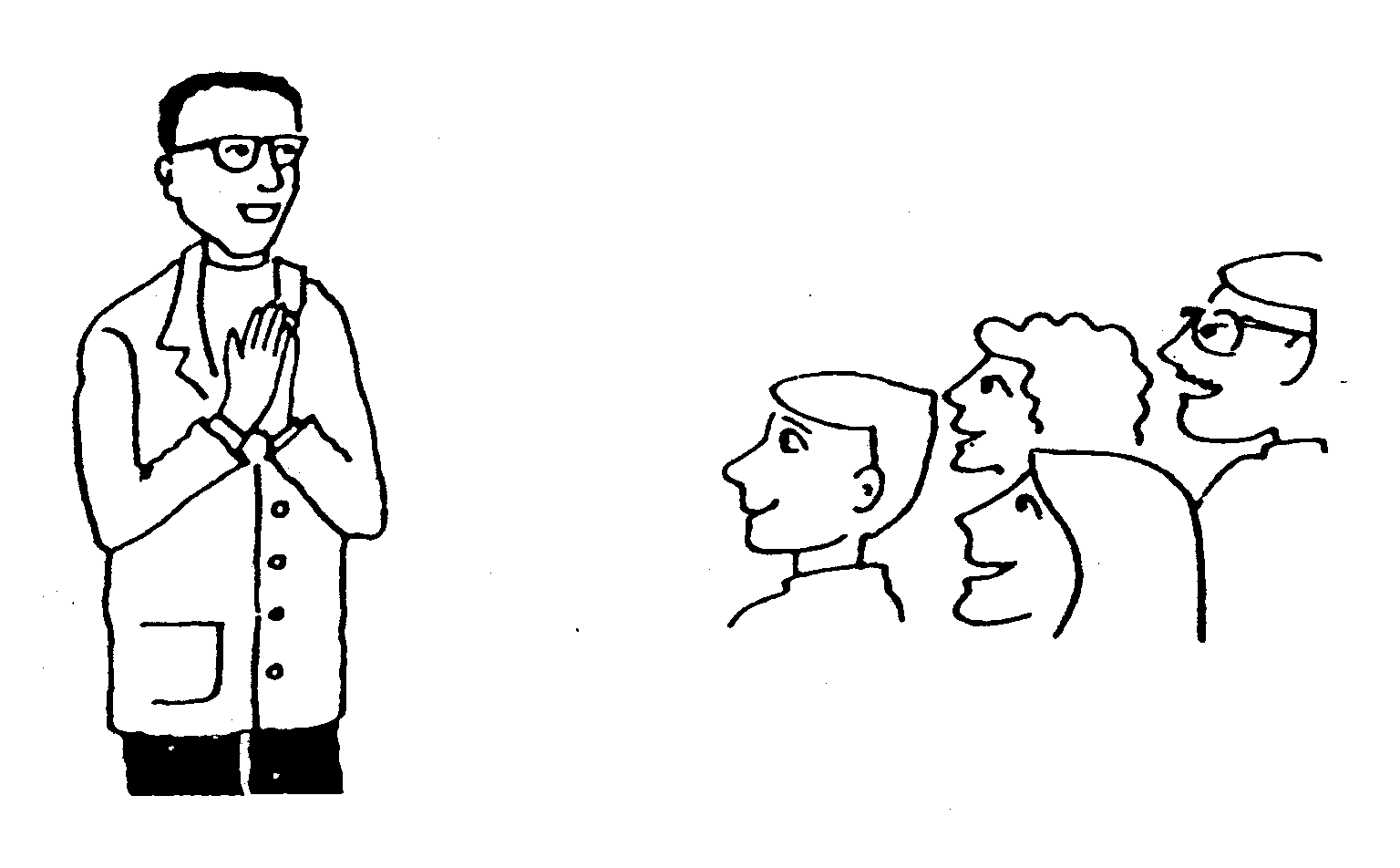
| I : | nəməskar, majhə: nav.... | Hello, My name is ... | |
| tumcə: nav kay? | What's your name? | ||
| S : | nəməskar, majhə: nav.... | Hello, my name is .... |
Break up into groups and introduce yourselves. Switch groups so that each of you gets a chance to meet all the others.
Variation
| I : | nəməskar, mi... | Hello, I'm .... | |
| tumcə: nav kay? | What is your name | ||
| S : | nəməskar, majhə: nav ... | Hello, my name is.... |
Repeat the earlier practice, first using the second pattern (mi...
The question tumcə nav kay?
Repeat the exercise above, using the familiar form of the question.
VOCABULARY
Greetings
Nouns
Possesive adjectives
Pronouns
Interrogative pronouns
2. Namaste, Are You John Greene?
A group of American students is at a reception in Pune, where they are going to meet their host families (their Indian 'parents'). Suresh Bapat is looking for John Greene, the student who will be staying in the Bapat home. He comes up to John.
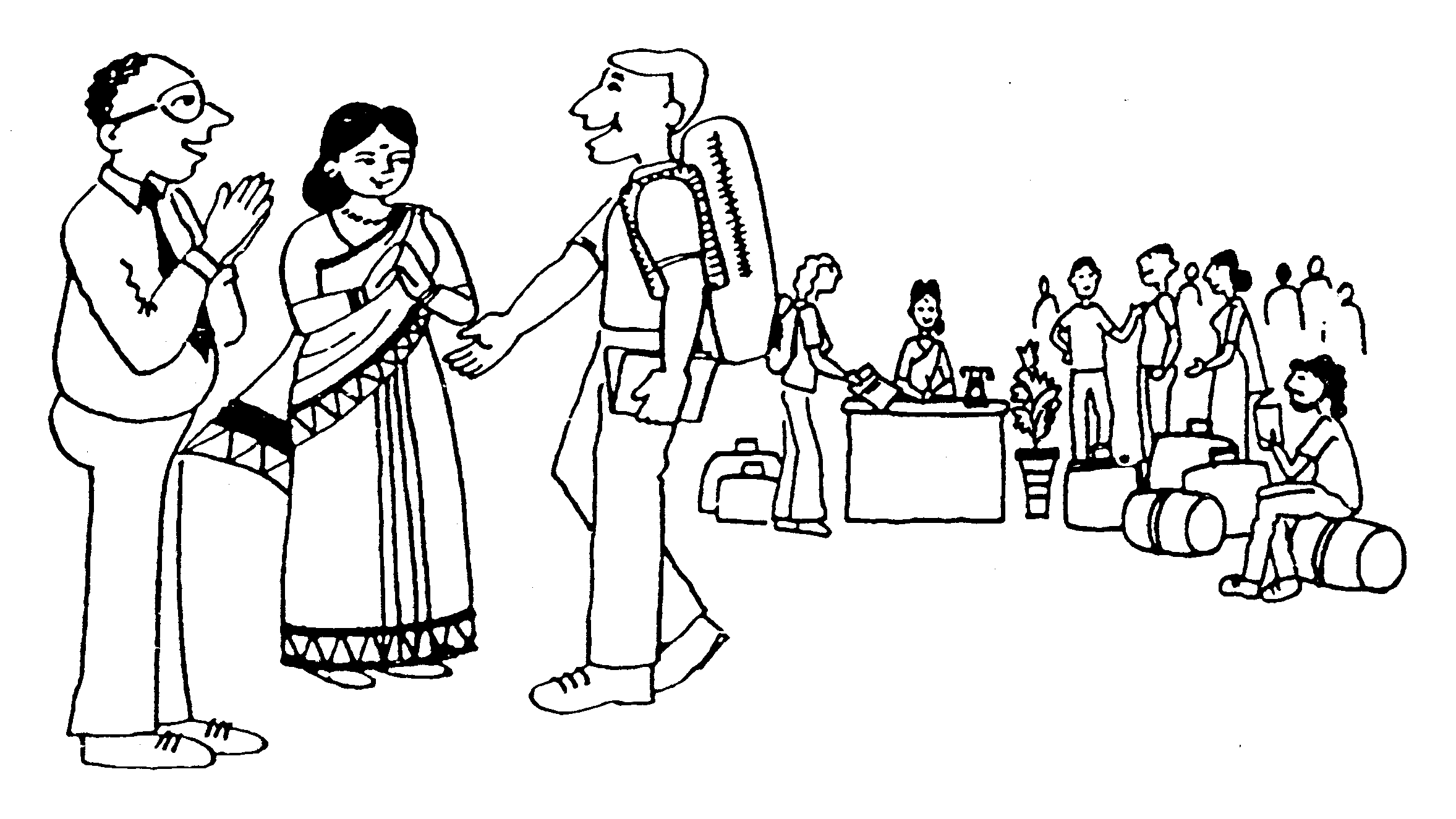
| Mr B : | nəməste, tumhi ǰɔn grin ka? | Hello, are you John Greene? | |
| J : | ho. | Yes. | |
| Mr B : | mi bapəṭ aṇi hi maǰhi bayko sunənda. | I'm Bapat, and this is my wife Sunanda. | |
| J : | nəməskar. | Namaskar. | |
| Ms B : | nəməskar. | Namaskar. |
This time is John who comes up to Mr. Bapat to introduce himself.
| J : | nəməskar. | Namaskar. | |
| B : | nəməste. | Namaste. | |
| J : | mi ǰɔn grin. tumhi bapəṭ ka?. | I'm John Green. Are you Mr. Bapat? | |
| B : | ho, mi bapəṭ, aṇi hi maǰhi bayko sunənda. | Yes, I'm Bapat, and this is my wife Sunanda. | |
| J : | nəməskar. | Namaskar. | |
| Ms.B: | nəməste. | Namaste. |
Repeat the preceding two conversations substituting Joan for John.
Mrs. Uma Pawar comes up to Debbie Smith.
| Ms P : | nəməskar, tumhi ǰeni fes ka? | Namaskar, are you Jenny Face? | |
| D : | nahi, mi ḍebi smith. hi ǰeni. | No, I'm Debbie Smith. This is Jenny. | |
| J : | nəməste. | Namaste. | |
| Ms P : | nəməskar, ǰeni mi uma pəvar ani he misṭər pəvar. | Namaskar Jenny. I'm Uma Pawar and this is Mr. Pawar. | |
| J : | nəməste. | Namaste. | |
| Mr P : | nəməskar. | Namaskar. |
Mrs. Pawar comes up to Jenny and Debbie.
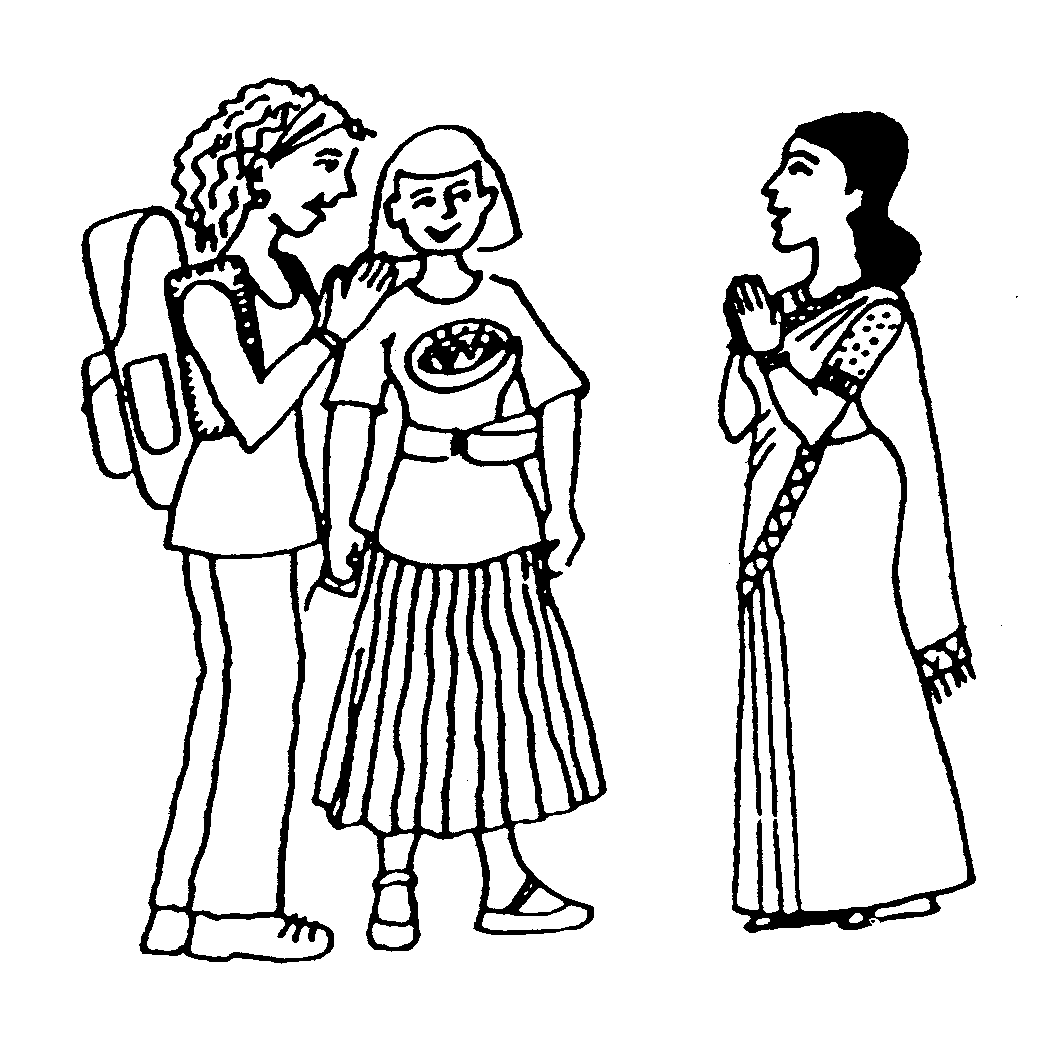
| Ms P : | nəməskar, tu ǰeni fes ka? | Namaskar, are you Jenny Face? | |
| J : | ho, mi ǰeni, aṇi hi maǰhi məitriṇ ḍebi smith. | Yes, I'm Jenny and this is my friend Debbie Smith. | |
| Ms P : | nəməskar. | Namaskar. | |
| D : | nəməskar. | Namaskar. |
To introduce a male friend, one can say
| ha majha mitrə. | This is my friend. |
a. Repeat the last two conversations substituting Johnny for Jenny and Bobby for Debbie.
b. Divide into groups of four to practice the exchanges covered so far. In each group two of you should assume the identity of Maharashtrians (either a couple or friends) while the other two of you should play yourselves. You may choose your Maharashtrian names from the list below. Following are some of the ways you can being.
| nəməskar, mi... | |
| tumhi... ka? | |
| nəməskar, majhə: nav... |
VOCABULARY
Greetings
Introductory affirmative / negative
Subject Pronouns
Nouns
Particles
Conjunctions
Names
Surnames
| bapəṭ | Bapat | |
| dešmukh | Deshmukh | |
| pəvar | Pawar | |
| kambe | Kamble | |
| joši | Joshi | |
| kakəḍe | Kakade |
Men's given names
| sureš | Suresh | |
| madhəv | Madhav | |
| dilip | Dilip | |
| ram | Ram | |
| rəmeš | Ramesh | |
| sunil | Sunil |
Women's given names
| sunənda | Sunanda | |
| uma | Uma | |
| ənuradha | Anuradha | |
| vəišali | Vaishali | |
| suləbha | Sulabha | |
| mina | Meena |
WORD STUDY
3. These Are Our Children
Arun Pawar introduces his children.
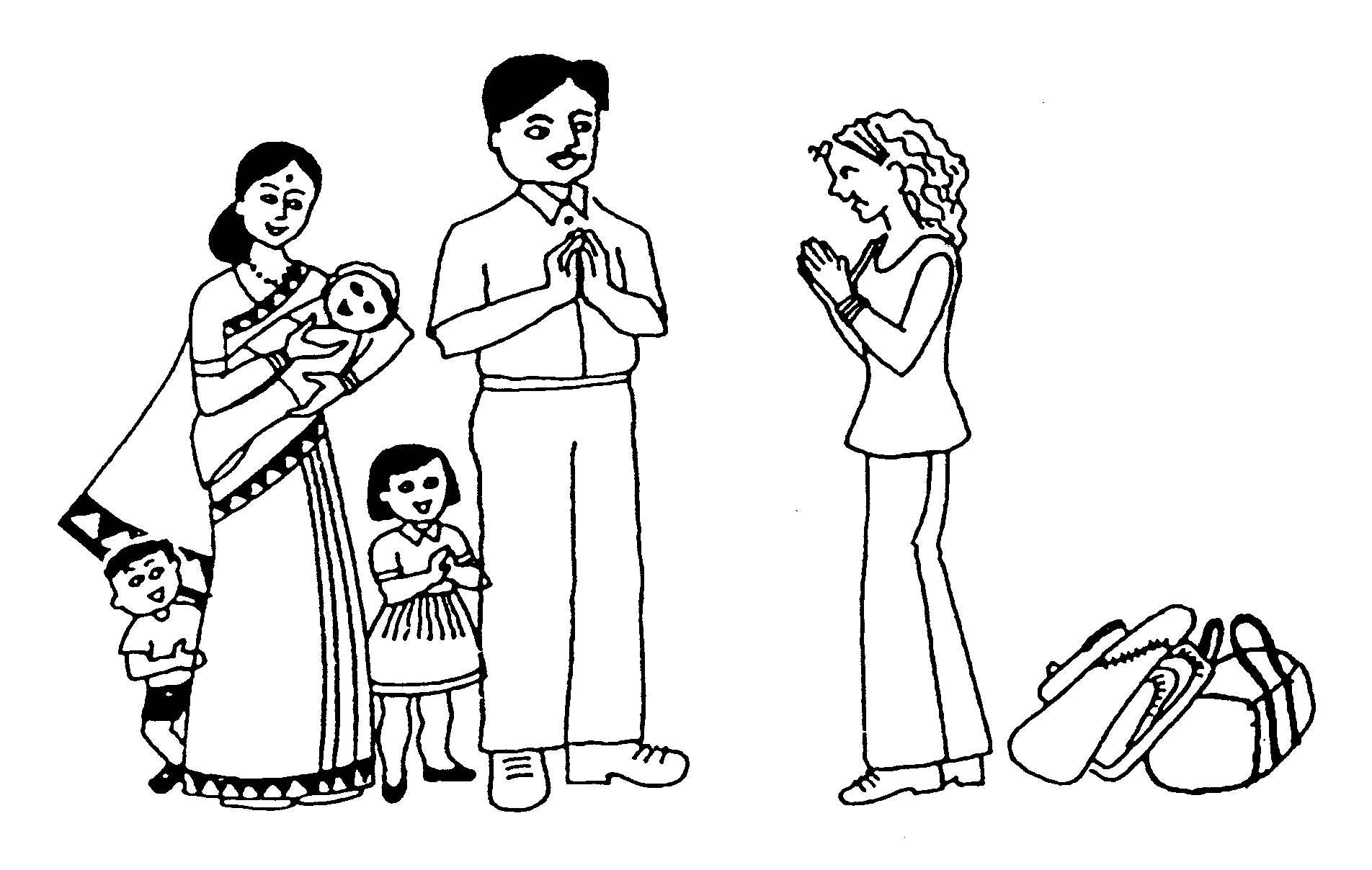
| hi amči mulə:. | These are our children. | |
| hi amči mulgi sunita. | This is our daughter Sunita. | |
| ha amca mulga səmir. | This is our son Samir. | |
| ani he amcə: ba. | And this is our baby. | |
| hyacə: nav rohən. | His name is Rohan. |
Take turns playing the role of Arun Pawar, pointing to the characters in the picture.
Jenny inquires about the children.
| J : | sunitacə: vəy kay? | How old is Sunita? ['Sunita's age is what?"] | |
| P : | sat vəršə:. | Seven Years. | |
| J : | səmircə: vəy kay? | How old is Samir? | |
| P : | pac varšə:. | Five years. | |
| J : | rohəncə: vəy kay? | How old is Rohan? | |
| P : | tin məhine. | Three months. |
Numbers 1 to 10
| ek | one | səha | six | ||
| don | two | sat | seven | ||
| tin | three | aṭh | eight | ||
| čar | four | nəu | nine | ||
| pac | five | dəha | ten |
Another student inquires about the Pawar children.
| S : | hi tumči mulgi ka? | Is this your daughter? | |
| P : | ho. | Yes. | |
| S : | ticə: nav kay? | What is her name? | |
| P : | sunita. | Sunita. | |
| S : | ha tumca mulga ka? | Is this your son? | |
| P : | ho. | Yes. | |
| S : | tyacə: nav kay? | What is his name? | |
| P : | səmir. | Samir. | |
| S : | he tumcə: ba ka? | Is this your baby? | |
| P : | ho. | Yes. | |
| S : | tyacə: nav kay? | What is his name? | |
| P : | rohən. | Rohan. |
Take turns assuming the role of the student and the role of Arun Pawar.
Pawar introduces his parents, sister, brother, and brother's wife.
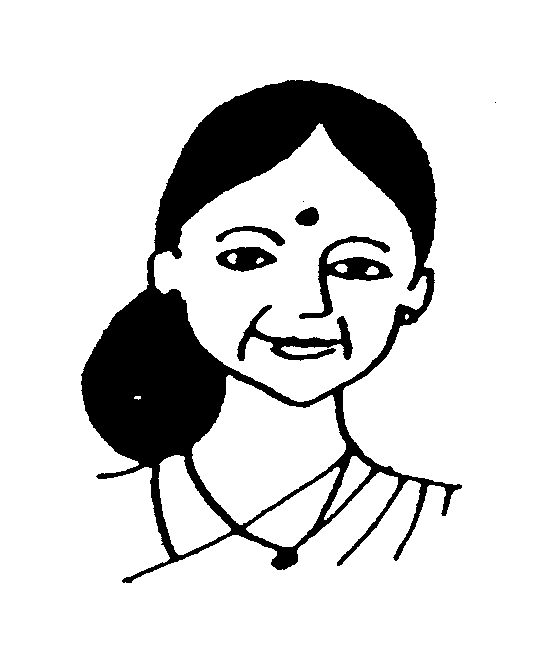 | 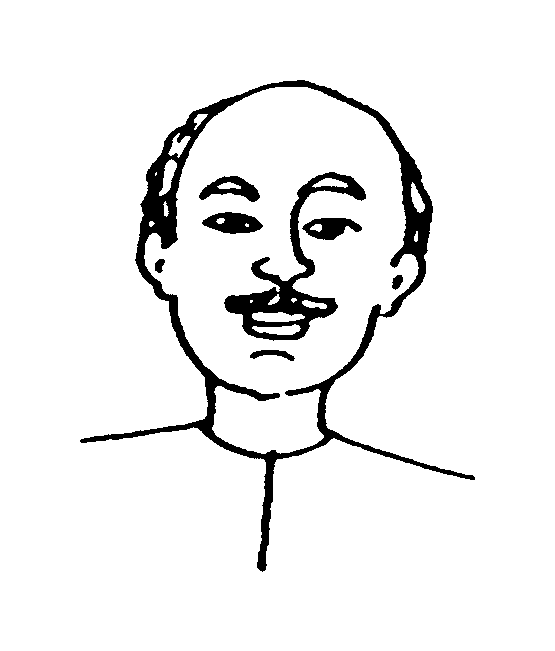 | 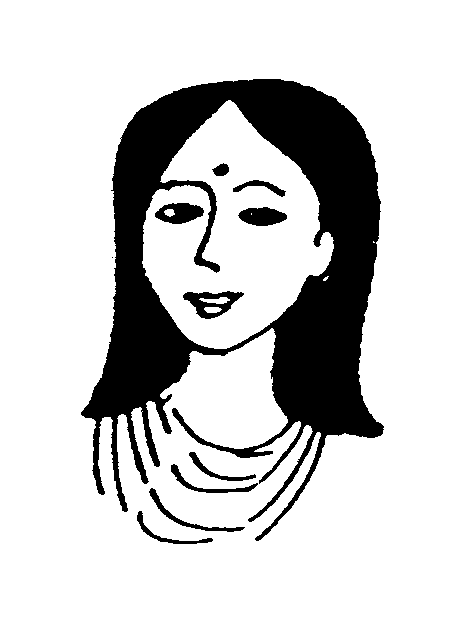 | 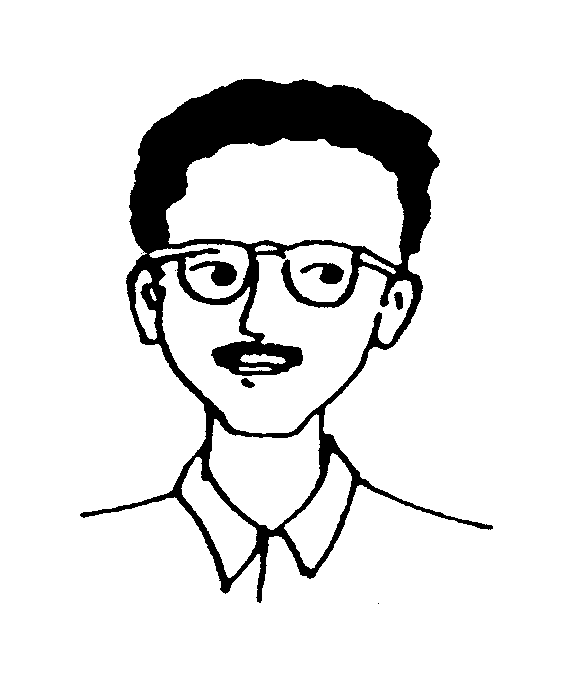 | 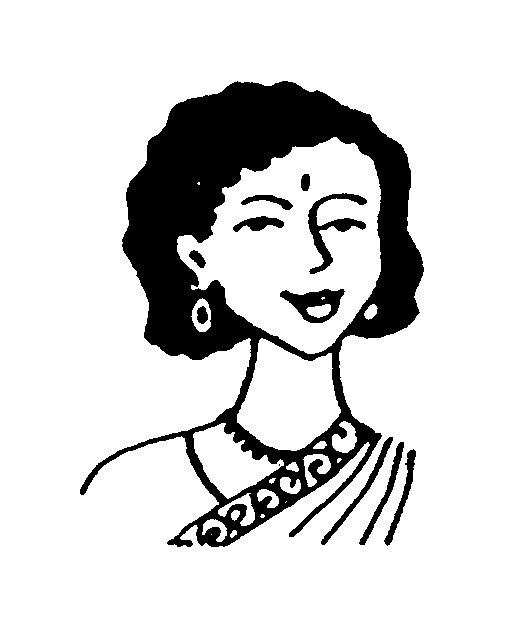 |
sundərabai (ai |
ramkṛšṇə (vəḍil | səvita (bəhiṇ | rəmeš (bhau | šubhaŋgi (vəhini |
| hi maǰhi ai. | This is my mother. | |
| hicə: nav sundərabai. | Her name is Sundarabai. | |
| aṇi he majhe vəḍil. | And this is my father. | |
| hyancə: nav ramkṛšṇə. | His name is Ramkrishna. | |
| hi maǰhi bəhiṇ. | This is my sister. | |
| hicə: nav səvita. | Her name is Savita. | |
| ha majha bhau rəmeš. | This is my brother Ramesh. | |
| aṇi hi maǰhi vəhini šubhaŋgi. | And this is my sister-in-law Shubhangi. |
Pawar and Jenny look at a family photo.
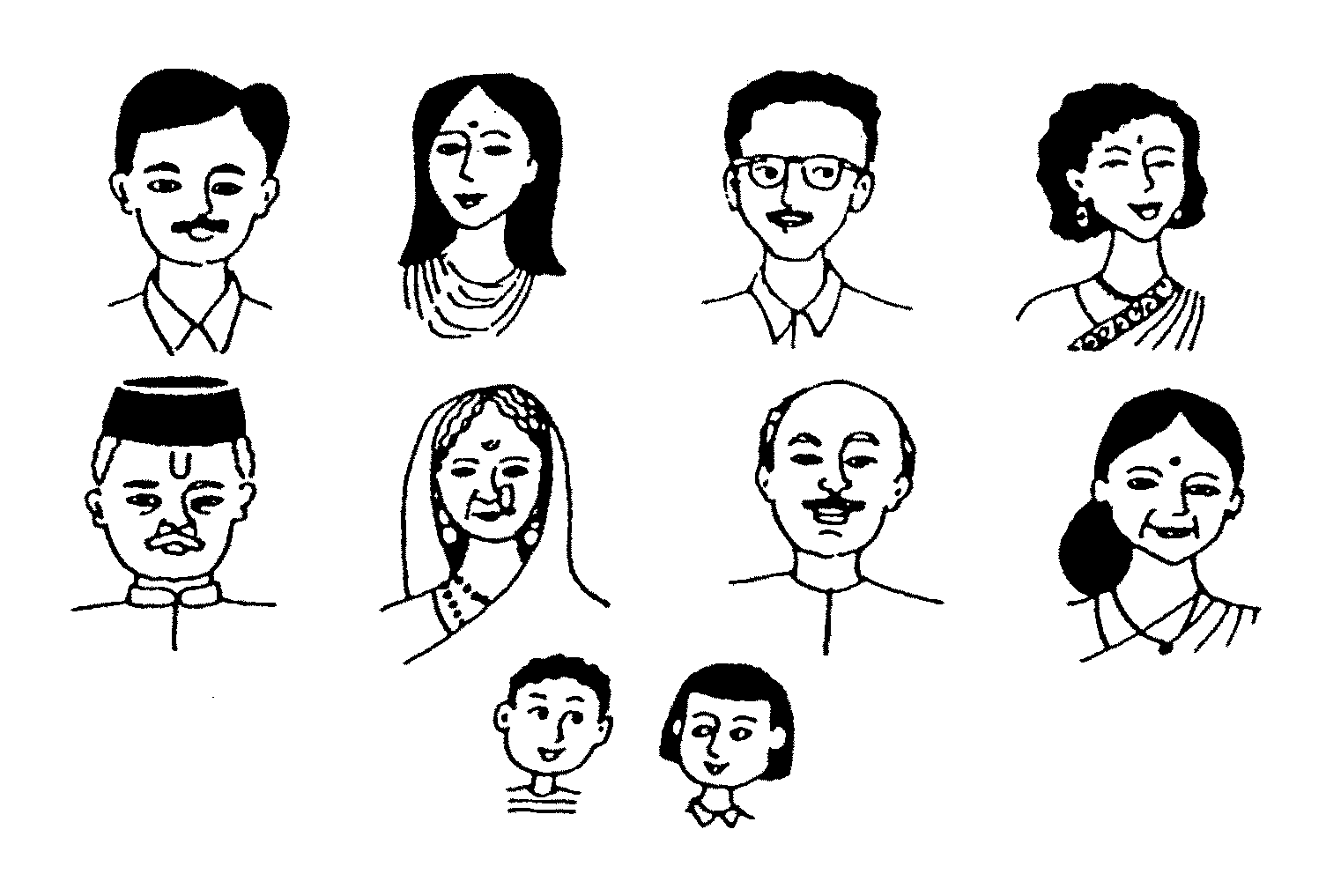
Take turns playing the role of Arun Pawar, pointing to the characters pictured above.
| P : | he amcə: kuṭumbə. | This is our family. | |
| J : | he koṇ? | Who is this? | |
| P : | te majhe ajoba. | That is my grandfather. | |
| J : | hya koṇ? | Who is this? | |
| P : | ti maǰhi aǰi. | That is our grandmother. | |
| J : | he koṇ? | Who is this? | |
| P : | te majhe vəḍil. | That is my father. | |
| J : | hya koṇ? | Who is this? | |
| P : | ti maǰhi ai. | That is my mother. | |
| J : | hi koṇ? | Who is this? | |
| P : | ti maǰhi bəhiṇ. | That is my sister. | |
| J: | ha koṇ? | Who is this? | |
| P : | to majha bhau. | That is my brother. | |
| J : | hi koṇ? | Who is this? | |
| P : | ti maǰhi vəhini. | That is my sister-in-law. (brother's wife). | |
| J : | hi koṇ? | Who are these? | |
| P : | ti amči mulə:. | Those are our children. |
a. Quiz each other, by turns assuming the role of Jenny and the role of Arun Pawar.
b. The following chart shows the relationships in the Pawar family. Using Arun as the reference point, review the kinship vocabulary covered in this chapter.
c. Using the chart, ask each other to identify each person by name. Below are sample questions.
| ha koṇ? | Who is this? | |
| tyacə: nav kay? | What is his name? | |
| hi koṇ? | Who is this? | |
| ticə: nav kay? | What is her name? | |
| he koṇ? | Who is this? | |
| hyancə: nav kay? | What is his name? | |
| hya koṇ? | Who is this? | |
| hyancə: nav kay? | What is her name? |
d. Have one person in each group assume the identity of Arun Pawar. The rest of you should ask him / her who each person in the chart is in relation to him / her.
e. Have one person in each group assume the identity of these other persons on the chart : Ramkrishna, Sundarabai, Ramesh and Savita. The rest of you should ask him / her who each of the others on the chart is, and how s / he is related to the person being questioned. See the Vocabulary for the extra words you will need.
f. Make a chart of your own family using photos or drawn figures on the pattern of "The Pawar Family" below. Label each person's relation with reference of you, using as many as are appropriate of the family and kinship terms you have learned so far. Then take turns introducing your family to the others in the class.
The Pawar Family
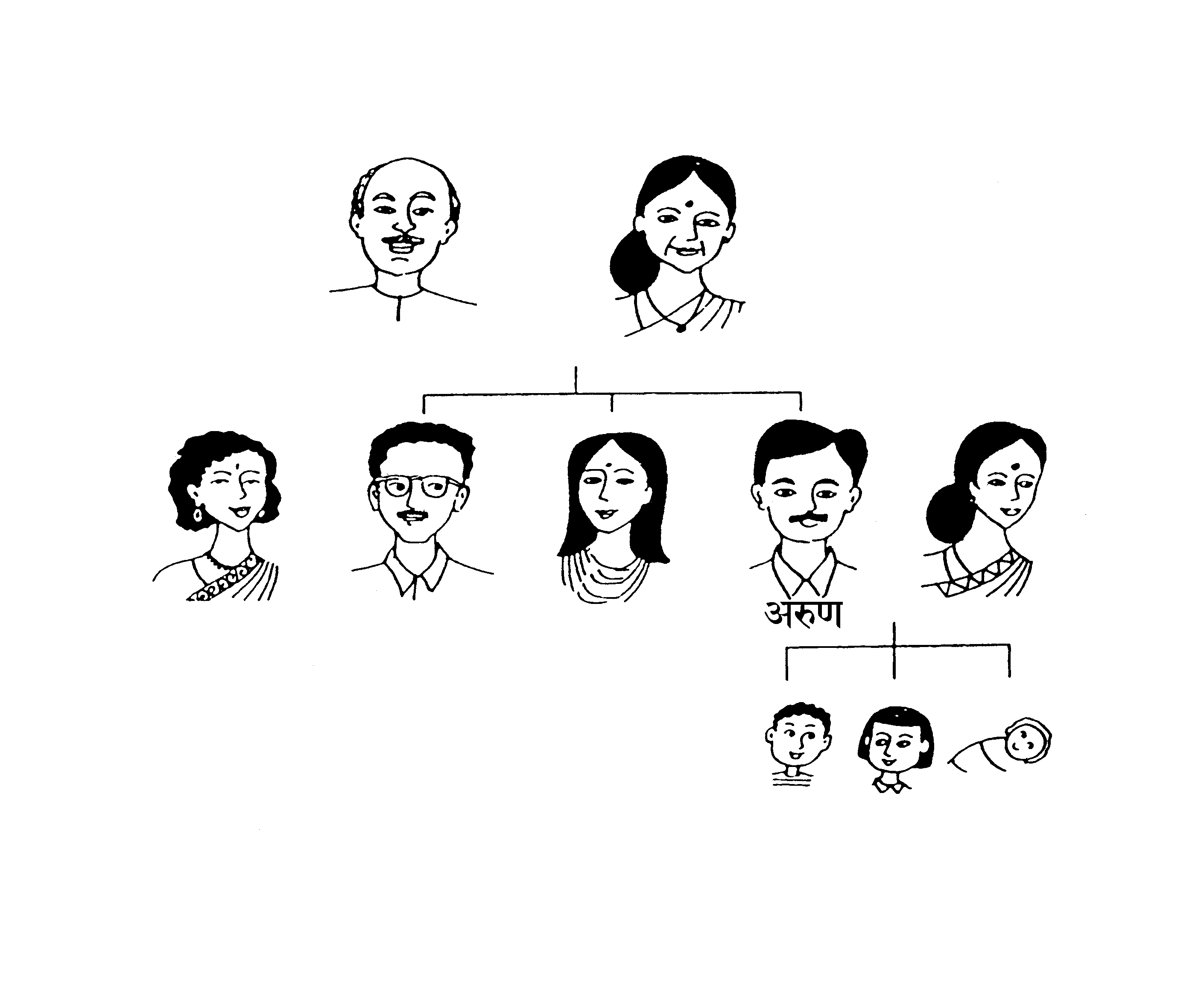
VOCABULARY
Numbers 1 to 10
| ek | one | |
| don | two | |
| tin | three | |
| čar | four | |
| pac | five | |
| səha | six | |
| sat | seven | |
| aṭh | eight | |
| nəu | nine | |
| dəha | ten |
Family and kinship terms
n. family
f. mother
m. father
m. brother
f. (i) sister
m., in pl., n. boy, son
n. child
f. girl, daughter
n. baby
f. brother's wife
f. grandmother
m. pl. grandfather
m. grandson
f.(i) granddaughter
f.(e) daughter-in-law
f.(i) niece, bother's daughter
m. nephew, brother's son
Subject Pronouns
Possessive adjectives
Other nouns
Interrogative pronouns
Names
Men's given names
| ramkṛšṇə | Ramkrishna | |
| əruṇ | Arun | |
| səmir | Samir | |
| rohən | Rohan |
Women's given names
| sundərabai | Sunderabai | |
| səvita | Savita | |
| sunita | Sunita | |
| šubhaŋgi | Shubhangi |
WORD STUDY
Note the name
CULTURAL NOTE
Many students wonder why we give so much importance to talking about the family early on in the course. Once in India, however, you will discover that life is family-centered, and knowledge of basic kinship terms is a must.
5. GRAMMAR
A) N N CONSTRUCTION
The sentences in this unit are almost without exception based on a single structure: N N. (N stands for 'noun'). The corresponding English sentences have the form 'N (be) N.'
| N | N | |||
| majhə: nav | bapəṭ | My name is Bapat. | ||
| mi | bapəṭ | I am Bapat. | ||
| hi | amči mulgi | This is our daughter. |
Note that the Marathi sentences above have no word meaning 'to be' (or copula, as it is technically termed). Only in limited contexts such as making introductions or showing photographs can the copula be omitted.
B) TYPES OF QUESTIONS
There are two basic types of questions found in Marathi (or, for that matter, any language) - those that use an interrogative word to ask for additional information, and those that merely require a 'yes' or 'no' answer. (In this book we will refer to the first as interrogative word questions and the second as yes-no questions.)
1. In Marathi a yes-no question is made by the adding
| tumhi ǰɔn grin. | Your are John Greene. | |
| tumhi ǰɔn grin ka? | Are you John Greene? |
2. An interrogative word question is formed by inserting the interrogative word in the place of the desired information.
| ha... | This is... | |
| ha koṇ? | Who is this? |
C) GENDER
Each Marathi noun has a gender masculine, feminine, or neuter. In some cases
the gender of the noun is consistent with natural gender. That is,
D) PERSONAL PRONOUNS
This unit has introduced a number of personal pronouns, though not the full set.
| mi | I | |
| tu | you (fam.) | |
| tumhi | you (resp.) | |
| ha | he, this (m.) | |
| hi | she, this (f.) | |
| he | this (n.) | |
| he | he (resp.) | |
| hya | she (resp.) | |
| hi | they, these (n.) | |
| to | he, that (m.) | |
| ti | she, that (f.) | |
| te | he (resp.) | |
| ti | they, those (n.) | |
| te | that (n.) | |
| tya | she (resp.) |
The pronoun system in Marathi is more complex than English because in addition to distinctions of person ('I', 'you', 'he'), number (singular, plural) and gender, Marathi also distinguishes between the respectful and familiar, the inclusive and exclusive 'we', and between proximate (near) and distant - which in English is retained only in the demonstrative pronouns: 'this', 'that' and 'these', 'those'. The pronoun system is discussed in detail in Unit Two. For a discussion of the use of the familiar and respectful, see the box later in this chapter.
E) POSSESSIVE ADJECTIVES
So far, the following possessives have been introduced:
| majhə: | my | |
| tumcə: | your | |
| tujhə: | your | |
| hyacə: | his | |
| hicə: | her | |
| hyancə: | his / her (resp.) | |
| tyancə: | his | |
| ticə: | her | |
| tyancə: | his / her (resp.) | |
| amcə: | our |
In Marathi, adjectives agree in gender and number with the nouns they modify. As possessives function as adjectives, they follow the same rules of agreement. The example below illustrates how majhe: changes according to the gender of the noun it modifies.
| majha mulga | majhe vəḍil | ||
| maǰhi mulgi | maǰhya aǰya | ||
| majhə: nav | maǰhi mulə: |
Certain nouns, such as vəḍil 'father' and ajoba 'grandfather' are generally used in the respectful, which is the same as the plural. (In fact, the essence of the respectful is using the plural in reference to a single person.)
| majhe vəḍil | my father | |
| tumčya ai | your mother | |
| tice ajoba | her grandfather |
The possessive adjective vowel endings are summarized in Table 1 below
TABLE 1. Possessive adjective endings
| M | F | N | |
| Singular | a | i | ə: |
| Plural | e | ya | i |
Example
| majha | majhə: | maǰhya | |||
| maǰhi | majhe | maǰhi |
Note that the j changes to ǰ when followed by i or ya. (In some people's speech the change also occurs when j is followed by e.)
Note also that given names (first names) can be turned into possessive adjectives
simply by adding the appropriate possessive ending: for example,
In Marathi, as in the other Indian languages and most European languages, the selection of pronouns in reference to persons depends not only on the person, number and gender of the person addressed or referred to, but on the speaker's social relationship to that person. This dimension is often referred to as that of respect, although this word does not adequately convey the complexity involved. It is more helpful to think of two parallel dimensions one of status and the other of social distance.*
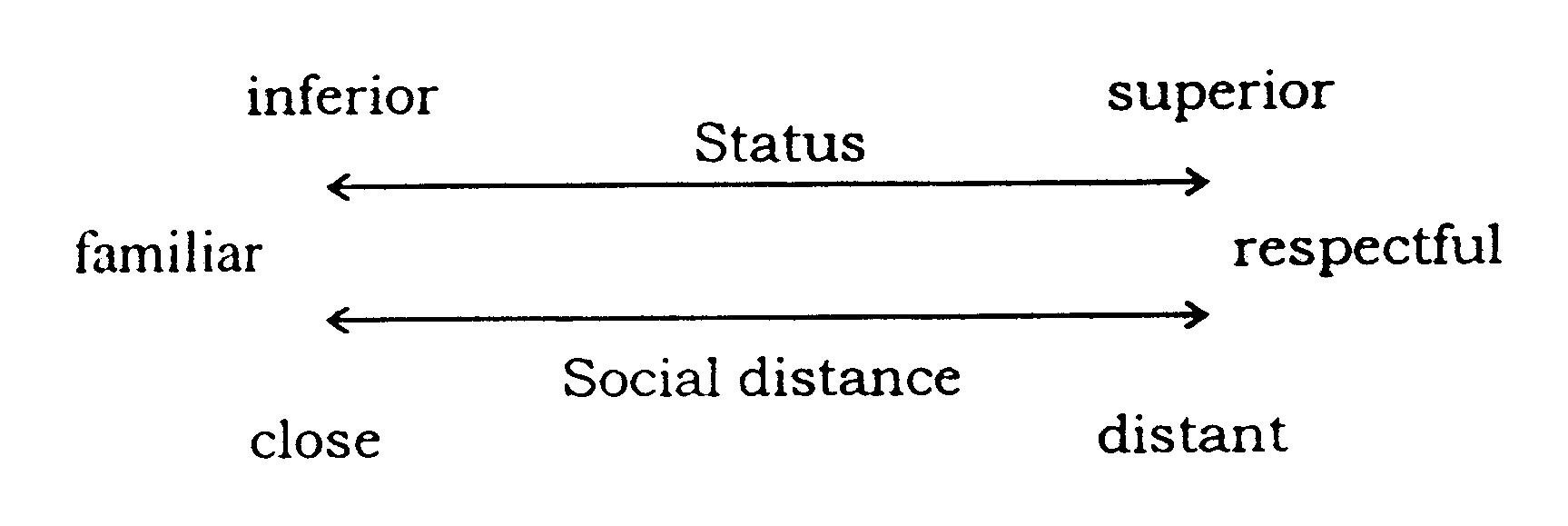 * For the concept of two parallel dimensions we are indebted to Brown and
Gilman's classic analysis of pronoun use in European languages. Our definition
of these dimensions, however, is somewhat different from that of the above
authors. See Roger W. Brown and A. Gilman, "The Pronouns of Power and
Solidarity" in Thomas A Seabeck (ed.), Style in Language (New York : Wiley;
Cambridge : Technology Press, 1960), pp. 253-276. Reprinted in Joshua A.
Fishman (ed.) Readings in the Sociology of Language (The Hague : Mouton,
1963), 252-276.
* For the concept of two parallel dimensions we are indebted to Brown and
Gilman's classic analysis of pronoun use in European languages. Our definition
of these dimensions, however, is somewhat different from that of the above
authors. See Roger W. Brown and A. Gilman, "The Pronouns of Power and
Solidarity" in Thomas A Seabeck (ed.), Style in Language (New York : Wiley;
Cambridge : Technology Press, 1960), pp. 253-276. Reprinted in Joshua A.
Fishman (ed.) Readings in the Sociology of Language (The Hague : Mouton,
1963), 252-276.
As we see from the diagram, respectful forms are used for those who are of superior social status or who are socially distant. Familiar forms are used for those who are of inferior status or socially close. If people are of the same status, only the dimension of social distance is applicable.
A full discussion of the use of the familiar and respectful will be given later. For the time being, keep in mind a few major points.
1. For addressing a person there are three levels of respect:
2. Most people refer to their father and grandfather in the respectful, and their mother and grandmother in the familiar. (The concept of two parallel dimensions suggests that while fathers and grandfathers are of superior status, they are also emotionally distant, while mothers and grandmothers are emotionally close. However, in referring to someone else's mother, one often uses the respectful.)
3. Children are addressed and referred to in the familiar.
4. Wives usually address and refer to their husbands in the respectful, while husbands use the familiar in addressing or referring to their wives. However, many couples reject the inequality implied in this usage, and address and refer to each other in the familiar.
5. Most students in larger cities address and refer to each other in the familiar. In rural areas students are more conservative, and tend to use the respectful except for close friends.
PATTERN PRACTICE
A. Practice using the pronouns
B. Answer the following questions as suggested. To test yourself, cover the Marathi answers.
| ha koṇ? | hi koṇ? | ||
| ( | ( | ||
| hya koṇ? | ha koṇ? | ||
| ( | ( | ||
| ha koṇ? | hi koṇ? | ||
| ( | ( | ||
| hi koṇ? | he koṇ? | ||
| ( | ( | ||
| ha koṇ? | hya koṇ? | ||
| ( | ( | ||
C. Repeat Exercise B,1-6, this time also asking the person's name, for example,
D. Select the form of
| ai | bəhiṇ | məitriṇ | vəḍil | ||||
| mulga | mitrə | bayko | ajoba | ||||
| bhau | nav | mulgi |
E. Using the words in exercise C, make statements of the pattern
F. Using the words in exercise C, make questions of the pattern
G. Translate the following sentences into Marathi.
1. I am .... (name).
2. My name is ....
3. Is this your brother?
4. No, he is my friend.
5. This is my friend ...
6. This is my father.
7. His name is ...
8. This is my mother.
9. Her name is ...
10. Is this your son?
Unit Two
Identifying Persons
and Places
6. Let's Look At Some Maps
Your instructor points to a map of the world.
| I: | apəṇ nəkaše bəghu ya. | Let's look at some maps. | |
| ha ǰəgaca nəkaša ahe. | This is a map of the word. |
ǰəg
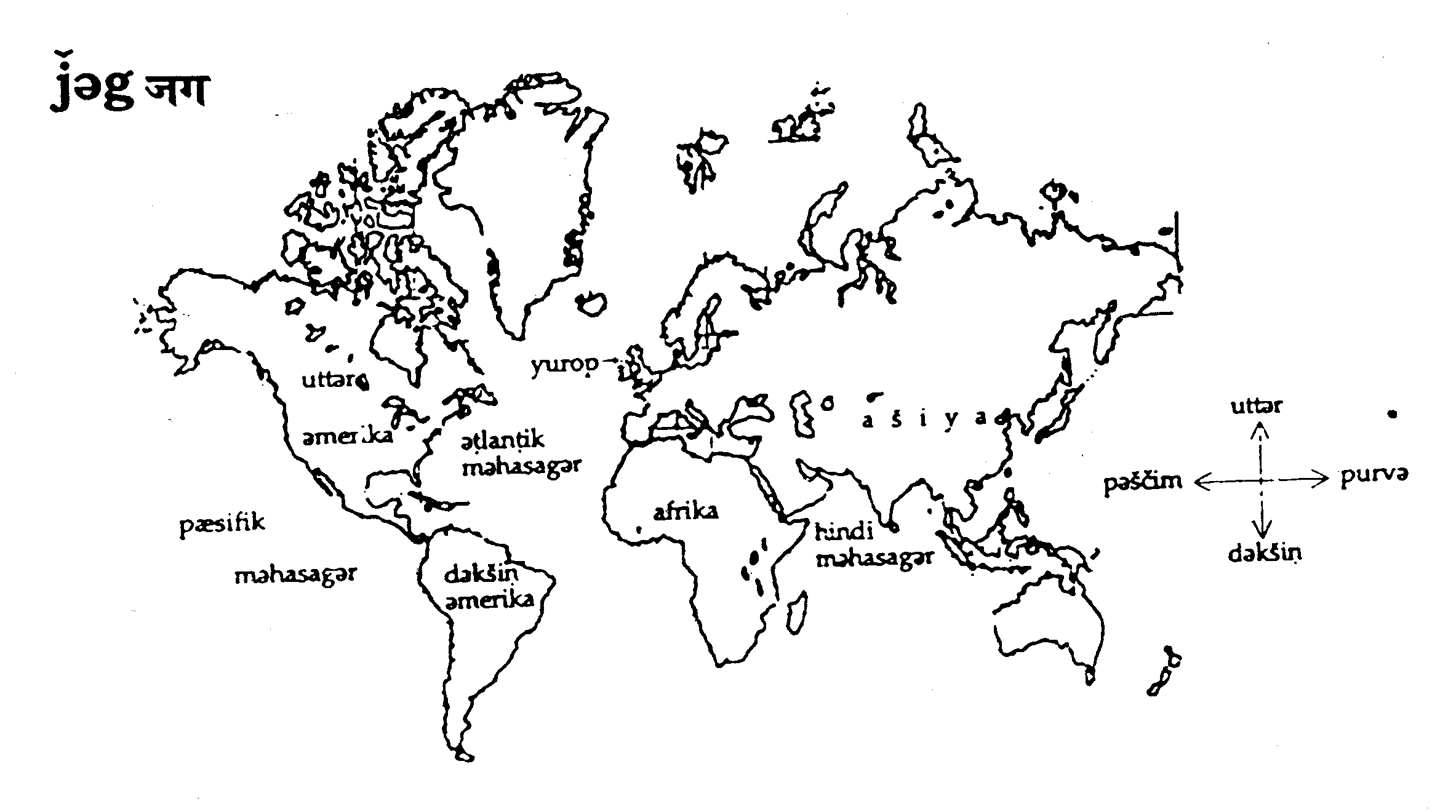
| uttər əmerika, dəkšiṇ əmerika, yurop, ašiya afrika he khəṇḍə ahet. | North America, South America, Europe, Asia, Africa, [these] are continents. |
| I : | ətlæṇṭik, pæsifik he məhasagər ahet. | The Atlantic and Pacific are oceans. | |
| hindi məhasagər kuṭhe ahe? | Where is the Indian Ocean? | ||
| S : | ithe ahe. | Here it is. | |
| I : | yunayəṭeḍ sṭeṭs, iŋgləṇḍ, frans, ǰərməni, braǰhil, jəpan, bharət he deš ahet. | The United States, England, France, German, Brazil, Japan and India are countries. | |
| bharat kuṭhe ahe? | Where is India? | ||
| S : | ithe ahe. | Here it is. | |
| I : | nyu yɔrk, šikɔgo, ləṇḍən, pæris, bərlin, rio de Jæniro, ṭokiyo, dilli hi šəhərə: ahet. mumbəi kuṭhe ahe? | New York, Chicago, London, Paris, Berlin, Rio de Janerio, Tokyo, Delhi are cities. Where is Mumbai? | |
| S : | ithe ahe. | Here it is. | |
| I : | ha koṇta khəṇḍa ahe? | Which continent is this? | |
| S : | ašiya | Asia. | |
| I : | ha koṇta deš ahe? | Which country is this? | |
| S : | bharət | India. | |
| I : | he kontə: šəhər ahe? | Which city is this? | |
| S : | puṇe | Pune. |
Take turns pointing of features of the world map. Here are some useful questions.
| ...kuṭhe ahe? | Where is....? | |
| ha koṇta khəṇḍə ahe? | Which continent is this? | |
| ha koṇta məhasagər ahe? | Which ocean is this? | |
| ha koṇta deš ahe? | Which country is this? | |
| he koṇtə: šəhər ahe? | Which city is this? | |
| he / ha ... ahe ka? | Is this.....? |
Your instructor points to a physical map of India.
| I : | ha bharətača nəkaša ahe. | This is map of India. |

Your instructor points to a political map of India.
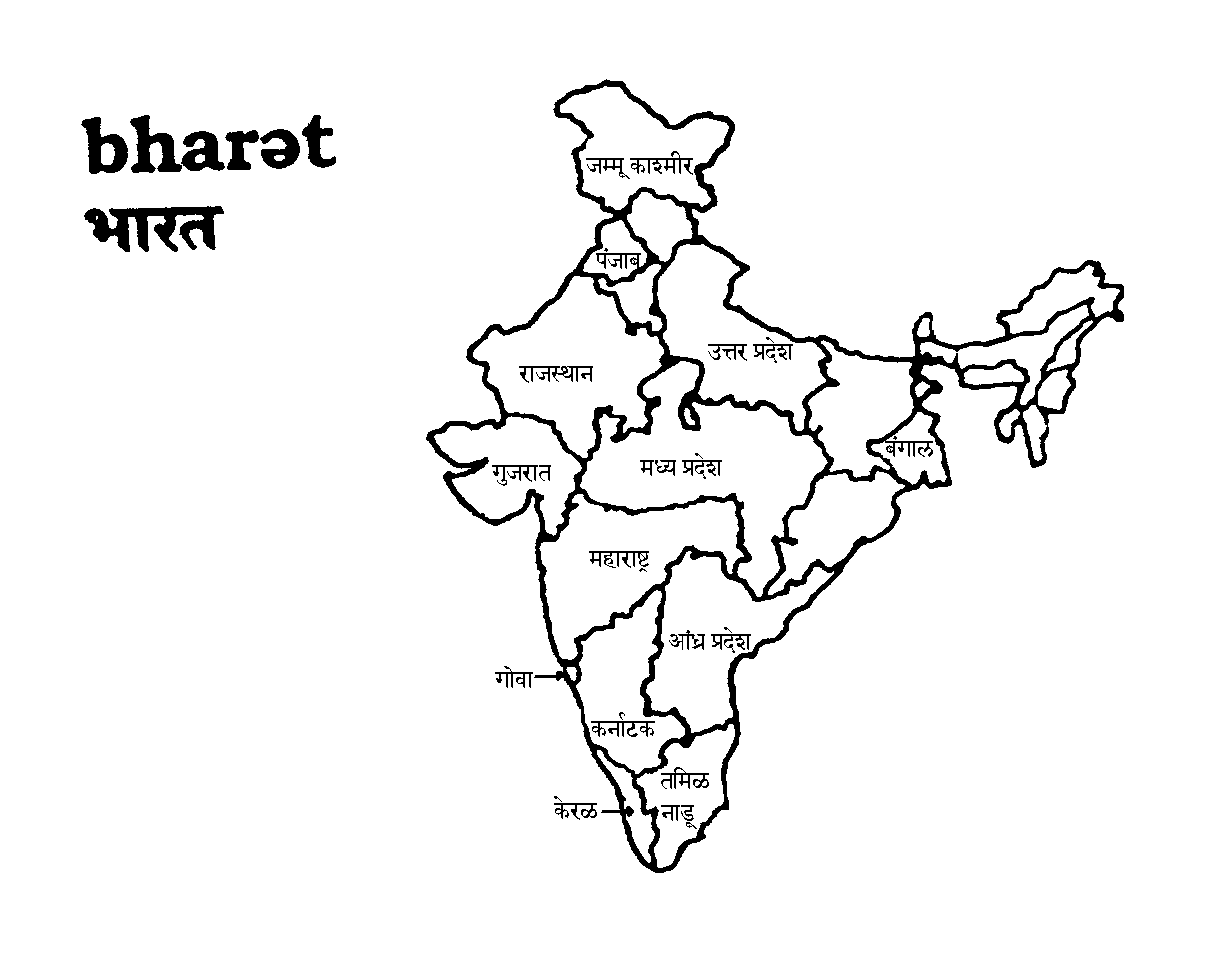 bharət bharət | I: ata apəṇ bharətači kahi raǰyə: bəghu ya. Now let us look at some of the states of India ['India's states'] |
| ha məharašṭrə ahe. | This is Maharashtra. | ||
| ha uttər prədeš, raǰəsthan, ǰəmmu Kašmir, pənǰab, bəŋgal, andhrə prədeš, taminaḍu, kerə, gova, gujərat, mədhya prədeš. | This is Uttar Pradesh, Rajasthan, Jammu Kashmir, Punjab, Bengal, Andhra Pradesh, Tamilnadu, Kerala, Goa, Gujarat, Madhya Pradesh. | ||
| he koṇtə: raǰyə ahe? | Which states this? | ||
| S : | kərnaṭək. | Karnataka. |
I:ata apəṇ mukhyə šəhərə: bəghu ya. Now let us look at the principal cities. | 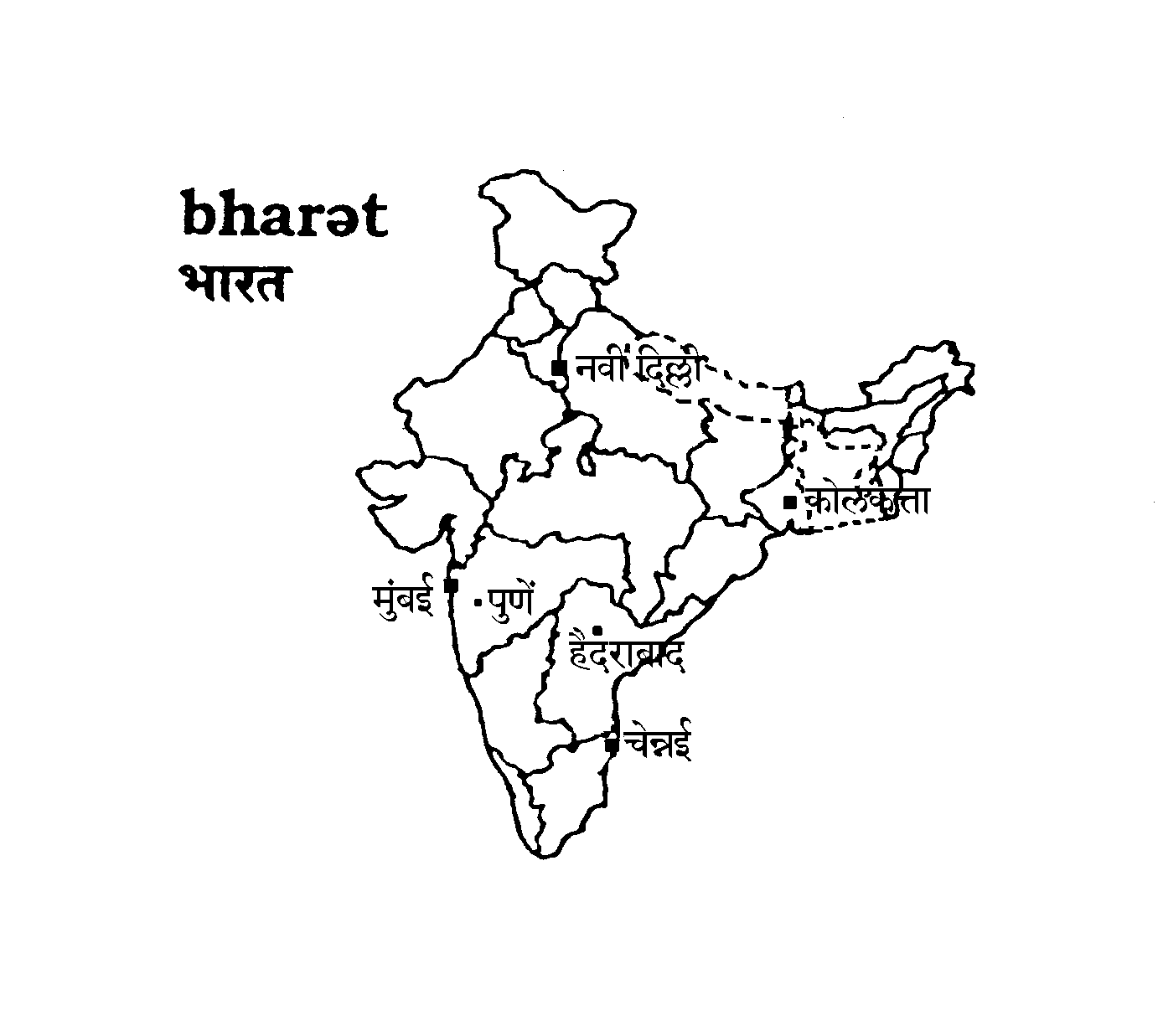 bharət bharət |
| hi nəvi dilli ahe. | This is New Delhi. | ||
| nəvi dilli hi bharətači raǰdhani ahe. | New Delhi is India's capital. | ||
| hi mumbəi ahe. | This is Bombay. | ||
| he kəlkətta ahe. | This is Calcutta. | ||
| hi čennəi ahe. | This is Chennai (Madras). | ||
| he həidərabad ahe. | This is Hyderabad. | ||
| puṇe kuṭhe ahe? | Where is Pune? | ||
| S : | ithe ahe. | Here it is. |
a. Take turns pointing to features on the maps of India. Here are some useful questions.
| ... kuṭhe ahe? | Where is... ? | |
| hi koṇti nədi ahe? | Which river is this? | |
| he koṇtə: raǰyə ahe? | Which state is this? | |
| he koṇtə: šəhər ahe? | Which city is this? |
b. Locate the following.
| ərəbi səmudrə | məharašṭrə | ||
| bəngalča upəsagər | rajəsthan | ||
| himaləy | kerə | ||
| gənga | nəvi dilli | ||
| godavəri | kolkatta |
c. Match the city with the state in which it is located.
| kolkətta | taminaḍu | ||
| həidrabad | məharašṭrə | ||
| čennəi | bəŋgal | ||
| mumbəi | raǰəsthan | ||
| puṇe | andhrə prədeš |
Your instructor points to a map of Maharashtra.
| ata məharašṭrača nəkaša bəghu ya. | Now let us look at a map of Maharashtra. |
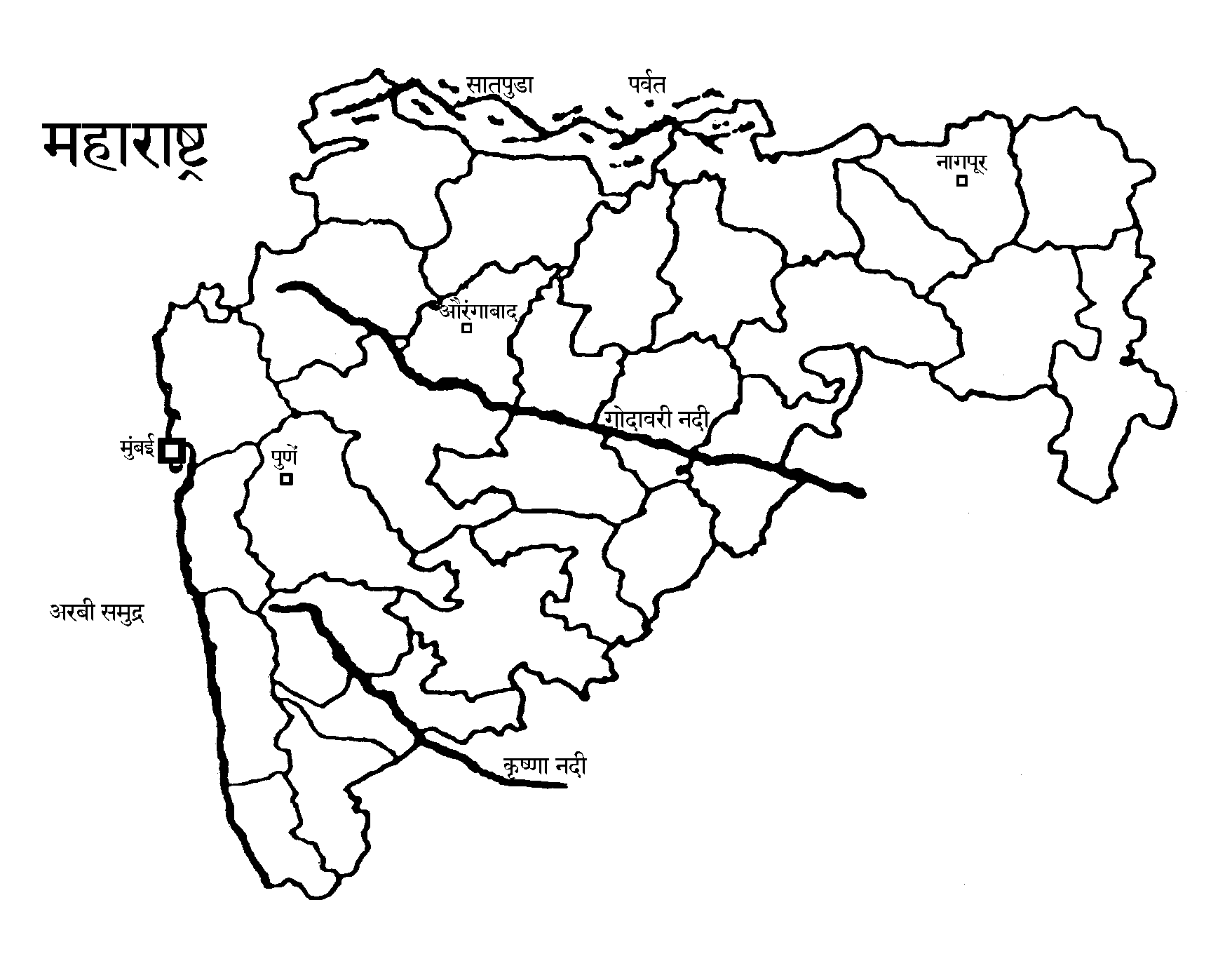
| hi məharašṭrači mukhyə šəhərə: ahet. | These are the main cities of Maharashtra. | |
| hi mumbəi ahe. | This is Bombay. | |
| he puṇe ahe. | This is Pune. | |
| he əurəŋgabad ahe. | This is Aurangabad. | |
| he nagpur ahe. | This is Nagpur. |
a. Locate the following on a map of Maharashtra.
| mumbəi | satpuḍa pərvət | ||
| puṇe | godavəri | ||
| əurəŋgabad | kṛšṇa | ||
| nagpur | səhyadri pərvət |
b. Get a map of the United States and talk about it. Point out directions, oceans, mountains, rivers, states, and cities, using the question you have learned.
c. Answer the following questions.
| šikɔgo he raǰyə ahe ka? | |
| viskɔnsin he šəhər ahe ka? | |
| bharətači raǰdhani kay? | |
| əmerikeči raǰdhani kay? | |
| andrə prədeš ha deš ahe ka? | |
| məharašṭrə he šəhər ahe ka? | |
| məharašṭrači mukhyə šəhərə: koṇti? | |
| məharašṭračya mukhyə nədya koṇtya? |
VOCABULARY
NOUNS
Directions
Place names
Continents
Oceans
Countries
Foreign Cities
Geographical features of India
Rivers of India
States of India
Cities of India
Cities of Maharashtra
Subject pronouns
Verbs
Adverbs
Interrogative adverbs
Adjectives
Interrogative adjectives
WORD STUDY
The name of Bombay was officially changed to Mumbai in 1996. Since then Madras has been changed to Chennai, and very recently Calcutta has been changed to Kolkatta.
7. Are you American?
A Maharashtrian casually encounters an American student.
| M : | tumhi əmerikən ahat ka? | Are you American? | |
| As : | ho, mi əmerikən ahe. | Yes, I'm American. | |
| M : | tumcə: gav koṇtə:? | What town are you from? [Your town is which?] | |
| AS : | majhə: gav .... | I'm from .... [My town is ....] |
This time the American student initiates the conversation.
| AS : |
| tumhi məraṭhi ahat ka? | Are you Maharashtrian? |
| M : | ho, mi məraṭhi ahe. | Yes, I'm Maharashtrian. | |
| AS : | tumčə: gav koṇtə:? | What town are you from? | |
| M : | mi puṇyaca / puṇyači ahe. | I'm from Pune. |
VARIATIONS
| M : | 1. | tumhi kuṭhle / kuṭhəlya? | Where are you from |
| AS : | mi əmerikən ahe. | I am American. | |
| M : | 2. | tumhi ǰəmən ahat ka? | Are you German? |
| AS : | nahi, mi əmerikən ahe. | No, I am American. | |
| M : | 3. | tumca deš koṇta? | What country are you from? [Your country is which?] |
| AS : | amhi əmerikən ahot. | We are American. | |
| AS : | 4. | tumcə: gav koṇtə:? | Where are you from? |
| M : | amhi puṇyace ahot. | We are from Pune. |
Of course, not everyone you meet will be from Pune. Here is how people from other cities and towns will tell you where they are from.
| mumbəica / mumbəiči | from Bombay | |
| nagpurca / nagpurči | from Nagpur | |
| əur əngabadca / əurəngabadči | from Aurangabad | |
| kolhapurca / kolhapurči | from Kolhapur | |
| sataryaca / sataryači | from Satara | |
| solapurca / solapurči | from Solapur |
a. Locate Kolhapur, Satara, and Solapur and enter them on your map of Maharashtra.
b. Break up into groups. In each group each person should drawn an identity card. Find our where each of you is from.
National and Regional Identity
| bharətiyə | Indian | |
| frenč | French | |
| ǰəpani | Japanese | |
| čini | Chinese | |
| gujərati | Gujarati | |
| tamii | Tamilian | |
| pənǰabi | Punjabi | |
| bəŋgali | Bengali | |
| məharašṭriyə | Maharashtrian | |
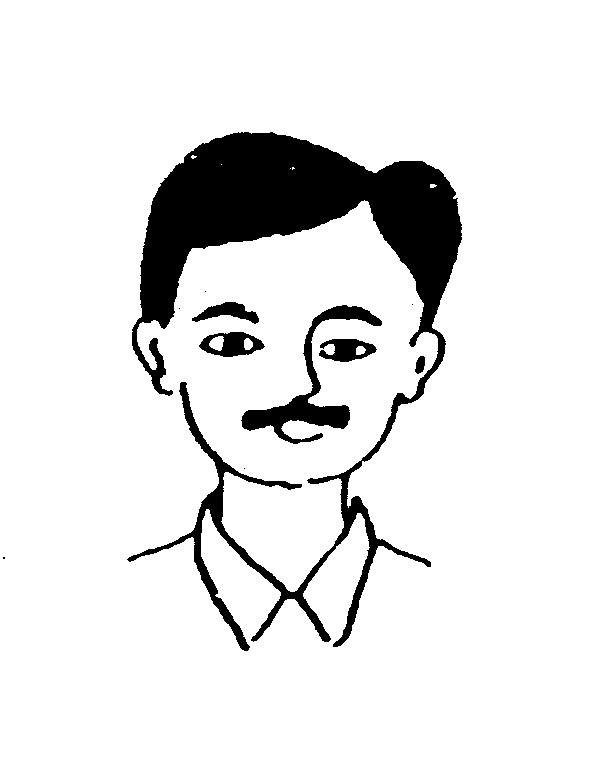 | ha koṇ? ha əruṇ pəvar. to bharətiyə ahe. to məharašṭriyə ahe. tyacə: gav puṇe | |
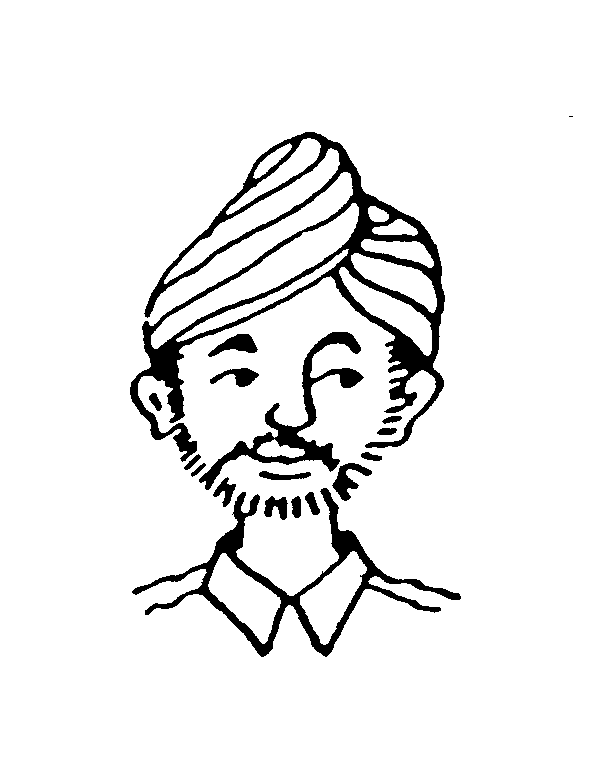 | ho koṇ? ha surǰit siŋ. to bharətiyə ahe. to pənǰabi ahe. tyacə: gav əmṛṭsər. |
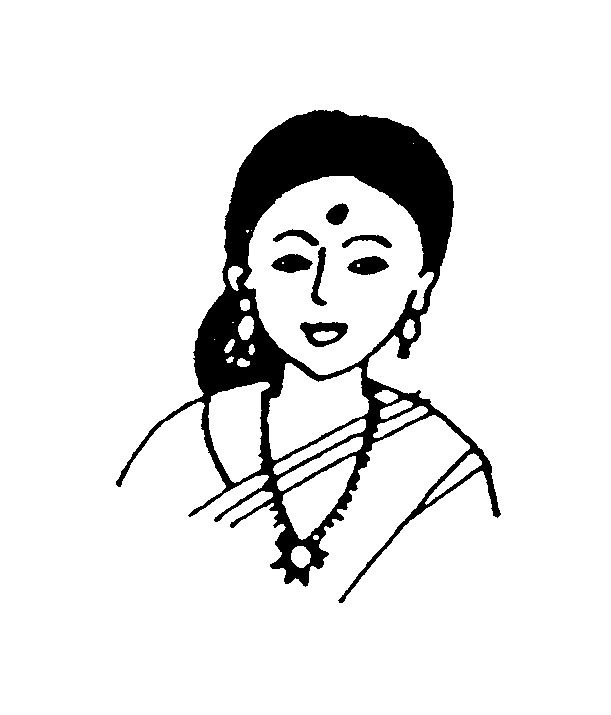 | hi koṇ? hi e. bi. sita. ti bharətiyə ahe. ti tamii ahe. ticə; gav čennəi. | |
| he koṇ? he profesər bhəṭṭačaryə. te bharətiyə ahet. te bəŋgali ahet. tyancə: gav kəlkətta. | 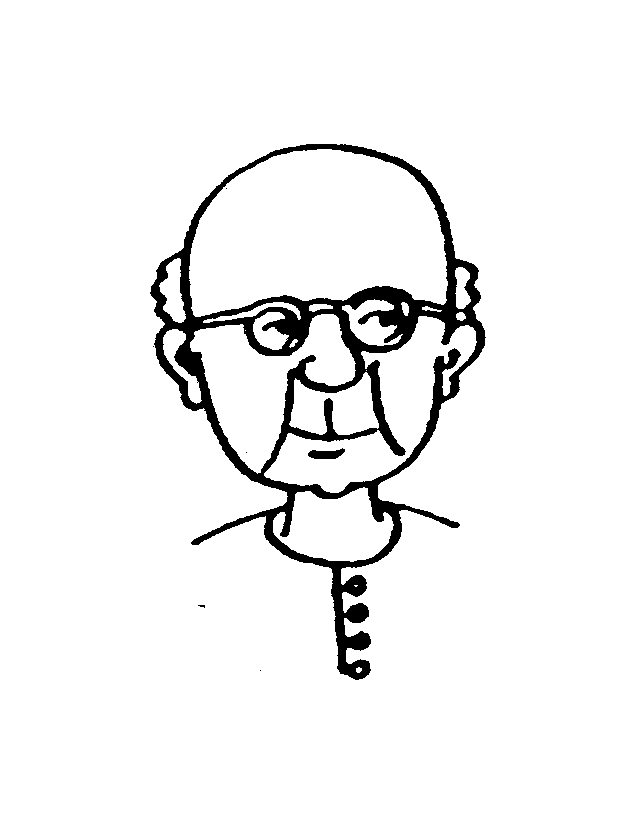 | |
| hya koṇ? hya ḍɔkṭər lila šərma. tya bharətiyə ahet. tya dilličya ahet. | 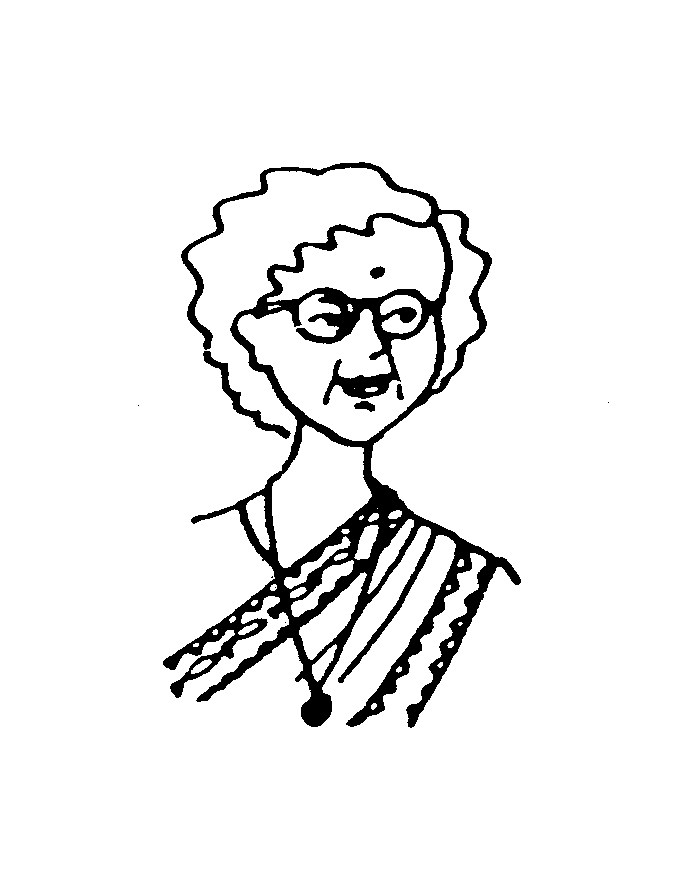 | |
 | he koṇ? he profesər yamamoto. te bharətiyə nahit. te ǰəpani ahet. tyancə: gav ṭokiyo. | |
 | hi koṇ? hi čeŋ tai phu. ti bharətiyə nahi. ti čini ahe. ticə: gav hoŋ koŋ. |
a. Take turns asking each other about the seven characters above. For example:
| ha koṇ? | |
| ha surǰit siŋ. | |
| to bharətiyə ahe ka? | |
| ho, to bharətiyə ahe. | |
| to gujərati ahe ka? | |
| nahi, to pənǰabi ahe. | |
| tyacə: gav koṇtə:? | |
| tyacə: gav əmṛitsər. |
b. Each one in your group should assume the identity of one the seven characters above. Then ask each other in turn about his / her national and regional identity. For example.
| nəmaste, mi surǰit siŋ. | |
| tumhi bharətiyə ahat ka? | |
| ho, mi bharətiyə ahe. | |
| tumhi gujərati ahat ka? | |
| nahi, mi pənǰabi ahe. | |
| tumcə: gav koṇtə:? | |
| majhə: gav əmrtsər. |
Basic Human Identity
| əruṇ pəvar, surǰit siŋ sita, profesər bhəṭṭačaryə aṇi ḍɔkṭər lila šərma he bharətiyə ahet. | Arun Pawar, Surjit Singh, Sita, Professor Bhattacharya and Dr. Lila Sharma are Indian. | |
| profesər yamamoto ǰəpani ahet. | Prof. Yamamoto is Japanese. | |
| čeŋg tai phu čini ahe. | Cheng Tai-fu is Chinese. | |
| ti səgəi maṇsə: ahet. | They are all human beings. | |
| surǰit siŋ puruš ahe. | Surjit Singh is a man. | |
| sita bai ahe. | Sita is a woman. | |
| ti maṇsə: ahet. | They are human beings. | |
| mi stri ahe. | I am a woman. | |
| tu puruš ahes. | You are a man. | |
| apəṇ maṇsə: ahot. | We are human beings. |
a. Talk about the characters introduced in this chapter and earlier in this book, mentioning regional and national identity, gender and basic human identity.
b. Describe yourself and each other in the same terms.
VOCABULARY
Adjectives
Nouns
Adjective
Subject pronouns
Verbs
Place names
Names
Men's given names
Women's given names
Surnames
GRAMMAR NOTES
1.
2.
3. In sentences such as
4. Note that in the feminine ending
5. Some place name (and most common nouns) require a special form (called the oblique form) before an ending is added, e.g:
| puṇe | puṇyaca | bharət | bharətaca | ||||
| satara | sataryaca | məharašṭrə | məharašṭraca |
WORD STUDY
1. There is some ambiguity in the use of the word
2.
3. For 'Maharashtrian' educated speakers say
8. Do You Know Marathi?
Again a Maharashtrian casually encounters an American student.
| M : | tumhala məraṭhi yetə: ka? | Do you know Marathi? | |
| A : | ho, (məla) thoḍəsə: yetə:. | Yes, a little. | |
| M : | əre va! (tumhi) kuṭhe šiklat? | Very good! Where did you learn it? | |
| A : | əmeriket. | In America | |
| M : | kiti divəs šiklat> | How long ['How many days'] did you study? | |
| A : | dəha aṭhəvḍe. | Ten weeks. |
Variation
| M : | tumhi məraṭhi bolta ka? | Do you speak Marathi | |
| A : | ho, (mi) thoḍəsə: bolto / bolte | Yes [I] speak, a little. |
The Maharashtrian asks next if the American student knows Hindi too.
| M : | tumhala hindi pəṇ yetə: ka? | Do you know Hindi too? | |
| A : | nahi, məla yet nahi. | No, I don't know [it]. |
a. Practice these conversations in pairs, using the original conversation and the suggested variations.
b. Ask about your partner's knowledge of other languages (see vocabulary) and how well s / he knows them. Here are some sentences you may want to use.
| məla pharsə: yet nahi. | I don't know very much. | |
| məla yetə: | I know it. |
| məla čaŋglə: yetə:. | I know it well. | |
| mi bolət nahi. | I don't speak it. | |
| mi bolto / bolte. | I speak it. |
An American student introduces his / her friends.
| A : | he majhe mitrə ǰon aṇi bil. | These are my friends John and Bill. | |
| tyanna thoḍəsə: məraṭhi yetə:. | They know a little Marathi. | ||
| M : | are va! te kuṭhe šikle? | Very good! Where did they learn it? | |
| A : | puṇyat. | In Pune. |
An American student approaches a Maharashtrian.
| A : | tumhala iŋgræǰi yetə ka? | Do you know English? | |
| M : | ho, čaŋglə yetə:. | Yes, I know (it) well. |
In India, as in many countries, large numbers of people are fluent in several languages. Here are a few typical examples.
| mi sətish ranəḍe. maǰhi bhašha məraṭhi ahe. šivay məla hindi aṇi iŋgrəǰi pəṇ yetə:. | I am Satish Ranade. My language is Marathi. Besides I know Hindi and English too. | |
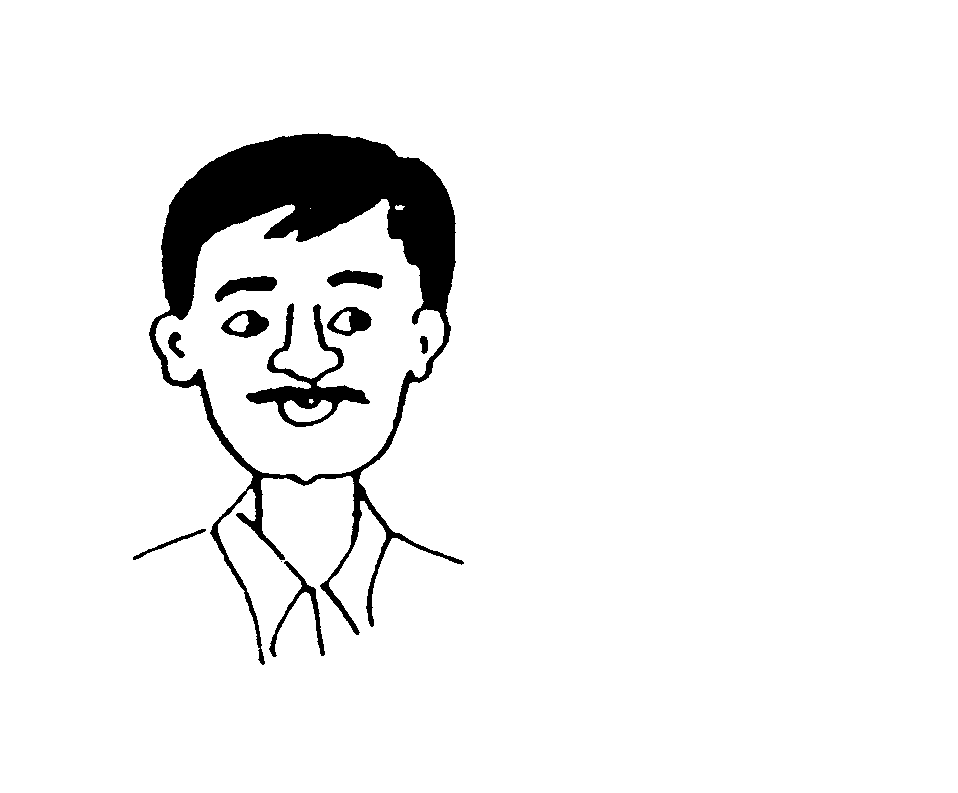 | to sətiš ranəḍe. tyači bhaša məraṭhi ahe. šivay tyala hindi aṇi iŋgrəǰi pəṇ yetə:. |
| mi mira šəha. maǰhi bhaša guǰərati ahe. šivay məla hindi, məraṭhi aṇi iŋgrəǰi pəṇ yetə: | ||
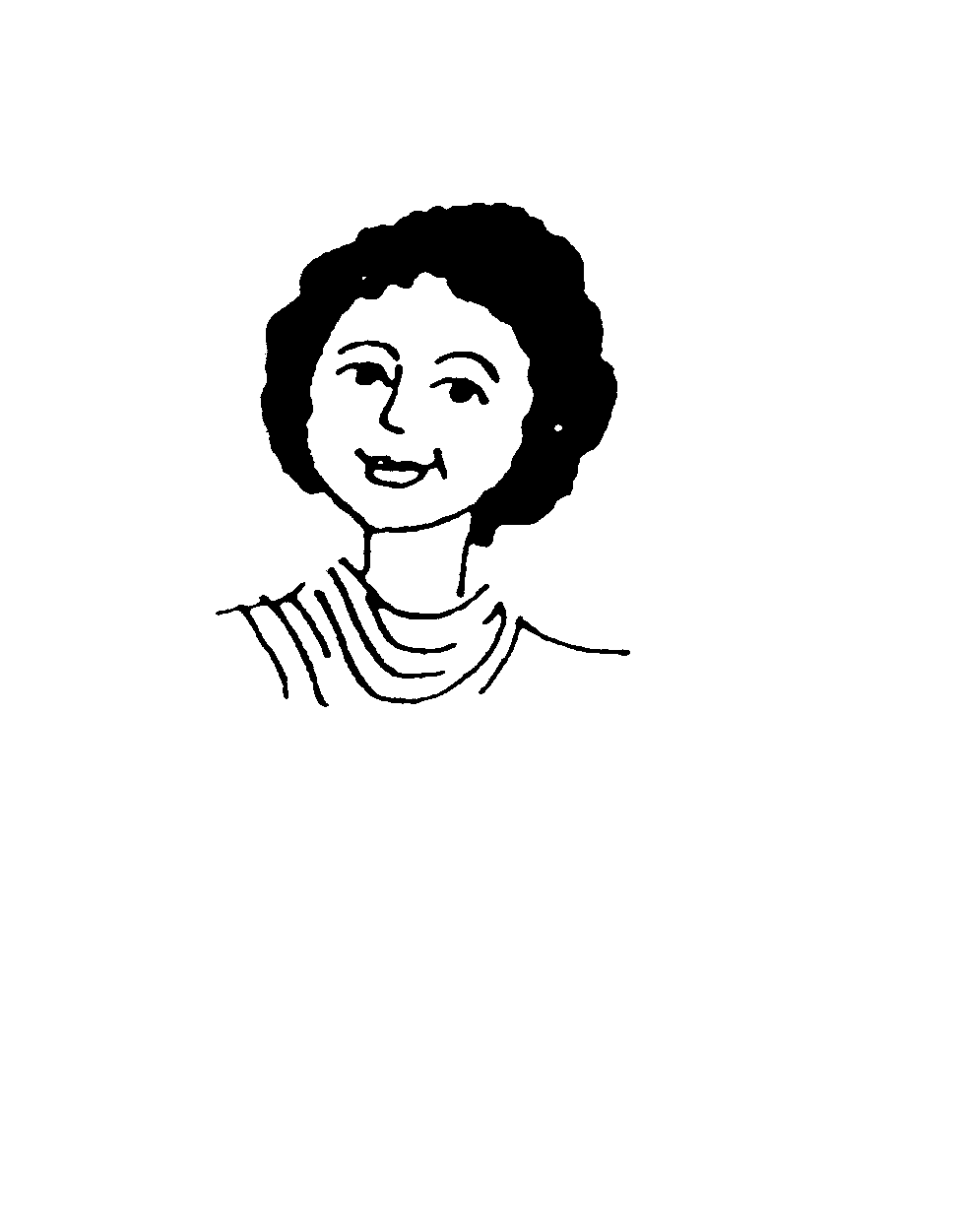 | ti mira šəha. tiči bhaša guǰərati ahe. šivay tila hindi, məraṭhi aṇi iŋgrəǰi pəṇ yetə:. | |
| he səlim šekh. tyanči bhaša urdu ahe. aṇi tyanna uttəm hindi aṇi məraṭhi yetə:. |  | |
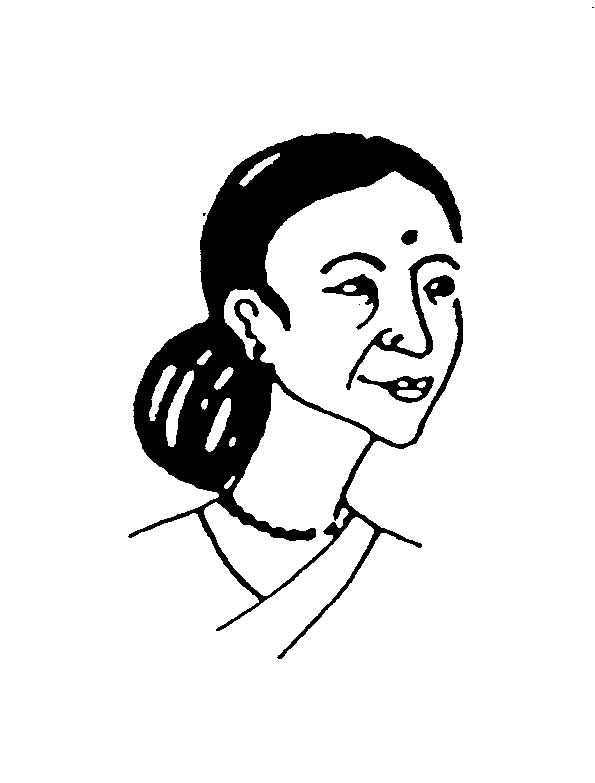 | hya ḍokṭər ləkšmi. tyanči bhaša telgu ahe. šivay tyanna tami, kanəḍi, hindi aṇi iŋgrəǰi yetə:. |
Variations
| šivay mi hindi aṇi iŋgrəǰi pəṇ bolto. | Besides, I speak Hindi and English too. | |
| šivay to hindi aṇi iŋgrəǰi pəṇ bolto. | Besides, he speaks Hindi and English too. | |
| šivay mi hindi, məraṭi aṇi iŋgrəǰi bolte. | Besides, I speak Hindi, Marathi and English too. | |
| šivay ti hindi, məraṭhi aṇi iŋgrəǰi bolte. | Besides, she speaks Hindi, Marathi and English too. | |
| aṇi te uttəm hindi aṇi məraṭhi boltat. | And he speaks excellent Hindi and Marathi. | |
| šivay tya tami, kanəḍi, hindi aṇi iŋgəǰi boltat. | Besides, she speaks Tamil, Kannada, Hindi and English too. | |
| ti phəkta məraṭhi bolte. | She speaks only Marathi. |
Of course you will find a few monolingual speakers around.
| hi əlka mane. tiči bhaša məraṭhi ahe. tila pəktə məraṭhi yetə:. | 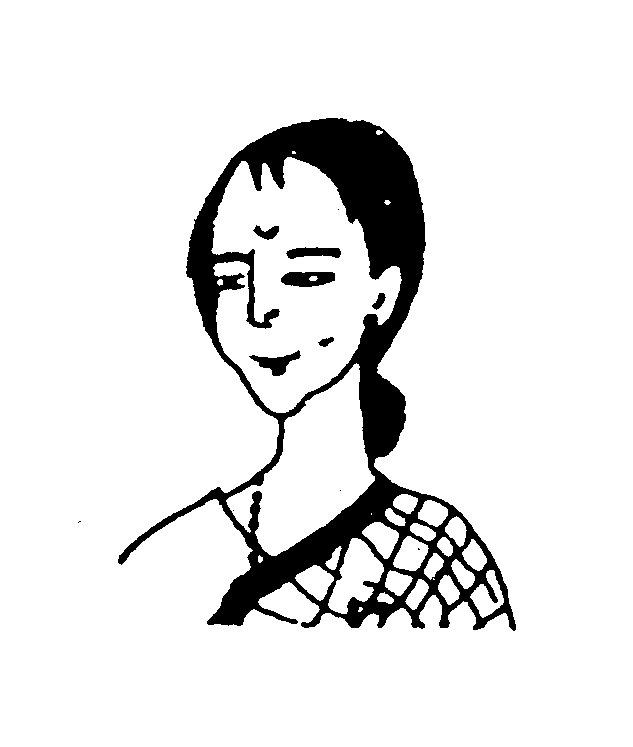 |
a. Quiz each other about the characters sketched above. Useful questions might be:
| tyala / tila / tyanna koṇtya bhaša yetat? | which languages does he / she know? | |
| to / ti / te / tya koṇtya bhaša bolto / bolte / boltat? | Which languages does he / she speak? |
b. Draw identity cards and quiz each other about the language you know (according to the data on your card!).
VOCABULARY
Language names
Nouns
Verbs
Indirect object pronouns
Adverbs and adjectives
Interrogative adjectives
Postposition
-
Interjections
Names
Surnames
| ranəḍe | Ranade | |
| šəha | Shah | |
| šekh | Shaik | |
| mane | Mane |
Men's given name
| sətiš | Satish | |
| səlim | Salim |
Women's given names
| mira | Mira | |
| ləkšmi | Lakshmi | |
| əlka | Alka |
Countries
GRAMMAR NOTE
Before an ending is added,
The rules for making nouns oblique before a postposition can be complex, so it is best initially to learn the postposition phrases as intact units - at least until you get the feel for this type of phrase structure.
CULTURAL NOTE
For convenience we have used the picture of a pointing finger to indicate some of the people in this chapter. Actually, from the standpoint of Indian culture a pointing with a finger at someone is unacceptable. The open hand used to indicate Salim Shaikh is more acceptable.
10. Grammar
A) N N AUX CONSTRUCTIONS
| ha jəgaca nəkaša ahe. | This is a map of the world. | |
| hi šəhərə: ahet. | These are cities. |
The sentences above are based on the structures N N Aux 'N (be N.' Aux stands
for the verb əs-
In the N N Aux construction the noun is, of course, frequently replace by a pronoun. Note that this pattern is like that introduced in Unit One, except that the copula is used. As we mentioned earlier, the pattern with the copula is the more widely used.
Questions. The same rules for questions formation introduced in Unit One apply here. That is, yes-no questions are formed by adding ka to the statement, and question-word questions are formed by inserting the question word in the place of the desired information.
| he šəhər ahe. | This is a city. | |
| he šəhər ahe ka? | Is this a city? | |
| he kay ahe? | What is this? |
In question and answer exchange the first noun or pronoun and the auxiliary are often dropped.
| he kay ahe? | |
| šəhər ahe. | |
| šəhər. |
Repetition of subject. In the N N Aux construction a pronoun is sometimes inserted after the first noun.
| nəvi dilli hi bharətači raǰdhani ahe. | New Delhi (this) is Indian's capital. |
You may recall that some English speakers do the same thing ('My mother, she is a nurse') but in English this usage is considered non-standard.
B) PERSONAL SUBJECT PRONOUNS
As the set of personal subject pronouns is rather complex, it is convenient to look at each person separately.
Fist person. The first person pronouns are shown in Table 2.
Table 2. First person subject pronouns
| Singular | mi | ||
| Excl. | amhi | ||
| Plural | |||
| Incl. | apəṇ | ||
Note that in the first person plural ('we') Marathi makes a distinction between 'we'
excluding and including the person(s) spoken to. For instance, two brothers might
say to an outsider
One of the frequently occurring constructions with
| apəṇ nəkaše bəghu ya. | Let's look at the maps. |
The distinction between the exclusive and inclusive 'we' is a very useful one, and one that can avoid a great deal of social awkwardness.
Second person. The second person subject pronouns are given in Table 3.
TABLE 3. Second person subject pronouns
| Singular (Familiar) | tu | |
| Plural / Respectful | tumhi | |
| Honorific | apəṇ |
Note that the singular is necessarily the familiar form. The plural is used in three ways:
1) to address more than one person whom one would individually address in the singular
2) to address one person in the respectful
3) to address more than one person in the respectful.
It is clear that since the essence of the respectful is using the plural for a single person, the distinction between the plural and respectful is blurred when one is talking to more than one person.
The
Third person. The set of third person subject pronouns is the most complex, as in addition to number and respect there are distinctions of distance and gender. The third person pronouns are given in Table 4.
TABLE 4. Third person subject
| Proximate | Distant | |||||
| M | F | N | M | F | N | |
| Singular (Familiar) | ||||||
| Plural / Respectful | ||||||
The full set of personal subject pronouns is summarized in Table 5. Since the identity of plural and respectful forms has already been discussed, there is no separate mention of the respectful in this table.
TABLE 5. Personal subject pronouns
| First Person | Second Person | Third Person | |||||||
| Proximate | Distant | ||||||||
| M | F | N | M | F | N | ||||
| Singular | |||||||||
| Plural | |||||||||
The personal subject pronouns with their English meanings are summarized below.
| mi | I | hya | they, these (f.) she (resp.) | ||
| amhi | we (excl.) | he | this (n.) | ||
| apəṇ | we (incl.) | hi | they, these (n.) | ||
| tu | you (sg.) | to | he, that (m.) | ||
| tumhi | you (pl. / resp.) | te | they, those (m.) he (resp.) | ||
| apəṇ | you (hon.) | ti | she, that (f.) | ||
| ha | he, this (m.) | tya | they, those (f.) she (resp.) | ||
| he | they, these (m.) he (resp.) | te | that (n.) | ||
| hi | she, this (f.) | ti | they, those (n.) |
C) NA (Aux) CONSTRUCTION
| tumhi kuṭhle? | Where are you from? ['You of where?] | |
| mi əmerikən ahe. | I am American. | |
| ti kuṭhli ahe? | Where is she from? | |
| ti bharətiyə ahe. | She is Indian. | |
| tumhi kuṭhlya? | Where are you from? | |
| mi puṇyači ahe. | I am from Pune. | |
| to madrasca ahe ka? | He is from Madras? |
The sentences above are based on the structure N A (Aux). (A stands for 'adjective'. The parenthesis around Aux indicates that it is sometimes omitted.)
In terms of form, adjective are of two kinds: those that are invariable, like
Variable adjective endings. You are already familiar with the set of variable adjective endings, as they were presented in Table 1 as the endings for possessive adjectives. This set of endings is one of the most important in the language as it occurs in a great many contexts, including the plural of marked nouns and a number of verbal constructions. The set of variable adjective endings is given in Table. 6.
TABLE 6. Variable adjective endings
| M | F | N | |
| Singular | a | i | ə: |
| Plural | e | ya | i |
D) PRESENT TENSE OF THE AUXILIARY
The full paradigm of the present tense of the auxiliary is given in Table 7.
TABLE 7. Present tense of the auxiliary
| First Person | Second Person | Third Person | |
| Singular | |||
| Plural |
Combining these with the personal subject pronouns we get the paradigm below.
| mi ahe | I am | |
| amhi ahot | we are | |
| valign="top"> | tu ahes | you are |
| tumhi ahat | you (pl.) are |
| ha ahe | he, this (m.) is | |
| he ahet | they, these (m.) are he (resp.) is | |
| hi ahe | she, this (f.) is | |
| hya ahet | they, these (f.) are she (resp.) is | |
| he ahe | this (n.) is | |
| hi ahet | they, these (n.) are | |
| to ahe | he, that (m.) ahe | |
| te ahet | they, those (m.) are he (resp.) is | |
| ti ahe | she, that (f.) is | |
| tya ahet | they, those (f.) are she (resp.) is | |
| te ahe | that (n.) is | |
| ti ahet | they, those (n.) are |
Note that
In casual speech the present auxiliary is usually run together with the preceding words, and the h is reduced or elided. Listen to your instructor's pronunciation, and try to imitate it.
Negative auxiliary. For the negative of the auxiliary, Marathi employs a special
negative verb
TABLE 8. Present tense of negative auxiliary
| First Person | Second Person | Third Person | |
| Singular | |||
| Plural |
Combining these with the personal subject pronouns we get the paradigm below.
| mi nahi | |
| amhi nahi | |
| tu nahis | |
| tumhi nahi | |
| ha, hi, he nahi | |
| he, hya, hi nahit | |
| to, ti, te hani | |
| te, tya, ti nahit |
E) CLASSIFICATION OF VERBS
Although this unit is focused on the auxiliary verb, we have also made occasional use of main verbs which in our formulas we will designate as V.
Marathi verbs can be divided into two classes - transitive and intransitive - according to whether or not they take a direct object.
Transitive verbs are those that can take a direct object; intransitive verbs are those that cannot. In our vocabulary lists transitive verbs are labeled v.t.; intransitive verbs are labeled v.i.
F) THE IMPERFECT A
We have had a number of sentences using the transitive verb
| tumhi məraṭhi bolta ka? | Do you speak Marathi? | |
| ho, tohoḍəsə: bolto / bolte. | Yes, I speak little. | |
| to hindi aṇi iŋgrəǰi bolto. | He speaks Hindi and English. | |
| ti məraṭhi aṇi iŋgrəǰi bolte. | She speaks Marathi and English. | |
| te uttəm hindi aṇi məraṭhi boltat. | He speaks excellent Hindi and Marathi. | |
| tya tami, kanəḍi, hindi aṇi iŋgrəǰi boltat. | She speaks Tamil, Kannada, Hindi and English. |
The forms of
| mi bolto | I (m.) speak | |
| mi bolte | I (f.) speak | |
| tu boltos | you (fam. m.) speak | |
| tu boltes | you (fam. f.) speak | |
| to bolto | he (fam.) speaks | |
| ti bolte | she (fam.) speaks | |
| te boltə: | it (fam.) speaks | |
| amhi bolto | we speak | |
| tumhi bolta | you speak | |
| te,tya, ti boltat | he, she (resp.), they speak |
Formation of the Imperfect A. If you study the examples of the Imperfect A above,
you will see that the verbal base
In this formula N means 'noun'. The first noun is the subject, and the second, the direct object. V- is the verbal base; t, the imperfect market and Eimf the set of personal endings for the Imperfect A.
The Imperfect A endings are given in Table 9 below.
Table 9. Imperfect A endings
| Singular | Plural | |||
| Person | M | F | N | |
| 1 | o | e | o | |
| 2 | os | es | a | |
| 3 | o | e | ə: | at |
Negative. The negative of the Imperfect A does not retain any indication of gender so it is simpler than the affirmative. It has the form N (N) V-t Auxneg.
Here is the full paradigm.
| mi maraṭhi bolat nahi. | I don't speak marathi | |
| mi bolət nahi. | I (m.,f.) don't speak. | |
| tu bolət nahis. | You (fam., m. f.)don't speak. | |
| to, ti, te bolət nahi. | he, she, it (fam.)doesn't speak. | |
| amhi bolət nahi. | We don't speak. | |
| tumhi bolət nahi. | You don't speak. | |
| te, tya, ti bolət nahit. | he, she (resp.),they don't speak. | |
G) N-la IMPERSONAL CONSTRUCTION WITH ye-
In a sentence like '
| tumhala məraṭhi yetə: ka? | |
| ho, məla thoḍəsə: yetə:. | |
| tyala hindi aṇi məraṭhi yetə:. |
The literal meaning of the first sentence is 'Does Marathi come to you?'. In these sentences the pronoun referring to the person is the indirect object rather than the subject.
The form of this impersonal construction in the imperfect A is:
N-la N V-t E imf.
In this construction the ending is governed by the gender and number of the second noun. The endings are the regular Imperfect A endings, but are, of course, restricted to the third person.
Note how the ending of the verb changes according to the gender and number of the second noun.
| tyala məraṭhi yetə:. | |
| tyala amči bhaša yete ka? | |
| tyala tin bhaša yetat. |
Since
When the first noun or pronoun is plural (or respectful),
| mulanna tin bhaša yetat | The children know three languages. | |
| tyanna tin bhaša yetat. | He / she / they know three languages. |
Negative. The negative of the impersonal construction we are dealing with is: N-la N V-t Aux neg.
| məla məraṭhi yet nahi. | I don't know Marathi. |
H) INDIRECT OBJECT PRONOUN FORMS
The indirect object pronouns are basically formed by adding
| subject pronoun | Indirect Object Pronoun | ||
| mi | məla | ||
| tumhi | tumhala | ||
| to | tyala | ||
| ti | tila | ||
| te, tya, ti | tyanna | ||
Remember that these forms means 'to me', 'to you', etc.
I) THE PERFECT ASPECT
We have encountered three sentences using the verb šik-
| tumhi kuṭhe šiklat? | |
| kiti divəs šiklat? | |
| te kuṭhe šikle? |
Note that the verbal base
| tumhi šiklat | You learned | |
| te šikle | they (m), he (resp.) |
PATTERN PRACTICE
A. Practice using the subject pronouns using yourself as the point of reference, and pointing to the other members of the class. For respectful forms, mention the names of your instructor or other members of the faculty.
B. Give the pronoun that can be substituted for each noun or noun phrase. Use distant forms for the third person.
| majha mitrə | əruṇ aṇi mi | ||
| maǰhi məitriṇ | mulga | ||
| mulə: | sureš aṇi dilip | ||
| sunita aṇi uma | tu aṇi madhəv | ||
| ai | tu aṇi mi |
C. Give the form of the present auxiliary required for each noun or pronoun.
| mi | tumhi | ||
| maǰhi məitriṇ | maǰha mitrə | ||
| amhi | maǰhi bəhiṇ | ||
| tu | apəṇ | ||
| ha | mulə: |
D. Repeat the above exercise, using the negative auxiliary.
E. Complete the following sentences with the appropriate from of the auxiliary, first affirmative, then negative.
| mi əmerikən... | |
| tumhi bharətiya ... ka? | |
| tu puṇyača .. ka? | |
| amhi əmerikən... | |
| amce mitrə frenč... |
F. Complete the following sentences with the appropriate form of puṇyacə:
| ram ... ahe. | |
| vəišali ... ahe. | |
| əruṇ pəvar .. ahet. | |
| uma dešmukh ... ahet. | |
| tumhi .. ka? (use f. pl.) | |
| tumhi ...ka? (use m. pl.) |
G. Complete the following sentence with the appropriate Imperfect A form of
| sətiš ranəḍe ... | |
| mira šəha ... | |
| səlim šekh ... | |
| ḍɔkṭər ləkšmi ... | |
| mi ... | |
| meri ... | |
| bil ... |
H. Repeat the above exercise using
I. Repeat both G. and H. above using the appropriate negative Imperfect forms.
J. Use each of the following pronouns or names in the frame-
| mi | |
| ti (sg.) | |
| amhi | |
| tumhi | |
| to | |
| sətiš | |
| səlim šekh | |
| ḍɔkṭər ləkšmi |
K. Repeat exercise J in the negative.
L. Translate the following sentence into Marathi.
1. Where is New Delhi?
2. I am not German.
3. I am American.
4. We are American.
5. Are you Maharashtrian? (Use resp.)
6. What town are you from? (Use resp.)
7. What town are you from? (Use fam.)
8. Milwaukee is a city.
9. Wisconsin is a state.
10. Is Sunil from Kolhapur?
11. No, he's from Solapur.
12. Prof. Joshi is from Nagpur.
13. Is Prof. Kamble from Nagpur too?
14. Do you know Marathi?
15. Does your friend speak Marathi?
M. Give the plural of each noun.
| nav | puruš | nədi | |||
| gav | deš | vəhini | |||
| mul | divəs | bai | |||
| ba | nəkaša |
| raǰdhani | ||
| šəhər | məhina | bəhiṇ | |||
| raǰyə | aṭhəvḍa | məitriṇ | |||
| bhau | ai | ||||
| mitrə | aji |
Unit Three
Naming Things,
Placing Things,
Commands
11. What Is This?
Meena tells Jenny the names and gender of objects Jenny takes of her bag. These are
all in answer to Jenny's question:
hi bæg ahe. | he pustək ahe. | hi vəhi ahe. |
ha kagəd ahe. | he pen ahe. | hi pensil ahe. |
ha čəšma ahe. | ha caku ahe. | ha kælkyuleṭər ahe. |
Jenny now asks about objects she has in her room.
ha sṭeplər ahe. | ha reḍio ahe. | ha kɔmpyuṭər ahe. |
ha ṭelifon ahe. | he ghəḍya ahe. | ha ṭep rekɔrḍər ahe. |
Now Jenny asks about the features of the structure that surrounds her and the furniture it contains.

he ghər ahe.
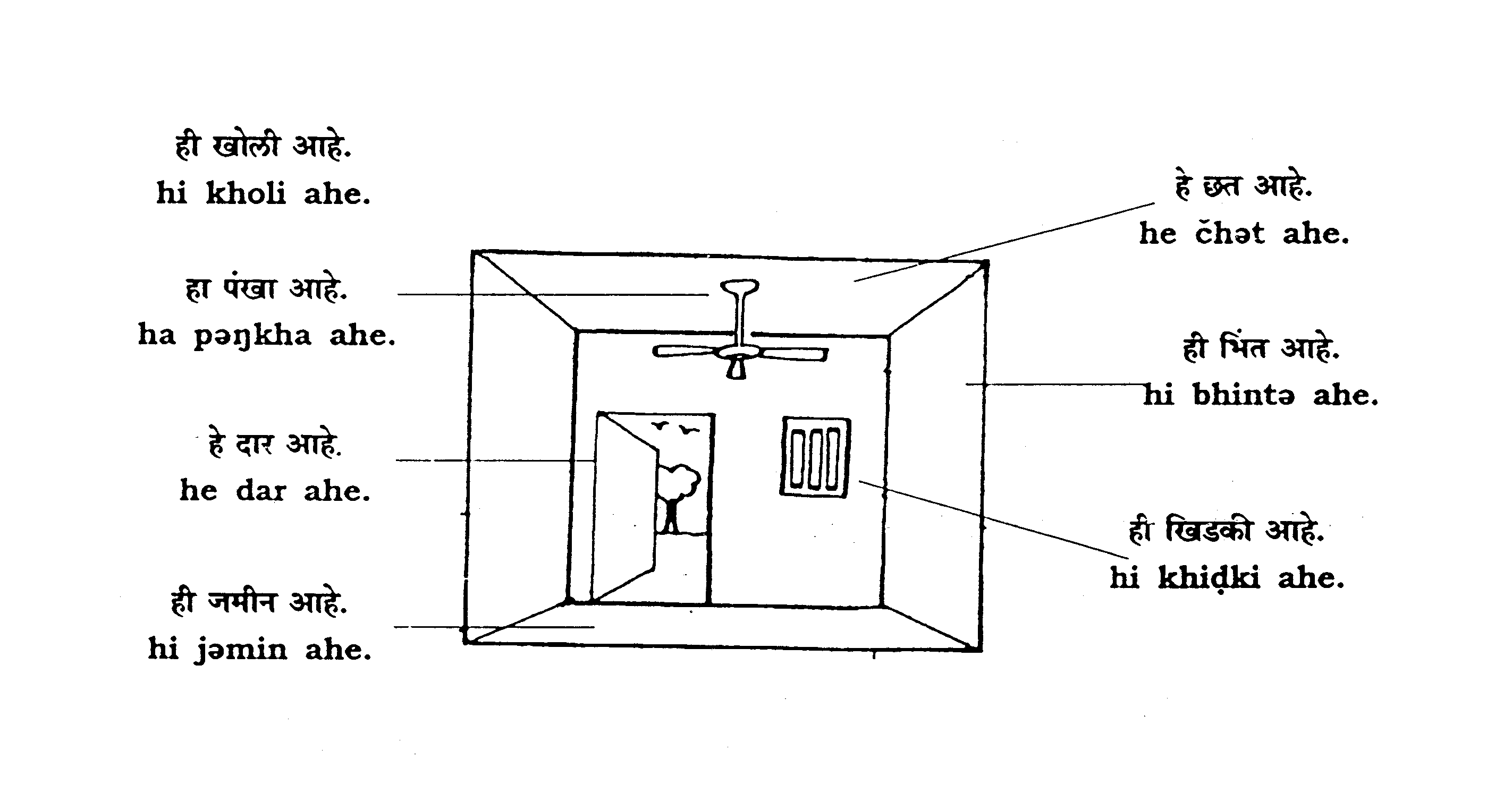
hi kholi ahe.
 he ṭebəl ahe. |
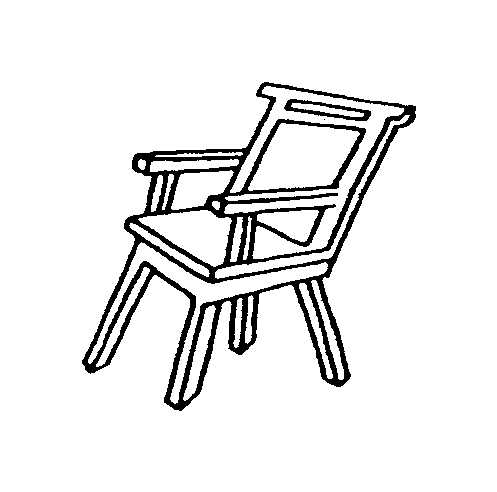 he khurči ahe. | 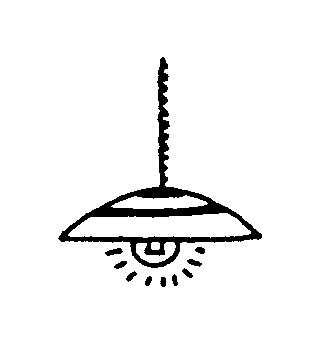 ha diva ahe. |
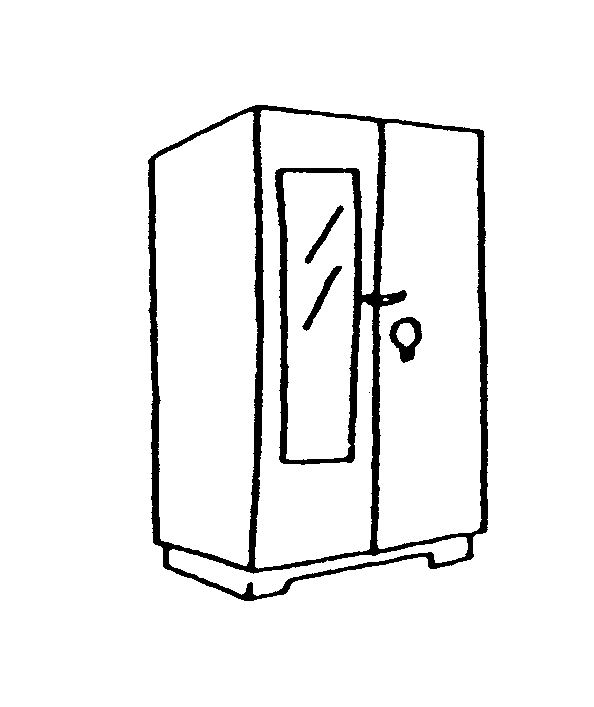 he kəpaṭ ahe. |  he šelph ahe. |
And finally Jenny asks the names of objects used everyday in her Marathi class.
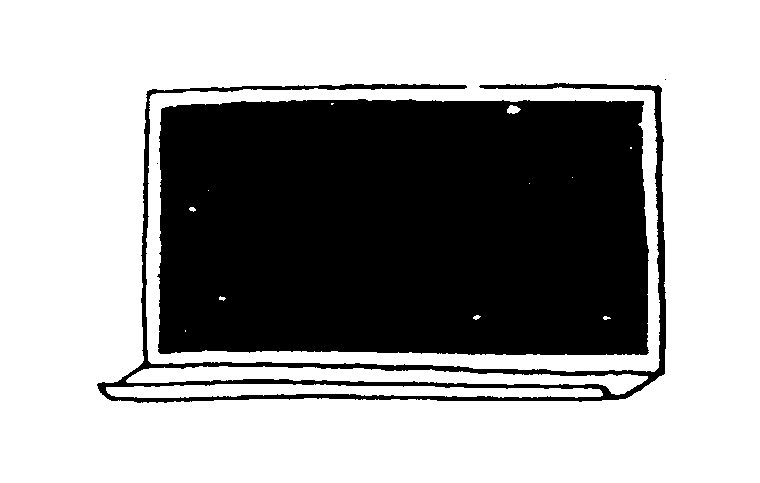 ha phəa ahe. |  ha ḍəsṭər ahe. |  ha khəḍu ahe. |
Go round your class or group, each one in turn asking the next person to identify one of the objects in the picture or one of the corresponding real objects you have with you or see around you.
Now Jenny finds out the plurals of all names of the objects she has learned from Meena.
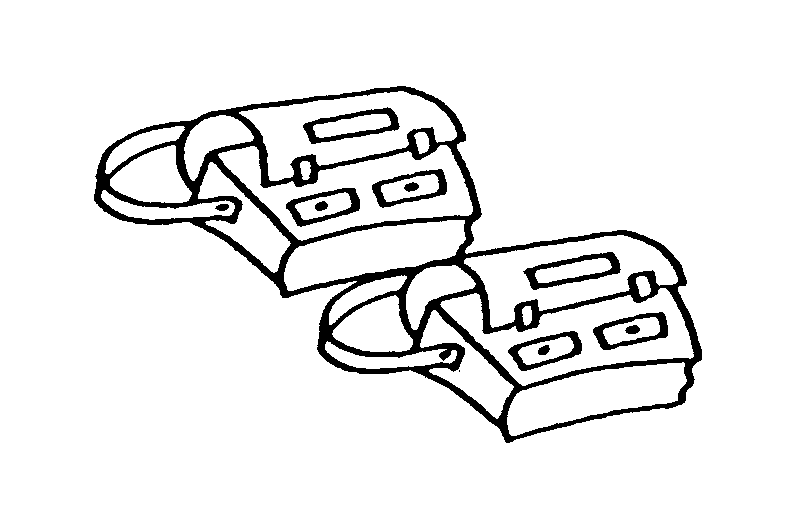 | 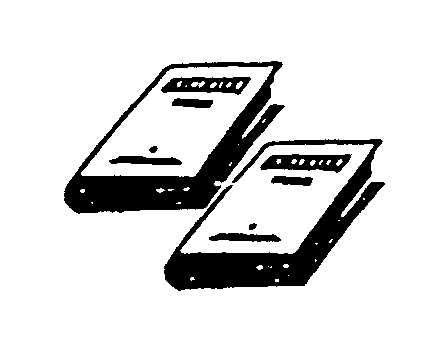 hi pustəkə: ahet. | hya vəhya ahet. |
he kagəd ahet. | hi penə: ahet. | 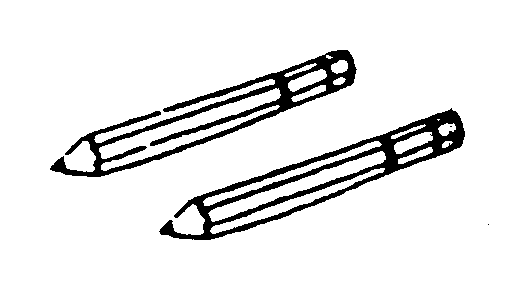 hya pensili ahet. |
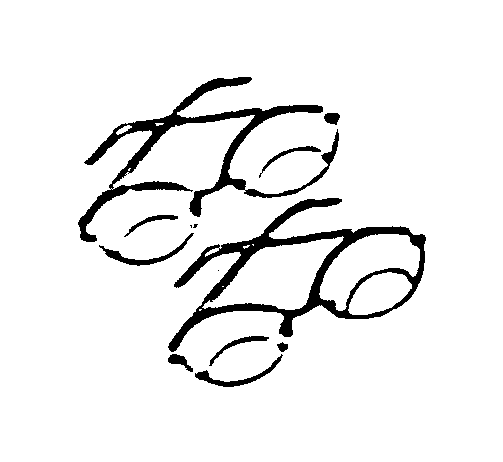 he čəšme ahet. | 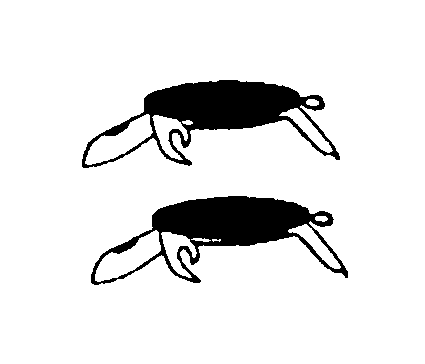
he caku ahet. | 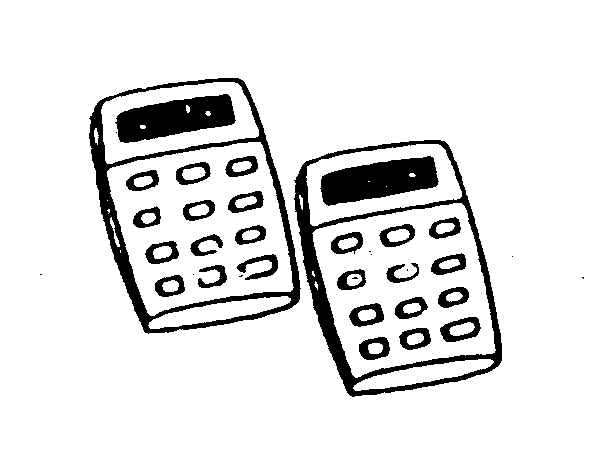 he kælkyuleṭər ahet. |
 he kɔmpyuṭər ahet. | 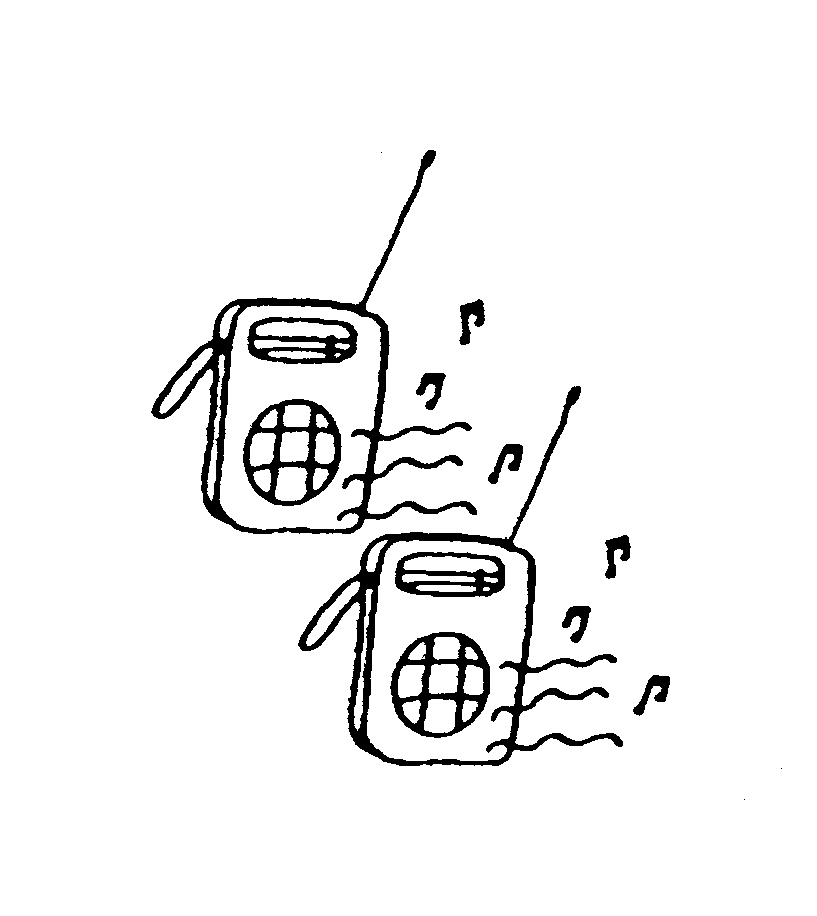
he reḍio ahet. | 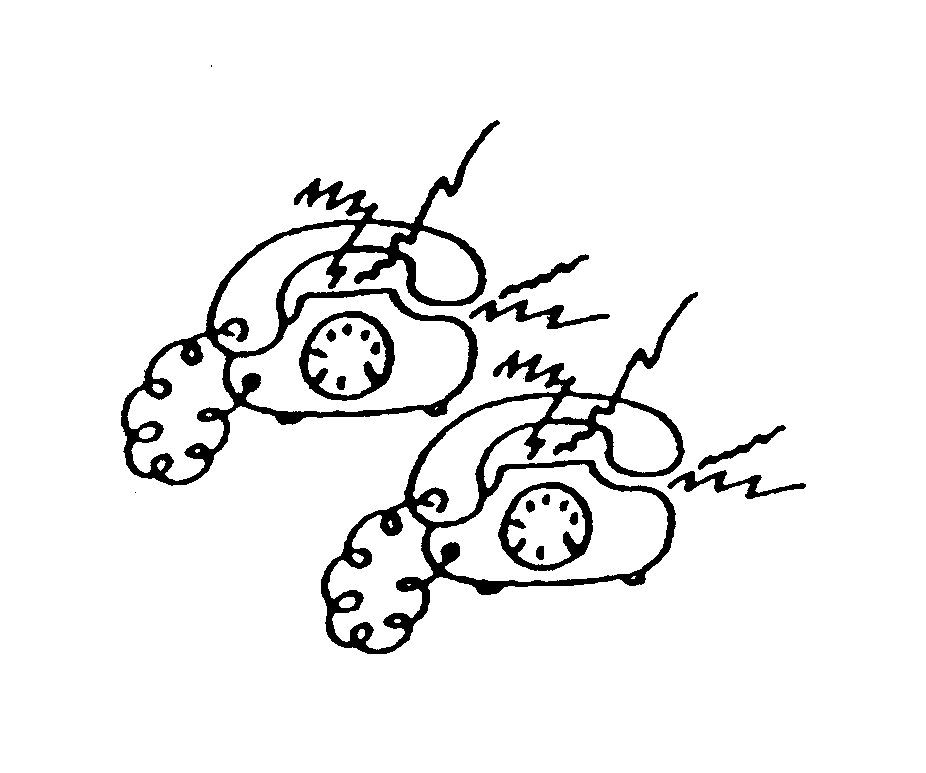 he ṭelifon ahet. |
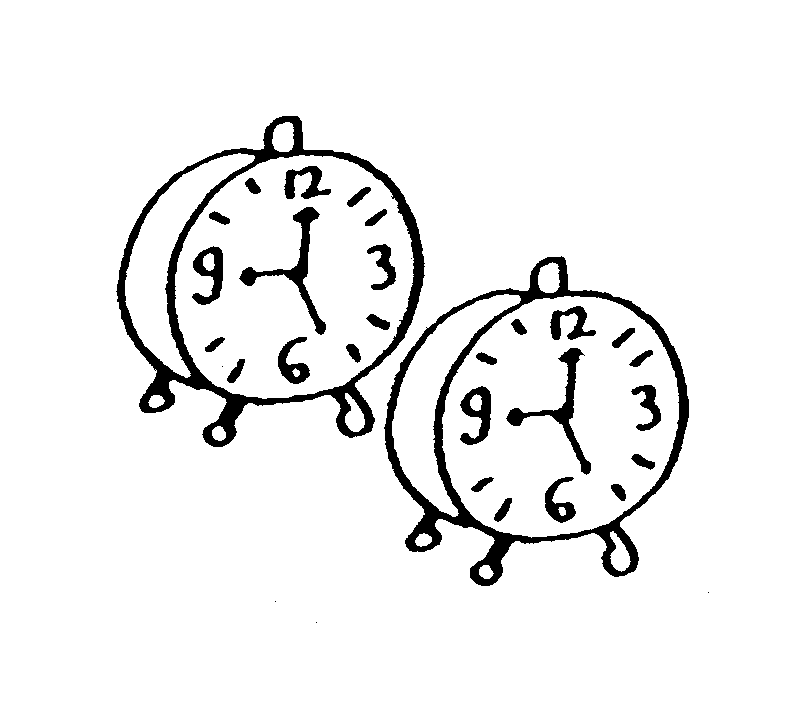 hi ghəḍyaə: ahet. | 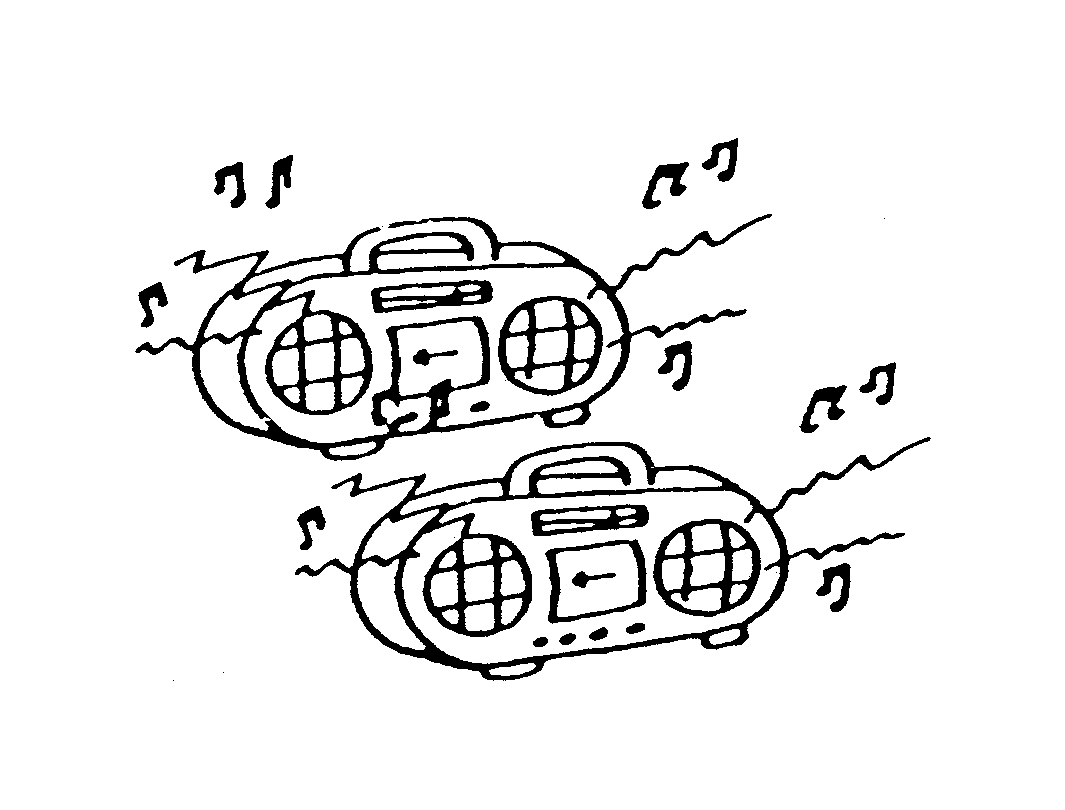
he ṭep rɔkorḍər ahet. | 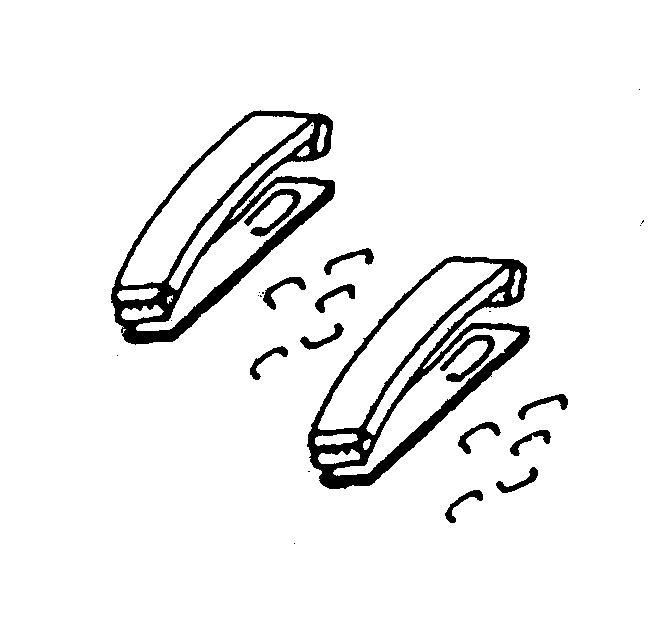 he sṭeplər ahet. |
 hi ghərə: ahet. | 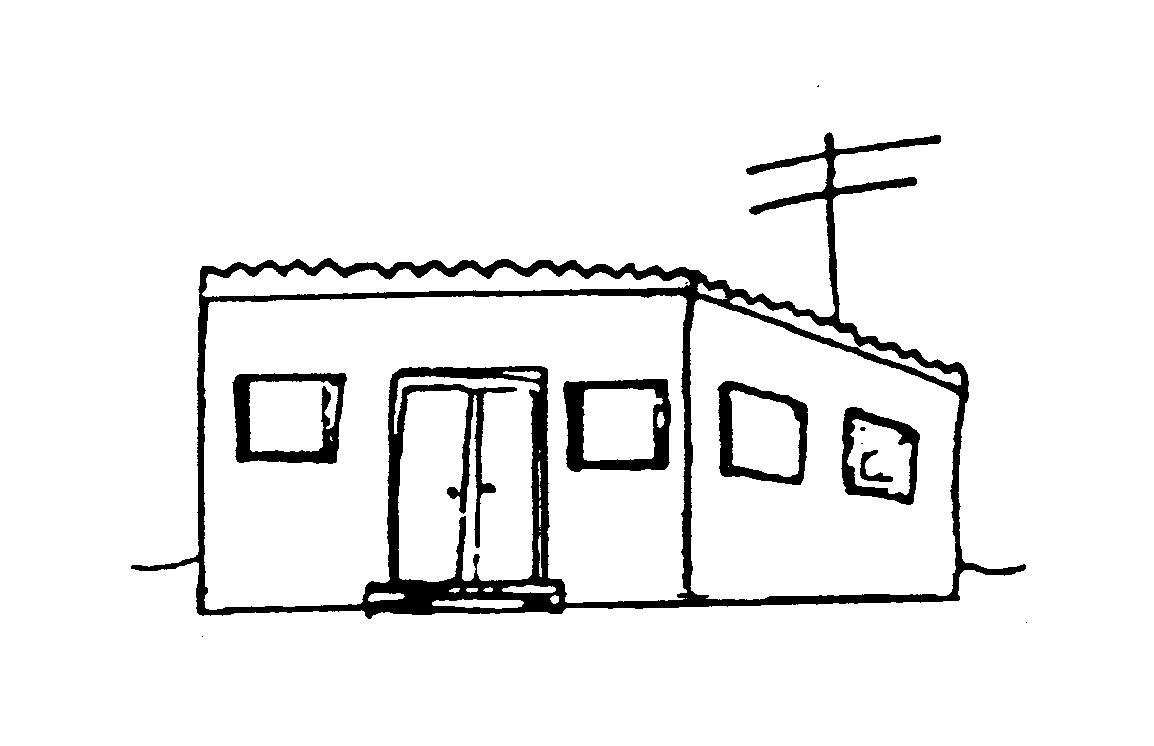 |
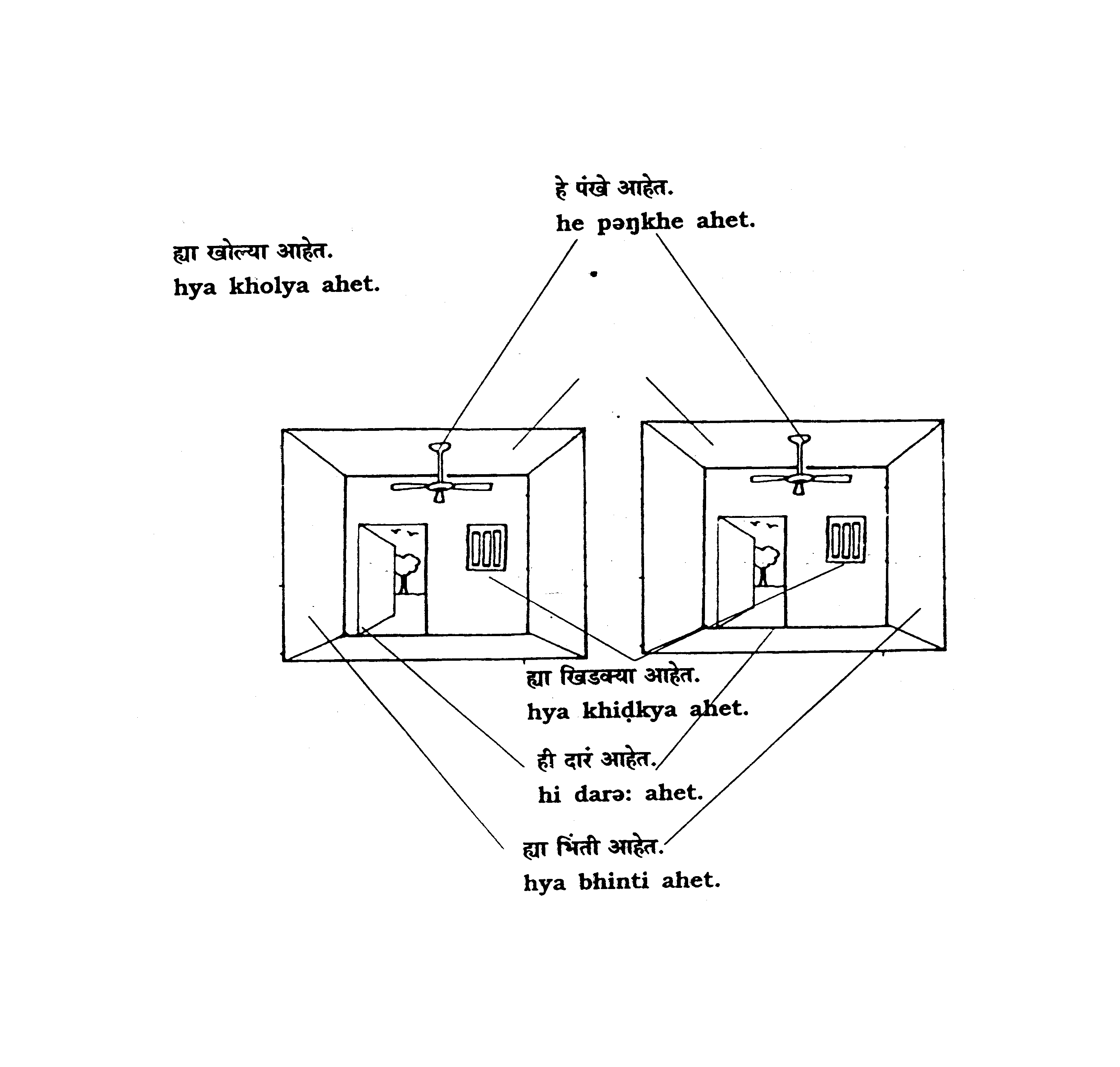
hya kholya ahet.
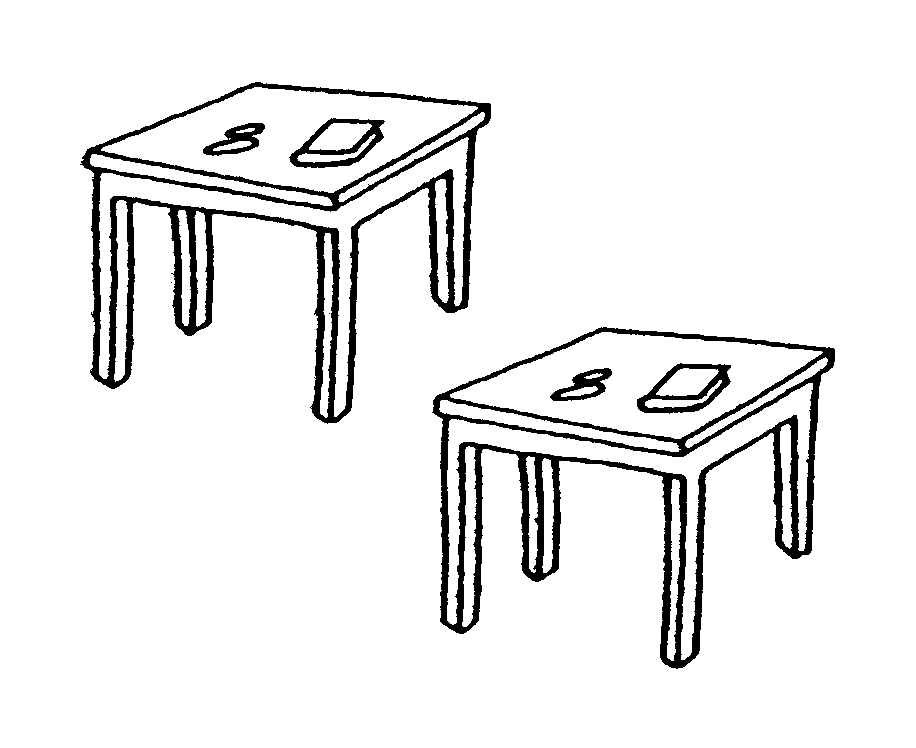 hi ṭeblə: ahet. | 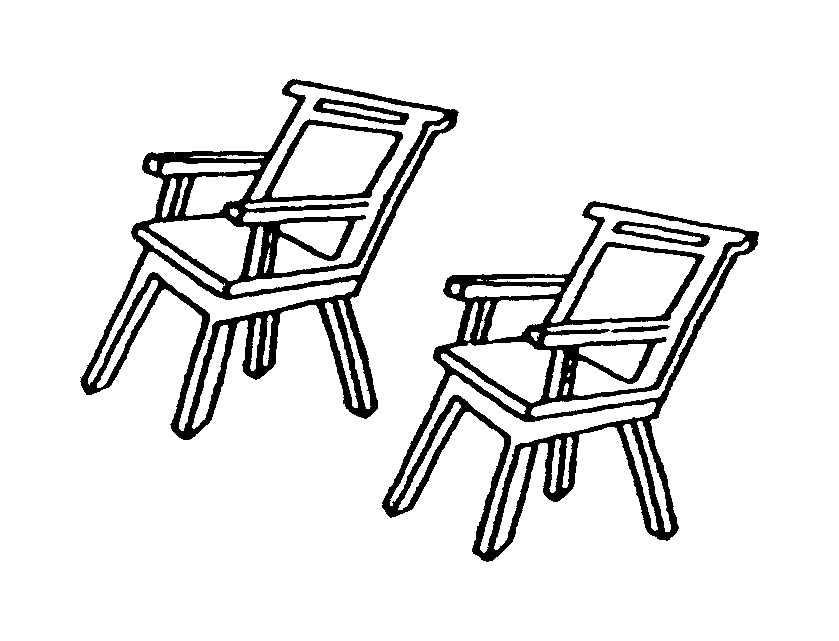
hya khurčya ahet. | 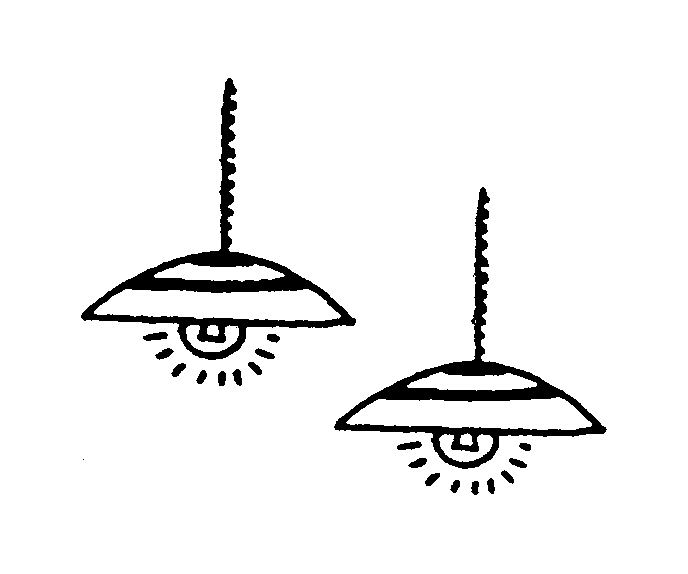 he dive ahet. |
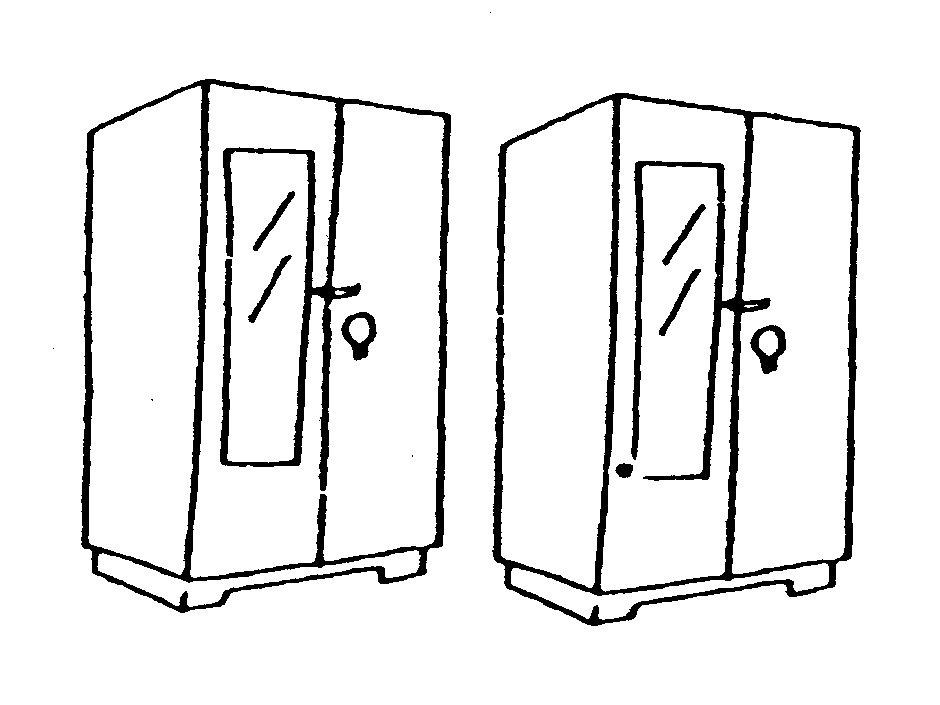 hi kəpəṭə: ahet. | 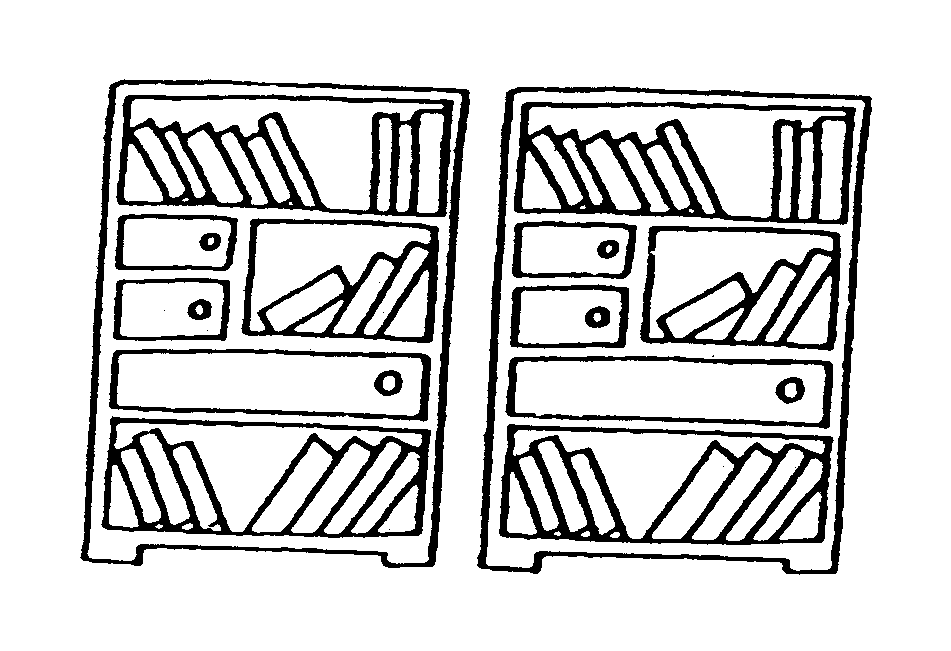 hi šelphə: ahet. |
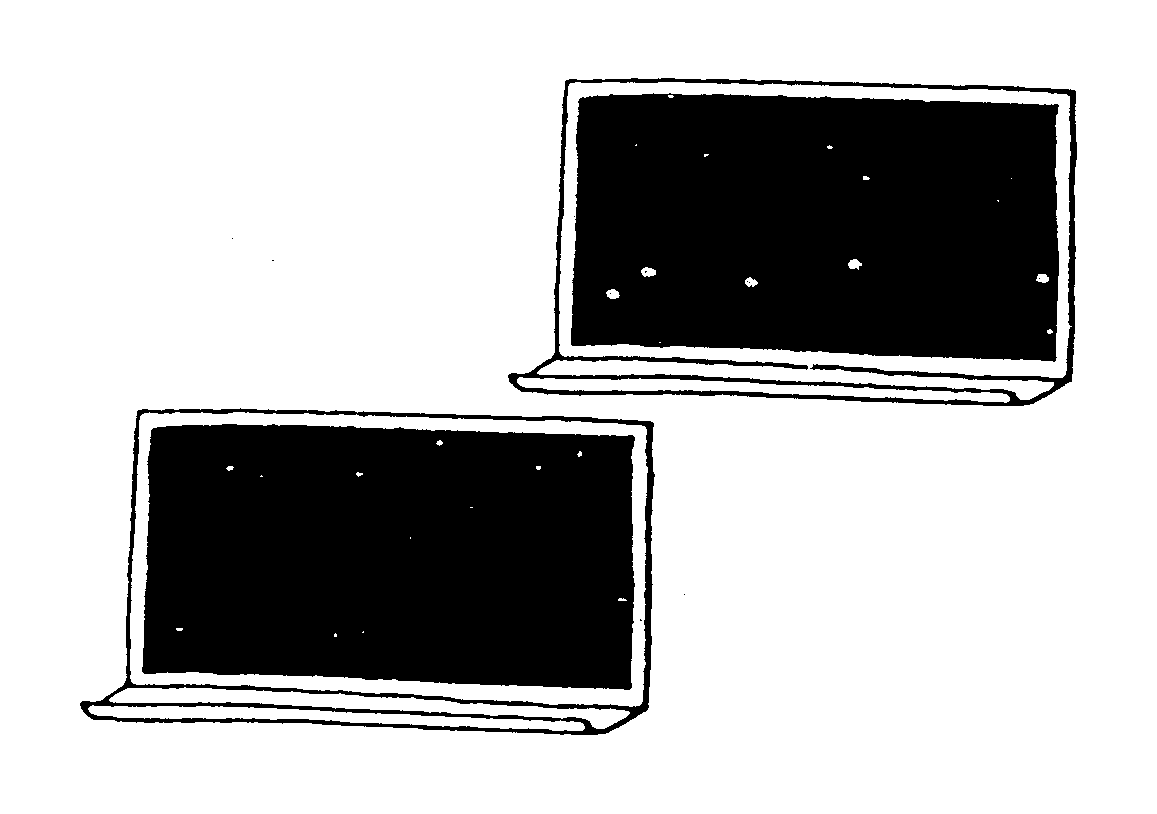 he phəe ahet. | 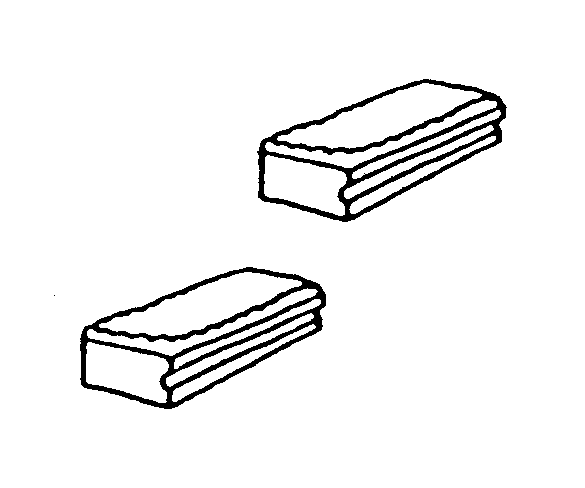 he ḍəsṭər ahet. | 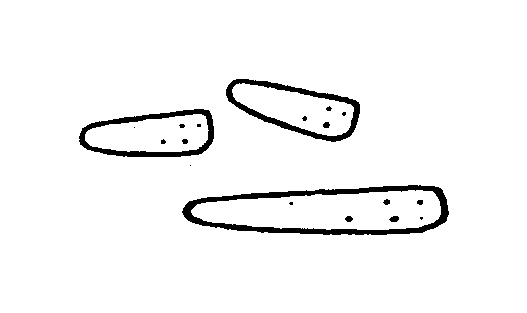 he khəḍu ahet. |
a. Go round your class or group, each one in turn asking the next person the plural of one of the objects in the pictures or corresponding real objects. Use the pattern of the following example:
| ek pustək, don...? | |
| don pustəkə:. |
This is a good way to drill all the nouns in your vocabulary lists.
b. Make vocabulary cards by making at least two Xerox copies of these pictures, and pasting each picture on a separate card. You can then play a variety of games. Here are a few suggestions.
i) Concentration 1. Put cards face down. The first player turns up two cards. If they are a pair s / he keeps them; if not, s / he puts them in the same position. Subsequent players try to make pairs by remembering the position of each card. Each time a player makes a pair s / he should say the Marathi word.
ii) Concentration 2. One person deals out a set of six or seven cards, leaving them up for a moment, then turning them over. Then the other members of the group should name the objects in the set.
iii) You can devise your own Rummy-type games for drilling this and other vocabulary.
VOCABULARY
Nouns
Neuter nouns
Feminine nouns
Masculine nouns
Pronouns
12. This Is Jane's Bag
Jenny's friend Jane has her bag open on a table near by, with some of the contents displayed. Meena quizzes Jenny about them.
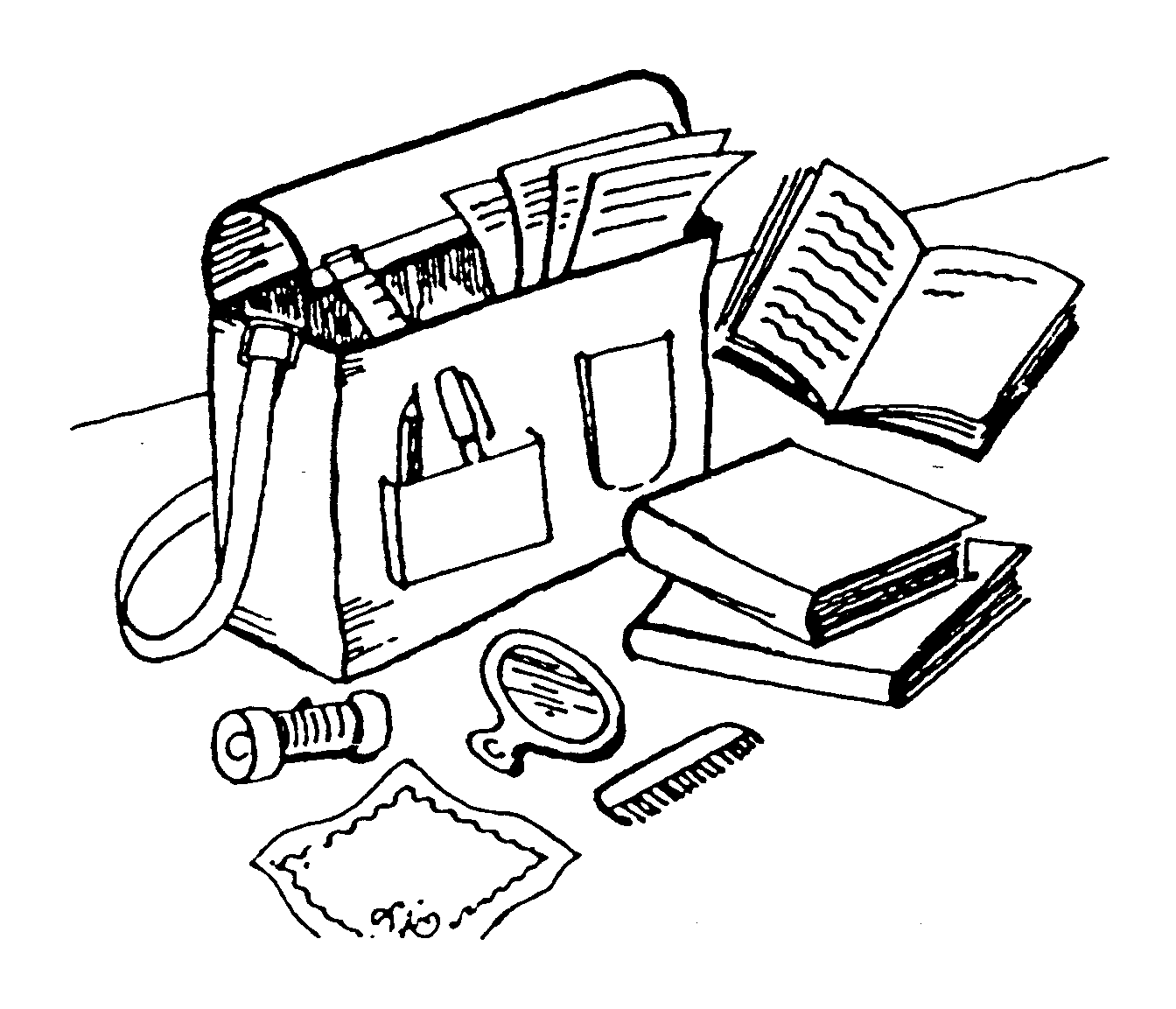
| M : | kəŋgva ahe ka? | Is there a comb? | |
| J : | ho ahe. | Yes, there is. | |
| M : | ṭuthbrəš ani ṭuthpesṭ ahe ka? | Are there a toothbrush and toothpaste? | |
| J : | nahi | No. | |
| M : | kiti pustəkə: ditat? | How many books do you see? | |
| J : | tin pustəkə: distat. | You can see three books. |
a. Answer the following questions about the picture above.
| hi bæg ḍebiči ahe ka? | |
| bæget pen distə: ka? | |
| bæget čəšma disto ka? | |
| bægejəvəl kiti penə: ahet? |
b. Ask each other additional questions about the picture.
c. Talk about the contents of your own bags.
Jenny and Meena look at a photo of the college dorm room of Jenny's friend Jim Taylor.
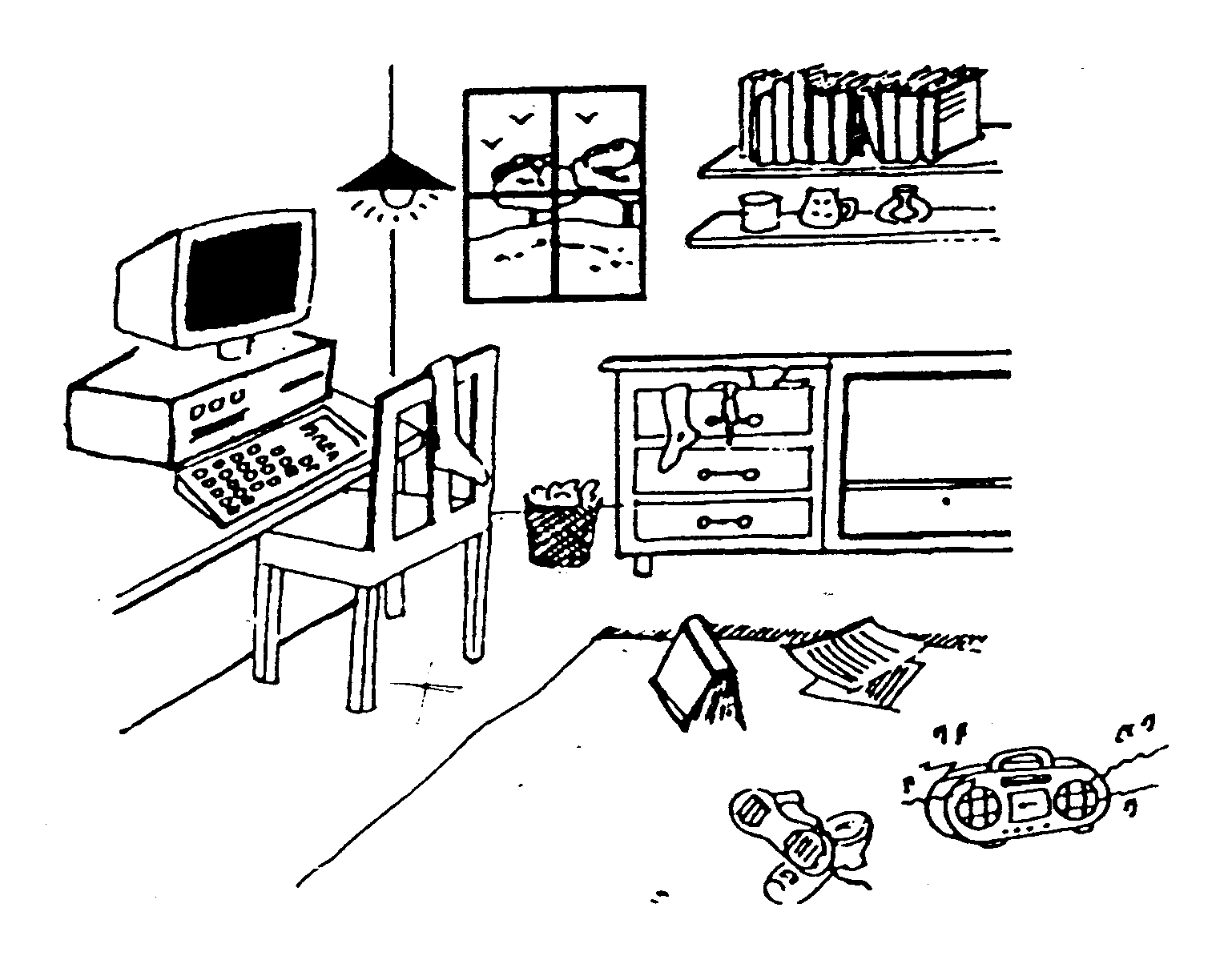
Variation
| kholimədhe kay kay ahe? | What is there in the room? |
a. Talk about what you see in the room, or what is in the room. (You may want to go beyond what you see in the picture.) Here are some words you will want to use.
| moja | sock | |
| məg | mug | |
| ṭopli | basket | |
| ḍravər | drawer | |
| sətrənǰi | carpet | |
| khaṭ | cot |
b. Talk about what there is in you own room.
Meena quizzes Jenny about the location of objects in the photo.
| M : | kɔmpuṭər kuṭhe ahe? | Where is the computer? | |
| J : | ṭeblavər ahe. | It's on the table. | |
| M : | moja kuṭhe ahe? | Where is the sock? | |
| J : | khurčivər ahe. | It's on the chair. | |
| M : | ṭep rekərḍər ṭeblavər ahe ka? | Is the tape recorder on the table? | |
| J : | nahi, to jəminivər ahe. | No, it's on the floor. | |
| M : | ǰimcə: ghəḍya disət nahi. Te kuṭhe ahe? | I don't see Jim's clock. Where is it? | |
| J : | məla mahit nahi. | I don't know. | |
| M : | aṇi ǰimči bæṭri? | And Jim's flashlight? | |
| J : | kəpaṭat ahe. | It's in the cupboard. | |
| M : | ṭopli ḍiste ka? | Do you see a (waste) basket? | |
| J : | ho, ti ḍravər jəvə ahe. | Yes, it's near the drawer. |
a. Answer the following questions.
| ṭelifon kuṭhe ahe? | |
| məg kuṭhe ahet? | |
| reḍio kuṭhe ahe? | |
| khurčivər pustək ahe ka? | |
| šelphvər kiti pustəkə: ahet? |
b. Ask each other more questions on the pattern above.
Now Jenny and Meena talk about what you can see outside, through Jim's window.
| M : | khiḍkitun kay distə:? | What do you see through the window? | |
| J : | jhaḍ distə:, pəkši distat. | You see a tree and birds. | |
| M : | akaš distə: ka? | Do you see the sky? | |
| J : | ho, aṇi gəvət pəṇ distə:. | Yes, and you see grass too. |
List everything that you see in the following picture,* using the verb
Here are a few additional words you may want to use.
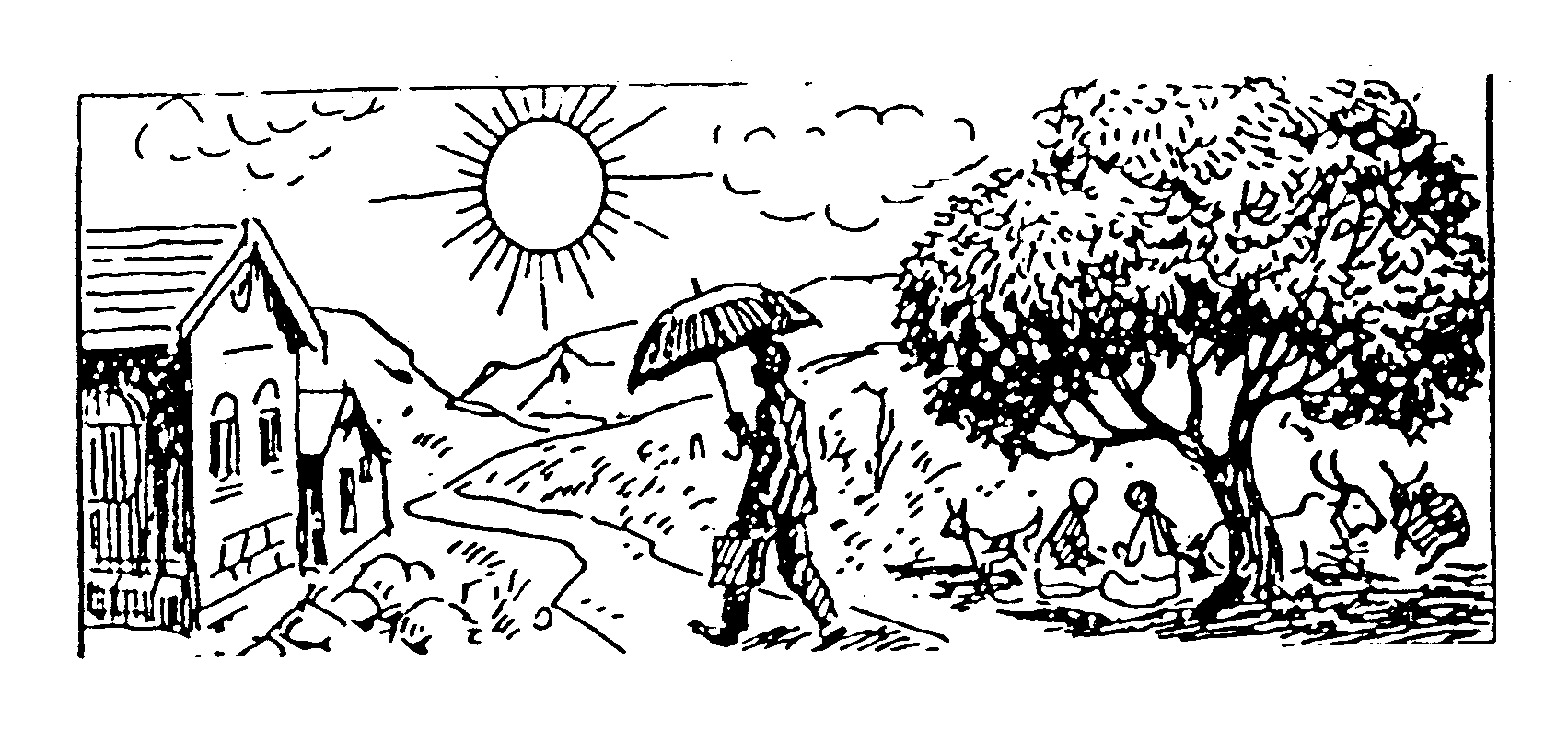
VOCABULARY
Nouns
Adjectives
Postpositions
Verbs
Phrases
| bæget | in the bag | |
| bægejəvə | near the bag | |
| kholimədhe | in the room | |
| ṭebəlavər | on the table | |
| kurčivər | on the chair | |
| jəminivər | on the floor | |
| sətrənǰivər | on the carpet | |
| kəpaṭat | in the cupboard | |
| šelphvər | on the shelf | |
| khiḍkitun | through the window |
WORD STUDY
1.
2.
13. Let's Begin
The instructor comes into classroom and starts the lesson.
| I: | apəṇ suru kəru ya. | Let's begin. | |
| ..., dar lav na. | ..., please, close the door. | ||
| divahi lav. | Turn on the light too. | ||
| aṇi khiḍki ughəḍ. | And open the window. |
A late-coming student stands at the door.
| S : | mi at yeu ka, | May I come in, | |
| sər / mæḍəm? | Sir / Madam? | ||
| I: | ye. | Come in. |
The instruction shows a picture of a city street.
| I : | ata apəṇ he citrə bəghu ya. | Now let's look at this picture. |
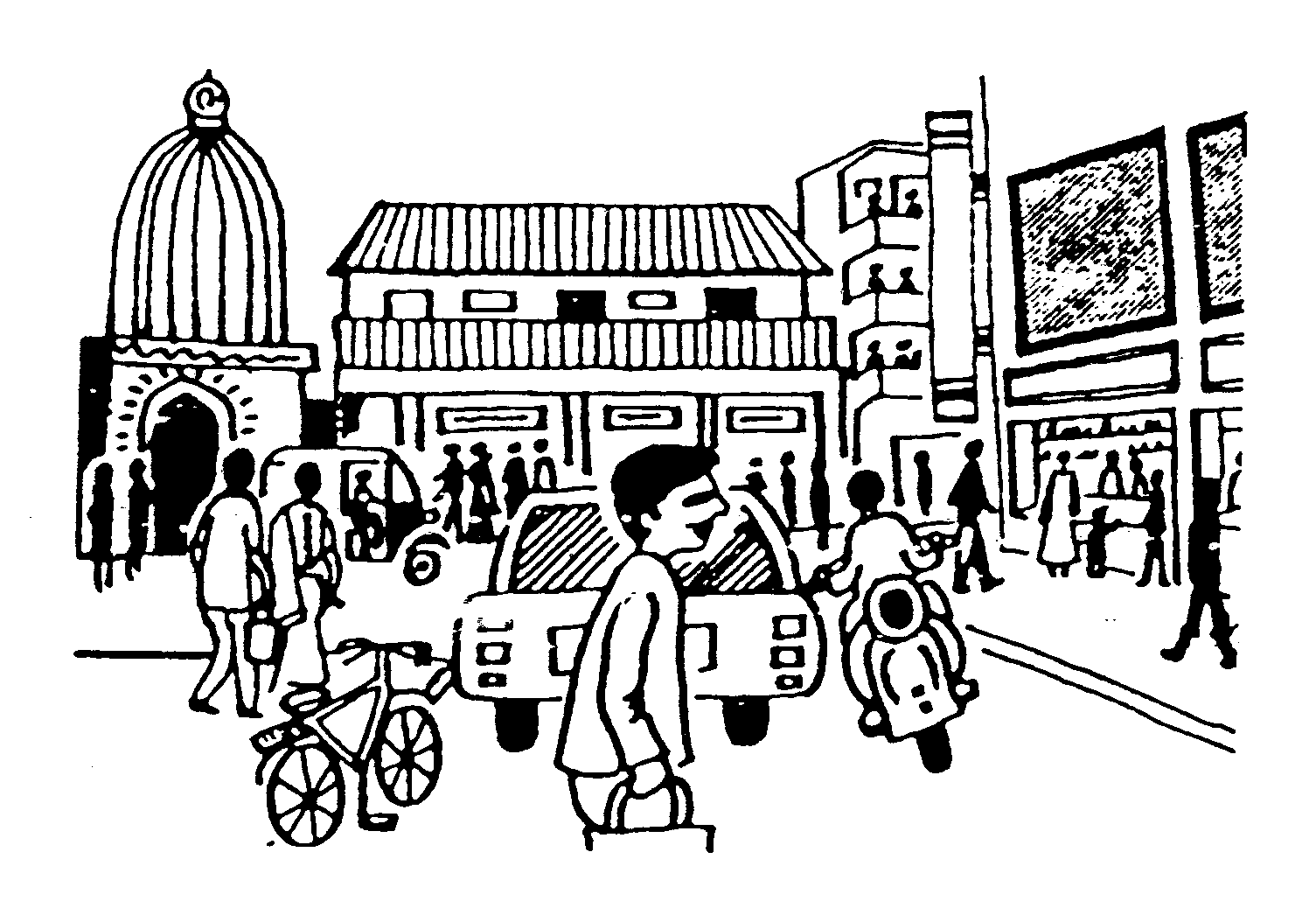
| ha cəuk ahe. | This is an intersection. | |
| he dukan ahe. | This is a shop. | |
| hi imarət ahe. | This is a building. | |
| he deu ahe. | This is a temple. | |
| hi gaḍi ahe. | This is a car. | |
| hi rikša ahe. | This is a rickshaw. | |
| hi skuṭər ahe. | This is a motor scooter. | |
| hi saykəl ahe. | This is a bicycle. | |
| ata tumhi mhəṇa. | Now you say (them). | |
| səgyanni miun mhəṇa. | Say (them) all together. | |
| pərət mhəṇa. | Say (them) again. |
The class talks about the meanings of Marathi words.
| I: | 'rəsta' mhəṇǰe kay? | What does 'rəsta' mean? | |
| S: | 'rəsta' mhəṇǰe 'roḍ', 'sṭriṭ.' | 'rətsa' means 'road', 'street'. | |
| I: | 'deu' mhəṇǰe kay? | What does 'deu' mean? | |
| S: | 'deu' mhəṇǰe 'ṭemple'. | 'deu' means 'temple'. | |
| I: | bərobər ahe. | That's right. | |
| I: | 'cəuk' mhəṇǰe kay? | What does 'cəuk' means? | |
| S: | 'cəuk' mhəṇǰe 'kornər'. | 'cəuk' means 'corner'. | |
| I: | cuk. 'cəuk' mhəṇǰe 'iṇṭərsekšən'. | That's incorrect. 'cəuk' means 'intersection'. | |
| I: | ... ata tu prəšnə vičar. | ... now you ask a question. | |
| S1: | 'rəsta' mhəṇǰe kay? | What does 'rəsta' mean? | |
| S2: | 'rəsta' mhəṇǰe 'strit'. | 'rəsta' means 'street'. | |
| I: | ..., dukan dakhəv. | ..., point out a shop. | |
| S: | he dukan ahe. | This is a shop. | |
| I: | bərobər ahe. | That's right. |
a. Replying to the question
b. Go through the nouns in the vocabulary at the end of this chapter asking the English meanings of the Marathi words using the pattern just illustrated. Take turns having one person in each group of three or four quiz the others in the group. If one person offers a wrong answer, proceed to the next until correct answer is produced.
c. Extend this same exercize to all the vocabulary items you have learned thus far.
Asking for Marathi Equivalents
You may have realized by now that it is a bit childish to ask
| məraṭhit hyala kay mhəṇtat? | 'What do they call this in Marathi?' ['In Marathi to this what do they say?'] | |
| məraṭhit hyala kay mhəṇtat? | 'What do they call this in Marathi?' | |
| hyala diva mhəṇtat. | They call it 'diva'. |
You can use this construction when the actual object is not present. All you
need to do is substitute the English word plus
| məraṭhit 'laiṭ'-la kay mhəṇtat? | How do they say 'light' in Marathi? | |
| diva mhəṇtat. | They say 'diva'. |
a. Go around the circle of your class or group, each person in turn asking his / her neighbor the Marathi equivalent for things you see in the picture at the beginning of the chapter using the pattern just illustrated.
b. You can now extend this to all the vocabulary items you have learned thus far. This works best in groups of three or four. Take turns having one member of each group quiz the others in the group about the Marathi equivalents for vocabulary in each chapter. If one person offers a wrong answer proceed to the next person until the right answer is produced.
The instructor asks what things are called in Marathi.
| I: | məraṭhit 'tempəl-la' kay mhəṇtat? | How do they say 'temple' in Marathi? | |
| S: | deu mhəṇtat. | They say 'deul'. | |
| I: | bərobər. 'roḍ-la' kay mhəṇtat? | Correct. How do they say d'? | |
| S: | cəuk mhəṇtat. | They say 'cəuk'. | |
| I: | cuk ..., tu sang. | Wrong..., you tell us. | |
| S: | 'roḍ-la' rəsta mhəṇtat. | They say 'rəsta' for road. | |
| I: | bərobər. | Correct. |
Sometimes you will not understand a question or will not know or will not remember the answer.
| I : | 'bajarpeṭh' mhəṇǰe kay? | What does 'bajarpeth' mean? | |
| S : | məla səməjlə: nahi. | I haven't understood. | |
| tumhi pərət vičarta ka? | Would you please ask again? | ||
| I : | 'bajarpeṭh' mhəṇǰe kay? | What does 'bajarpeth' mean? | |
| S : | ata samajlə:. | Now I have understood. | |
| 'bajarpeṭh' mhəṇǰe 'bijines disṭrikṭ.' | 'bajarpeth' means 'business district'. | ||
| I : | ..., tula səməjle: ka? | .., have you understood? | |
| S : | ho, (məla) səməjle: | Yes, (I) have understood. | |
| I : | 'deu' mhəṇǰe kay? | What does 'deul' mean? ..., | |
| ..., tu saŋgtos / saŋgtes ka? | would you tell (us)? | ||
| S : | məla aṭhəvət nahi. | I can't remember ['to me it is not being remembered'.] | |
| I : | ..., tu saŋg. | ..., you tell us. | |
| S : | məla mahit nahi. | I don't know ['to me it is not known']. | |
| I : | 'deu' mhəṇǰe 'ṭempəl'. | 'deul' means 'temple'. | |
| S : | mi prəšnə vičaru ka? | May I ask a question? | |
| I : | vičar ki! | Of course ['Ask!'] | |
| S : | məraṭhit 'ḍor'la kay mhəṇtat? | How do they say 'door' in Marathi? | |
| I : | dar mhəṇtat. | They say 'dar'. |
Variations
| jəra savkaš bola. | Please speak slowly. |
The Imperative
The conversations in this chapter contain a number of imperative (command) forms.
| dar lav. | Close the door. | |
| divahi lav. | Turn on the light too. | |
| khiḍki ughəḍ. | Open the window. | |
| ye. | Come. | |
| bəs. | Sir down. | |
| tu saŋg. | You tell. | |
| ata tumhi mhəṇa. | Now you (all) say it. | |
| ata tu prəšnə vičar. | Now you ask a question. |
The imperative has two forms: singular and plural. As you would except, the plural also serves as the respectful. Below are the singular and plural forms of the verbs used so far in this chapter.
| Singular / familiar | Plural / Respectful | ||
| lav | lava | ||
| ughəḍ | ughḍa | ||
| ye | ya | ||
| bəs | bəsa | ||
| bəgh | bəgha | ||
| əik | əika | ||
| mhəṇ | mhəṇa | ||
| dakhəv | dakhva | ||
| vičar | vičara | ||
| saŋg | saŋga | ||
a. Break up into groups and practice the familiar imperative forms in the list
above. One student should give the Marathi command, and the second
should pantomime the action. Where necessary add a direct object, e.g.,
b. Repeat the exercise, using the plural / respectful forms.
More classroom Instructions
Here are some more commonly-used classroom instructions. Both the singular and plural forms are given.
| ha šəbdə dakhəv / dakhva. | Point out the word. | |
| he šəbdə vac / vaca. | Read these words. | |
| hi vakyə lihi / liha. | Write these sentences. | |
| he šəbdə paṭh kər / kəra. | Memorize these words. | |
| uttər de / dya. | Give the answer. | |
| məraṭhit bol / bola. | Speak in Marathi. | |
| pustəkə: teblavər ṭhev. | Put the books on the table. |
VOCABULARY
Nouns
Verbs
Adjectives and Adverbs
Phrases and sentences
WORD STUDY
1. The word
2. You may wonder how the word
14. GRAMMAR
A. NOUNS PLURALS
Since Marathi has three genders, each of which has several typical noun endings, the details of the formation of noun plurals are somewhat complicated. However, a grasp of a few rules can go a long way in helping you learn plural forms.
Plurals of marked nouns. Marked nouns are those that have the characterstic endings of their gender (that is, the same endings as the variable adjectives). Thus, a masculine noun ending in a, a feminine noun ending in i, and a neuter noun ending in ə: are 'marked nouns.' The plurals of these nouns have the same form as the variable adjectives.
The rules for the formation of the plural of marked nouns are as follows:
| Masculine | a | → | e |
| Feminine | i | → | ya |
| Neuter | ə: | → | i |
Examples
| pəŋkha | pəŋkhe | fan | ||
| kholi | kholya | room | ||
| əṇḍə: | əṇḍi | egg* |
Unmarked masculine nouns. Masculine nouns other than those ending in a do not change in the plural. The largest number of these end in a consonant.
| kagəd | kagəd | piece of paper | ||
| ṭelifon | ṭelifon | telephone | ||
| reḍio | reḍio | radio |
Words ending in a conjunct consonant have an automatic short ə pronounced after the conjunct. However these words are considered as ending in a consonant. (In fact, when these words are written in the Devanagari script the automatic ə at the end of the word is not indicated.)
| mitrə | mitrə | friend |
Unmarked neuter nouns. The largest group of unmarked neuter nouns are those ending in a consonant. These form the plural by adding ə:. (You might say that in the absence of a vowel ending, the characteristic neuter ending is supplied.)
| pustək | pustəkə: | book | ||
| dar | darə: | door |
Here too, words ending in a conjunct consonant with an automatic short ə are considered as ending in a consonant.
| raǰyə | raǰyə: | state |
B) POSSESSIVE OF PROPER NOUNS
The possessive of a proper noun is formed by adding the adjectival postposition cə: to the noun. Of course, the ending of cə: will agree with the noun it modifies.
| ǰenca rumal | |
| ǰenči bæg | |
| ǰencə: ghər |
Formerly the oblique form was used with given names. Thus 'Sita's house' would
be
| pəvarancə: ghər | |
| ranəḍyancə: ghər | |
| puṇyaca | |
| sataryaca |
The n in
C) N ADV CONSTRUCTION
In this unit and to some extent, in the previous unit, we encounter adverbs and adverbial phrases of place. The majority of the examples used are of the form N adv Aux, 'N (be) Adv.'
| puṇe ithe ahe. | Pune is here. |
The interrogative adverb of place (most commonly,
| puṇe kuṭhe ahe. | Where is Pune? |
As in most constructions, in the answer to a question the subject may be omitted when it is understood.
| puṇe kuṭhe ahe? | |
| ithe ahe. |
In the N Adv Aux construction, the position of the adverb is frequently filled by a phrase consisting of a noun or a pronoun with an attached postposition. (A postposition is a relational word equivalent to an English preposition; as the terms imply, a preposition precedes the noun it relates to, while a postposition follows it.) Before the addition of a postposition, pronouns and most nouns have to be changed into what is called the oblique form.
| kɔmpyuṭər ṭeblavər ahe. | The computer is on the table. |
Note that in the example above
D) ADV N AUX CONSTRUCTION
If instead of following the noun, the adverb comes at the beginning of the construction (Adv. N Aux) there is a slight but significant change of meaning. This latter construction means 'There (be) N Aux.'
| kholimədhye kay kay ahe? | What all is there in the room? | |
| kɔmpyuṭər ahe, reḍio ahe, kəpḍe aṇi buṭ ahet. | There are a computer, a radio, clothes and shoes. |
Note that in the answer the adverbial phrase can be dropped, as it is understood. Note too that the number (singular / plural) of the auxiliary is governed by the subject. N.
In place of the auxiliary the verb
| kholimədhe kay kay distə:? | What all can you see ['is seen'] in the room? | |
| kɔmpyuṭər disto,reḍio disto, kəpaḍe aṇi buṭ distat. | You can see a computer, a radio, clothes and shoes. |
E) THE IMPERFECT A
Note also that the verb
F) THE PERFECT
In the previous unit you were introduced to the verb
| məla səməjlə: nahi. | |
| tula səməjlə: ka. | |
| ho, məla səməjlə:. |
G) N-LA IMPERSONAL CONSTRUCTION
Note also that like the verb
| məla aṭhvət nahi. | |
| məla mahit nahi. |
PATTERN PRACTICE
A. Give the pronoun that can be substituted for each noun.
| pustək (n.) | kholi (f.) | ||
| vəhi (f.) | dar (n.) | ||
| pen (n.) | khiḍki (f.) | ||
| kælkyuleṭər (m.) | ṭebəl (n.) | ||
| reḍio (m.) | khurči (f.) |
B. Give the plural of each of the following nouns.
| pustək (n). | ṭep rekɔrḍər (m.) | ||
| pen (n.) | deš (m.) | ||
| ghəḍya (n.) | vəhi (f.) | ||
| ṭebəl (n.) | raǰyə (n.) | ||
| šelph (n.) | šəhər (n.) | ||
| dar (n.) | čəšma (m.) | ||
| kəpaṭ (n.) | phəa (m.) | ||
| pəŋkha (m.) | kholi (f.) | ||
| diva (m.) | khiḍki (f.) | ||
| nakaša (m.) | khurči (f.) | ||
| kælkyuleter |
C. Complete the sentences with the appropriate form of the auxiliary (
| he pen ... | |
| hi saykəl ... | |
| ha rumal ... | |
| he kəpḍe ... | |
| he buṭ ... | |
| hya khiḍkya ... | |
| hi kholi ... | |
| he ghəḍya ... | |
| hi kəpaṭə: ... | |
| he dive ... |
D. Use each of the following in the frame
| kholi | ṭebəl | ||
| bhintə | khurči | ||
| khiḍki | ḍesk | ||
| dar | phəa | ||
| jəmin | khəḍu |
E. Repeat the exercise above, using plural forms.
F. Using the words listed above in D make sentences with the verb
G. Repeat exercise F, using plural forms.
H. 1.Pointing at the pictures below, form statements and questions as in the examples below.
| he kay ahe? | |
| to diva ahe. | |
| he dar ahe ka? | |
| nahi, khiḍki ahe. | |
| hi khiḍki ahe ka? | |
| ho, khiḍki ahe. | |
| ti darə: ahet ka? | |
| nahi, khiḍkya ahet. |
Distant
 Proximate
Proximate

H. 2.Repeat the exercise, using your own pictures or objects around you. Take care to have one noun of each gender.
I. Translate the following sentences into Marathi.
1. This is a book.
2. Is this your calculator?
3. This is my room.
4. Whose bicycle is this?
5. It is Uma's.
6. Where is your (fam.) calculator?
7. It's on the table.
8. What all do you see on the table?
9. You see a computer and a telephone.
10. May I ask a question?
11. Ask! (fam.)
12. May I come in, sir?
13. Come in. (fam.)
14. What does
15. How do you say 'building' in Marathi?
J. Using
| dar lav- | |
| khiḍki ughəḍ- | |
| kholimədhye ye- | |
| jəminivər bəs- | |
| čitrə bəgh- | |
| redio əik- | |
| nəkaša dakhəv- | |
| prəšnə vičar- | |
| uttər de- |
K. In place of
L. Repeat exercise J and K using the appropriate negative Imperfect forms.
Unit Four
Requests, Simple Transactions
15. May I Come In?
An American student drops in on her/his Maharashtrian friend.
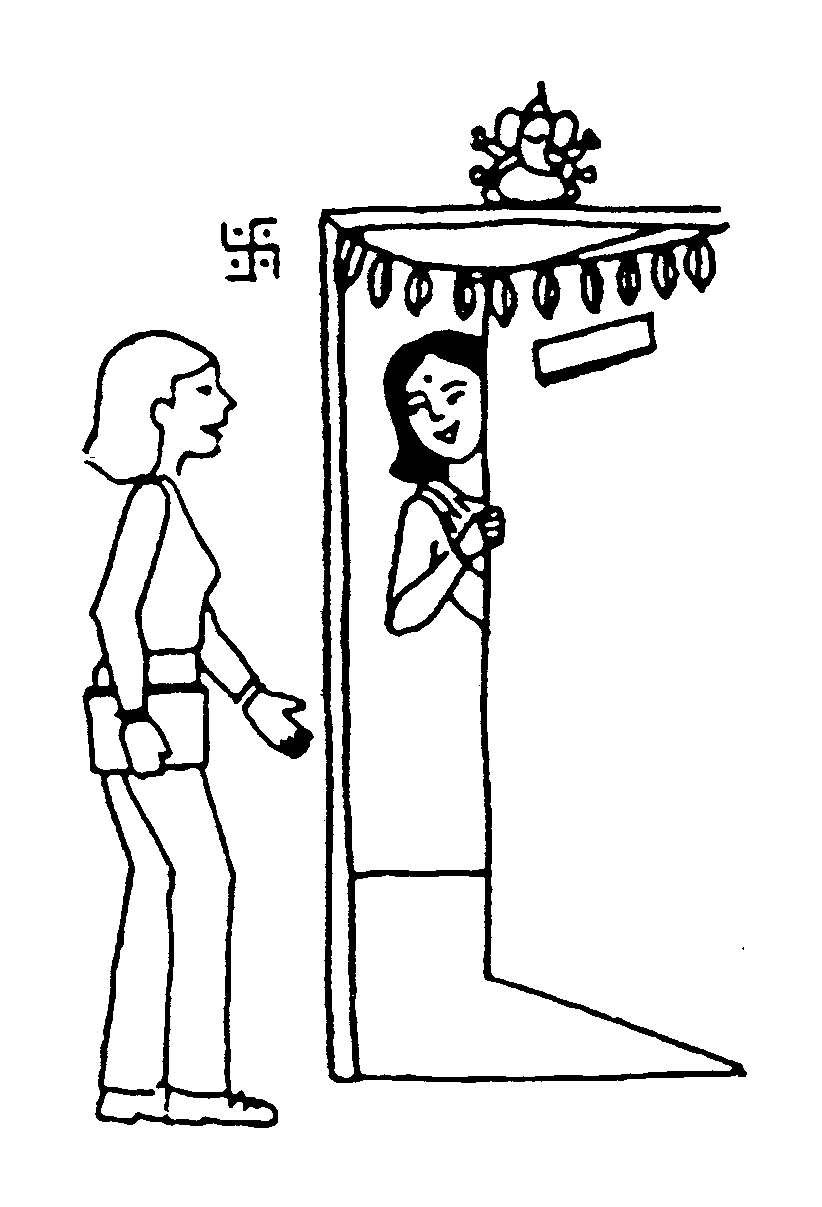 | 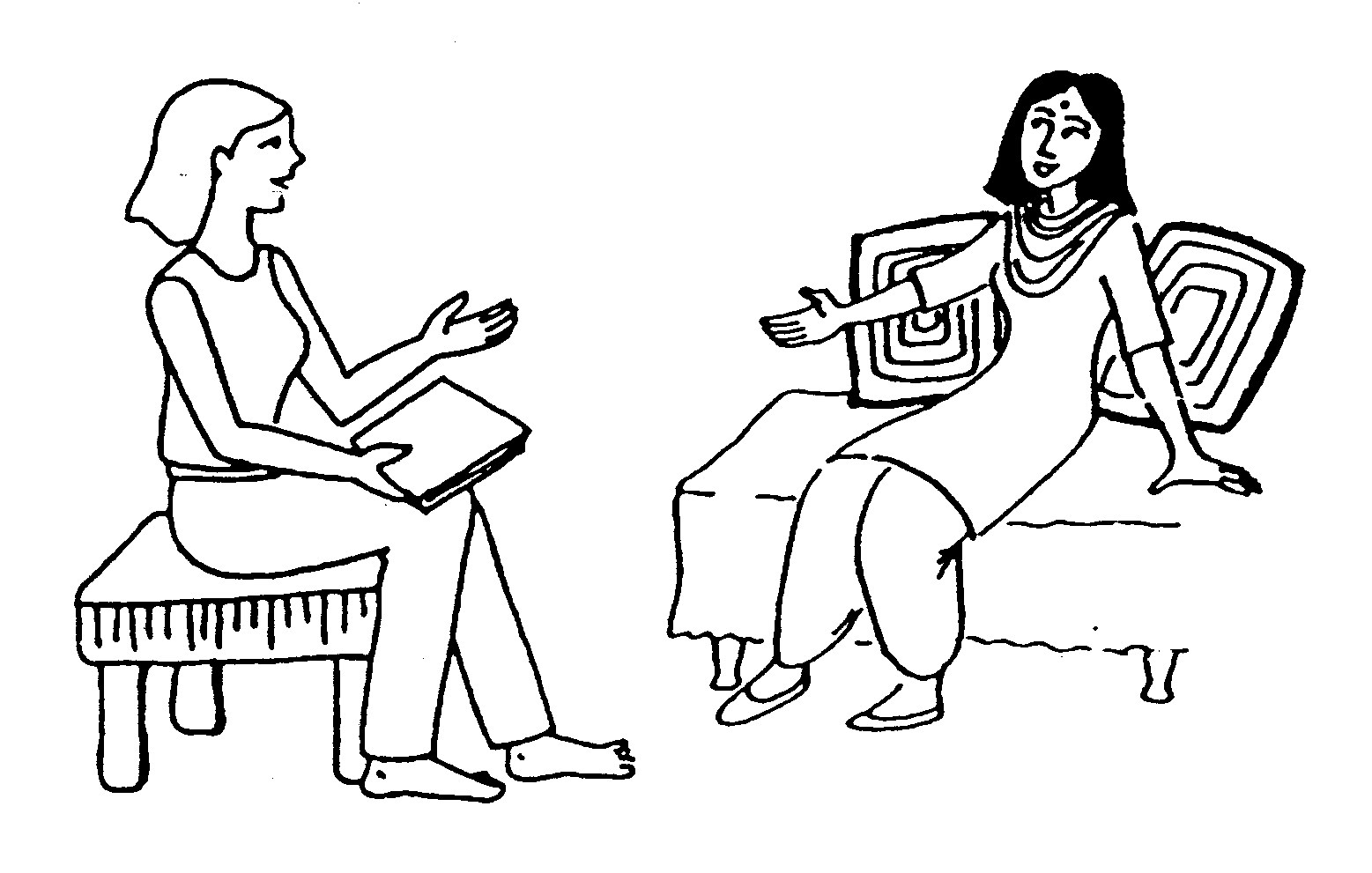 | |||
| A: | mi at yeu ka? | May I come in? | ||
| M: | ye ki ! bəs. | Come on in. Sit down. | ||
| kay mhəṇtos / mhəṇtes? | How are things? ['What do you say?'] | |||
| A: | səgə: ṭhik ahe. | Everything's fine. | ||
| tu kəsa / kəši ahes? | How are you? | |||
| M: | əgdi ṭhik. tu kay gheṇar - čəha ki kɔfi? | Just fine. What are you going to have-tea or coffee? | ||
| A: | mi čəha ghein. | I'll have tea. | ||
| 1. | A : | mi buṭ kaḍhu ka? | Should I take off my shoes? | |
| M : | ho, plij. | Yes, Please do. | ||
| A : | kuṭhe ṭhevu? | Where should I put them? | ||
| M : | tithec ṭhev. | Put them right there. | ||
| 2. | M : | mi kay deu - čəha ki kɔfi? | What shall I give (you) - tea or coffee? | |
| A : | čəha de. | Give me tea. | ||
| 3. | M : | tula kay deu - čəha ki kɔfi? | What can I give you - tea or coffee? | |
| A : | kahi nəko. phəktə paṇi de. | I don't want anything. Just give me water. | ||
| 4. | M : | tu kay gheṇar - čəha ki kɔfi? | What are you going to have - tea or coffee? | |
| A: | Kahi nəko. atta mi čəha gheun alo / ale. | I don't want anything. I've just had tea. ['Now I have taken tea and come'.] |
The Maharashtrian friend serves tea brewed with milk and sugar.

A more sophisticated hostess / host might ask you how you want your tea.
| M : | čəhat dudh pahiǰe ka? | Do you want milk in the tea? | |
| A : | nəko. | No, thank you. | |
| M : | aṇi sakhər? | And sugar? | |
| A : | sakhərhi nəko. | No sugar either. |
The guest takes leave.
| AS : | bərə: məg. mi yeto / yete. | Well then. I must get going. [I' come'.] | |
| M : | ye. udya bheṭu. | Do come. See you tomorrow. ['Tomorrow we will meet'.] |
Practice these conversational situations until you can get through them without prompting. Take turns acting out the roles of the host and of the guest so you are comfortable doing both. It helps to use some basic props as shown in the pictures. The following questions can guide you. Respond as appropriate.
A. As the guest is entering.
| mi at yeu ka? | |
| kay mhəṇtos / mhəṇtes? | |
| səgə: ṭhik ahe ka? | |
| tu kəsa / kəši ahes? |
B. Accepting tea or coffee.
| tu kay gheṇar - čəha ki kɔfi? | |
| mi kay deu - čəha ki kɔfi? |
C. Respond to the above questions, saying that you want nothing at all, or only water.
D. After accepting tea or coffee.
| čəhat dudh pahiǰe ka? | |
| čəhat sakhər pahiǰe ka? | |
| aṇkhi dudh pahiǰe ka? | |
| aṇkhi sakhər pahiǰe ka? |
E. As the guest is leaving.
| bərə:, mi yeto / yete. |
THE USE OF POLITE FORMULAS
English-speaking students of Marathi are often at a loss when they can find no Marathi equivalent for common polite formulas used in English, such as 'please', 'thank you', and 'excuse me'. It is true that there is no single Marathi word or phrase which is the equivalent of each of these English formulas, but the intention of these words is conveyed in Marathi by various linguistic or extralinguistic means (facial expressions, gestures, etc.).
A complete mastery of the nuances of polite speech requires, of course, a mastery of the Marathi language. But the following comments on the Marathi expression of the formulas mentioned above may serve to make you more sensitive to the ways of expressing courtesy in Marathi.
Please. In English one uses 'please' to make a request in contrast to an order. Marathi uses a variety of devices for this purpose. Some of these are listed below.
1) Sometimes a request is put in the form of a question. (Note that this is done in English also.)
| tu saŋgtos / saŋgtes ka? | Would you (pleased) tell (us)? |
2) Sometimes the adverb
| ənǰu, jəra ikəḍe ye. | Anju, please come here. | |
| jəra ikəḍe yetos / yetes ka? | Would you (please) come here? |
3) The particles
| tu ye na. | Please do come. | |
| ye ki. | Please do come. | |
| ye hə:. | Please come, won't you? |
4) The respectful imperative itself is a polite form, so often nothing else need be added.
| bəsa. | Please sit down. |
5) Occasionally the word
| buṭ kaḍhu ka? | Shall I take off my shoes? | |
| ho, plij. | Yes, please do. |
Thank you. 'Thank you' is used in English to mark the end of almost any social
transaction. For instance, if someone is given a cup of coffee s / he says 'thank
you;' if s / he asks for information and is given it s / he says 'thank you'. There is
no Marathi formula used in such situations. Westernized Maharashtrians will
sometimes say
Excuse me. In English 'excuse me' is used in a variety of situations, such as
leave-taking, apologizing for being late, or apologizing for bumping into someone.
For leave-taking there are a number of standard phrases used in Marathi,
including
VOCABULARY
Nouns
Adjectives
Adverbs
Verbs
Miscelleany
GRAMMAR NOTES
1. The irregular verbs
2. The addition of
SOCIOLINGUISTIC NOTE
Note that when the guest leaves s / he says
CULTURAL NOTE
In most houses it is customary to take off one's footwear. Sometimes in order to avoid inconveniencing a guest, a host might say it is all right to leave one's footwear on. Even then, it is better to take them off. Some people use special chappals or slippers in their own house.
16. I'm Going To The Coffee House
A Maharashtrian friend invites his / her American friend to come along to the Coffee House.
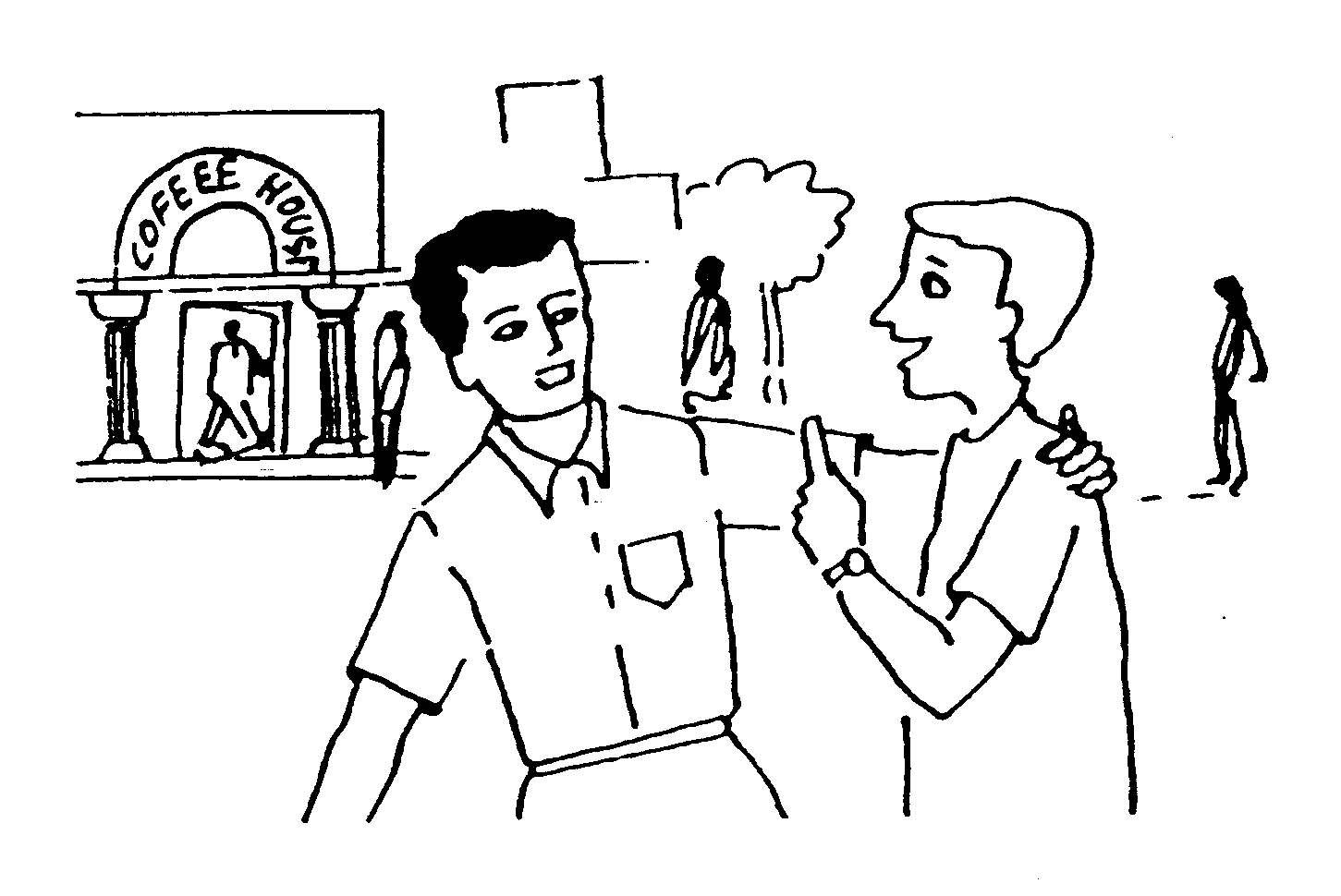
In the Coffee House the waiter brings the menu and the friends look it over.
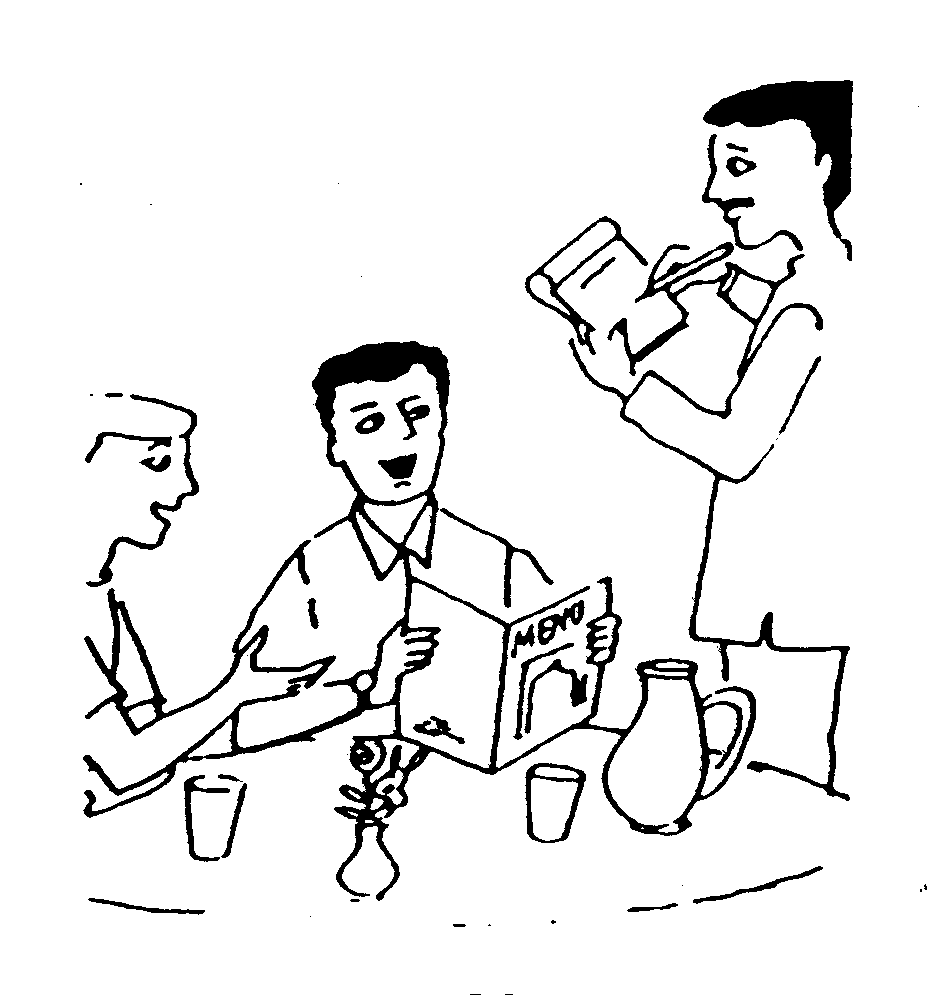
| A : | tu kay gheṇar (ahes)? | What are you going to have? | |
| M : | mi iḍli sambar gheṇar ahe. aṇi kɔfi. ithe kɔfi; phar čhan mite. | I'm going to have idli sambar. And coffee. You get very good coffee here. | |
| A : | mi kay gheu? tu saŋg. | What shall I have? You say. | |
| M : | uttəppa caŋgla mito. aṇi məsala ḍosa. aj tu ḍosa ghe. | You get good uttappa. And masala dosa. Today have a dosa. |
The waiter returns to take their order.
| W : | kay pahiǰe tumhala? | What do you want? | |
| M : | ek məsala ḍosa, ek iḍli sambar aṇi don kɔfi. aṇi ek bisleriči baṭli dya. | One masala dosa, one idli sambar and two coffees. And give (us) a bottle of Bisleri* too. | |
| W : | | kɔfi atta deu ka? | Shall I give the coffee right now? |
| M : | nəko, nəntər dya. | No, give it afterwards. |
Variation
| W : | kɔfi atta deu ka? | Shall I give the coffee right now? | |
| M : | calel. | OK. ['That will go.'] |
Udipi Snacks
Here is an abbreviated menu of some typical items you will find in an Udipi Restaurant, the type of South Indian restaurant found today throughout India.
| iḍli sambar | 15.00 | kɔfi | 5.00 | ||
| uttəppa | 20.00 | cəha | 5.00 | ||
| sadha ḍosa | 15.00 | pepsi | 15.00 | ||
| məsala ḍosa | 20.00 | limka | 15.00 | ||
| vəḍa sambar | 15.00 | bisleri | 20.00 | ||
| dəhi vəḍa | 10.00 | freš laim soḍa | 15.00 |
Practice these conversational situations until you can manage without prompting. Take turns acting out the role of the two friends and the waiter. It helps to use some basic props as shown in the pictures. Also be sure to use the Udipi Snacks menu above. The following questions can guide you. Respond as appropriate.
a. The invitation.
| mi kofi hausla jato'e / jate'e. | |
| cəl maǰhya bərobər. | |
| maǰhya bərobər kɔfi hausla cəl. |
b. Looking over the menu.
| tu kay ghenar ahes? | |
| mi kay gheu? | |
| tula kay pahije? | |
| kay canglə: miltə:? | |
| ... canglə: ahe ka? |
c. Giving your order to the waiter.
| kay pahiǰe tumhala? | |
| kɔfi atta deu ka? |
Some Other Requests
Here are some other requests you might want to make to a waiter in a restaurant. (Of course, don't go overboard and try all of these on the same occasion!)
| jəra næpkin deta ka? | Would you please give some napkins? | |
| jəra pəŋkha calu kərta ka? | Would you please turn on the fan? | |
| jəra pəŋkha bəndə kərta ka? | Would you please turn off the fan? | |
| jəra ṭebəl pusta ka? | Would you please wipe the table? |
Include the request above in your role play of the restaurant situation. The student taking the part of the waiter should say s / he will do as requested, and should then pantomime the action.
VOCABULARY
Nouns
Adjectives
Verbs
Adverbs, postposition, particles
17. How Much Has It Come To?
The waiter brings the bill.
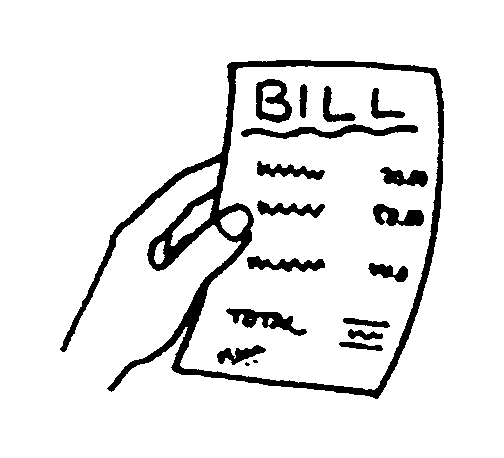
The friends decide to go Dutch.
| A: | kiti pəise jhale? | How much did it come to? | |
| M: | saṭh rupəye. | Sixty rupees. | |
| maǰhyajəvə phəktə šəmbhərči noṭ ahe. | I have only a hundred rupee note. | ||
| tuǰhyajəvə tis rupəye ahet ka? | Do you have thirty rupees? | ||
| A: | ho, ahet. he ghe. aṇi ṭip? | Yes. I do. Here, ['Take this']. And for the tip? | |
| M: | čar rupəye deu ya. | Let's give four rupees. |
Practice the two conversational situations above until you can manage without prompting. Take turns acting out the roles of the two friends. The following can be used as cues.
| kiti pəise jhale? | |
| majhe tis rupəye ghe ki! | |
| tuǰhyajəvə tis rupəye ahet ka? | |
| aṇi ṭip? |
Expression of 'To Have'
In Marathi there are a number of different ways to express 'to have', depending on what is possessed. In this chapter we have sentences expressing one sense of 'to have'.
| maǰhyajəvə phəktə šəmbhərči noṭ ahe. | I have only a hundred rupee note. | |
| tuǰhyajəvə tis rupəye ahet ka? | Do you have thirty rupees? | |
| ho, ahet. | Yes, I do. |
The first sentence above would be translated literally as 'Near me only a hundred- rupee note is'. This expression is generally used in reference to possession of small items (often, though not necessarily, carried on one's person) such as money, a pen, or a calculator.
Note that in order to add the postposition -
Indian Currency
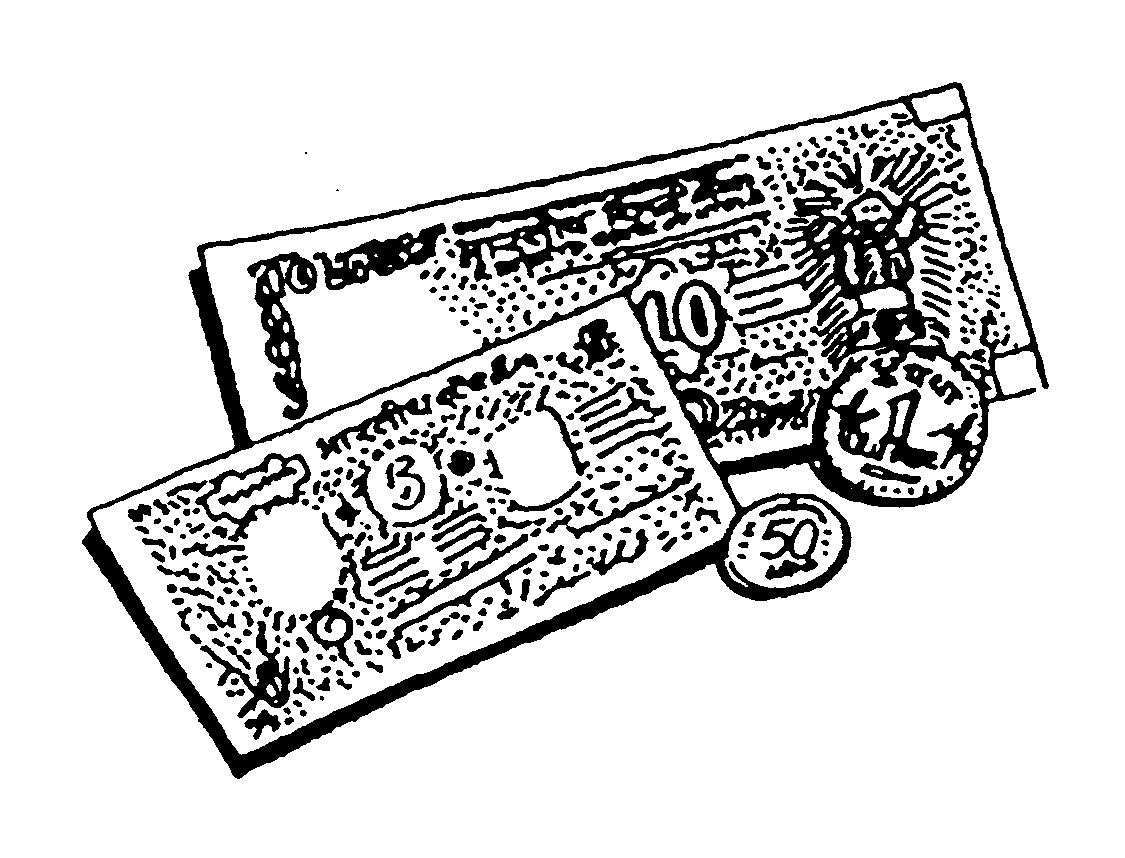 In India, cash is used more often than checks or credit cards. In day to day
transactions, a lot of cash in the form of coins and notes (bills) changes hand.
In India, cash is used more often than checks or credit cards. In day to day
transactions, a lot of cash in the form of coins and notes (bills) changes hand.
Coins come in the denominations of five, ten, twenty, twenty-five and fifty paise. There are coins for one, two and five rupees as well.
Currency notes come in the denominations of one, two, five, ten, twenty, fifty, one hundred and five hundred rupees. Unlike the U.S. dollar bills, each denomination note has a different size and a distinctive color of its own. The size of a note is correlated with its value. A one rupee note is the smallest and a five hundred rupee note is the largest one.
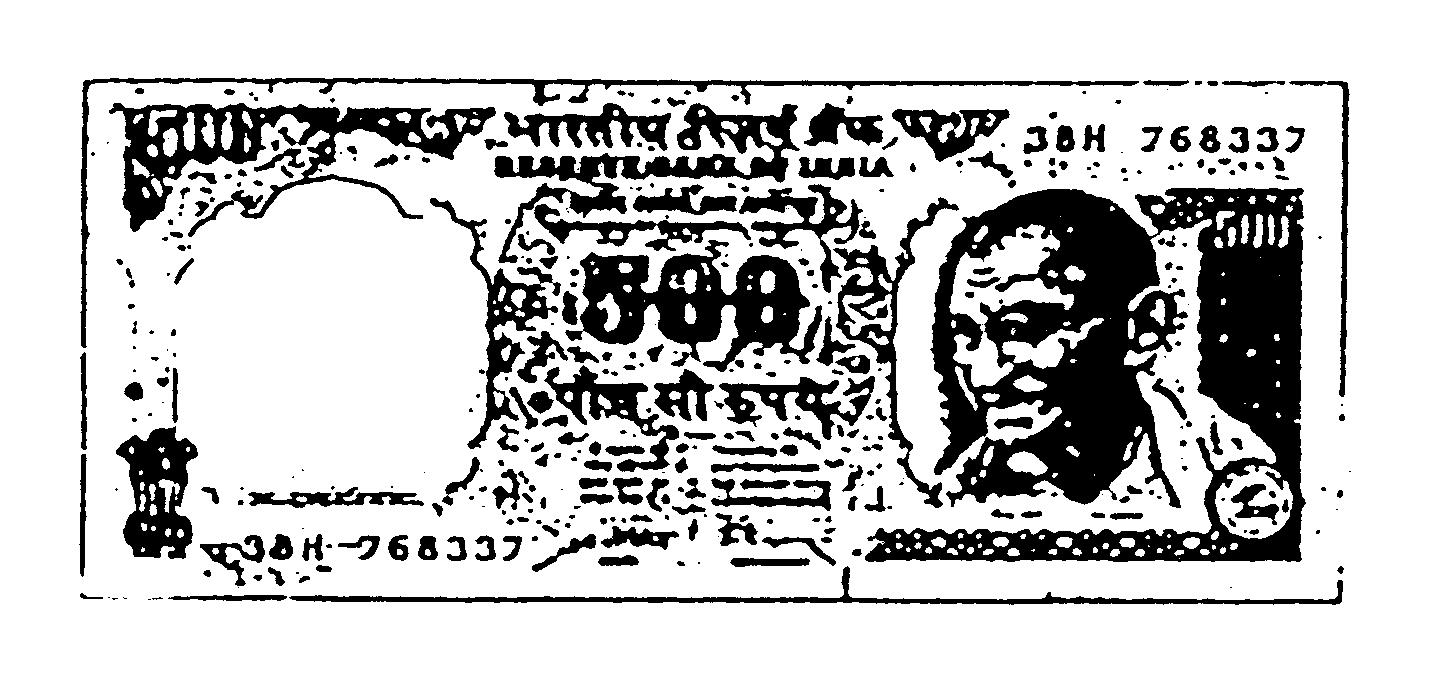
Either the instructor or each student should make individual 'wallets' of Indian currency using various of the common denominations. You can use either real currency notes and coins or play money. Now go round the class each asking the next in turn if he / she has the following amounts of money. Use the expression of "To have' that has been illustrated before.
| ek rupəya | |
| don rupəye | |
| pac rupəye | |
| dəha rupəye |
With the additional numbers given below, you can increase the range of this exercize considerably.
Numbers
11 to 20
| əkra | 11 | soa | 16 | ||
| bara | 12 | sətra | 17 | ||
| tera | 13 | əṭhra | 18 | ||
| cəuda | 14 | ekoṇis | 19 | ||
| pəndhra | 15 | vis | 20 |
a. Practice counting from one to twenty.
b. Give the Marathi word for each of the following.
| 5 | 7 | 20 | 1 | 17 |
| 8 | 11 | 13 | 6 | 4 |
| 9 | 2 | 15 | 10 | 19 |
| 3 | 16 | 18 | 12 | 14 |
c. Use the numbers above in the frame
Numbers
10 to 100 (by tens)
| dəha | 10 | saṭh | 60 | ||
| vis | 20 | səttər | 70 | ||
| tis | 30 | əĩši | 80 | ||
| čais | 40 | nəvvəd | 90 | ||
| pənnas | 50 | šəmbhər | 100 |
d. Practice counting by ten's to 100.
e. Give the Marathi word for each of the following.
| 30 | 100 | 50 | 40 | 80 |
| 80 | 20 | 10 | 70 | 60 |
f. Ask each other
g. Now you can take turns role-playing the Coffee House situation from invitation to paying the bill. Make sure to consult the menu and its prices. The 'waiter' should write up and present a bill for the appropriate amount. Decide how you'll pay it and how much to leave as a tip.
The American looks at the green seeds that came with the bill.
| A: | he kay ahe? | What is this? | |
| M: | hi bəḍišep - mhəṇǰe ænis. čhan lagte. khaun bəgh. | It's bəḍišep - that is anise It tastes good. Try it and see ['Eat and see']. | |
| A: | [gingerly tasting a bit] | ||
| khərə:c, čhan lagte! | It really does taste nice! |
VOCABULARY
Nouns
Adjective
Verbs
Miscellany
Phrases and Sentences
Numbers
11 to 20
| əkra | 11 | |
| bara | 12 | |
| tera | 13 | |
| cəuda | 14 | |
| pəndhra | 15 | |
| soa | 16 | |
| sətra | 17 | |
| əṭhra | 18 | |
| ekoṇis | 19 | |
| vis | 20 |
10 to 100 (by tens)
| dəha | 10 | |
| vis | 20 | |
| tis | 30 | |
| čais | 40 | |
| pənnas | 50 | |
| saṭh | 60 | |
| səttər | 70 | |
| əĩši | 80 | |
| nəvvəd | 90 | |
| šəmbhər | 100 |
18. Do You Have Any Brown Bread?
The friends leave the Coffee house and go to the nearby Kayani Bakery. The Maharashtrian friend talks to the bakery clerk.
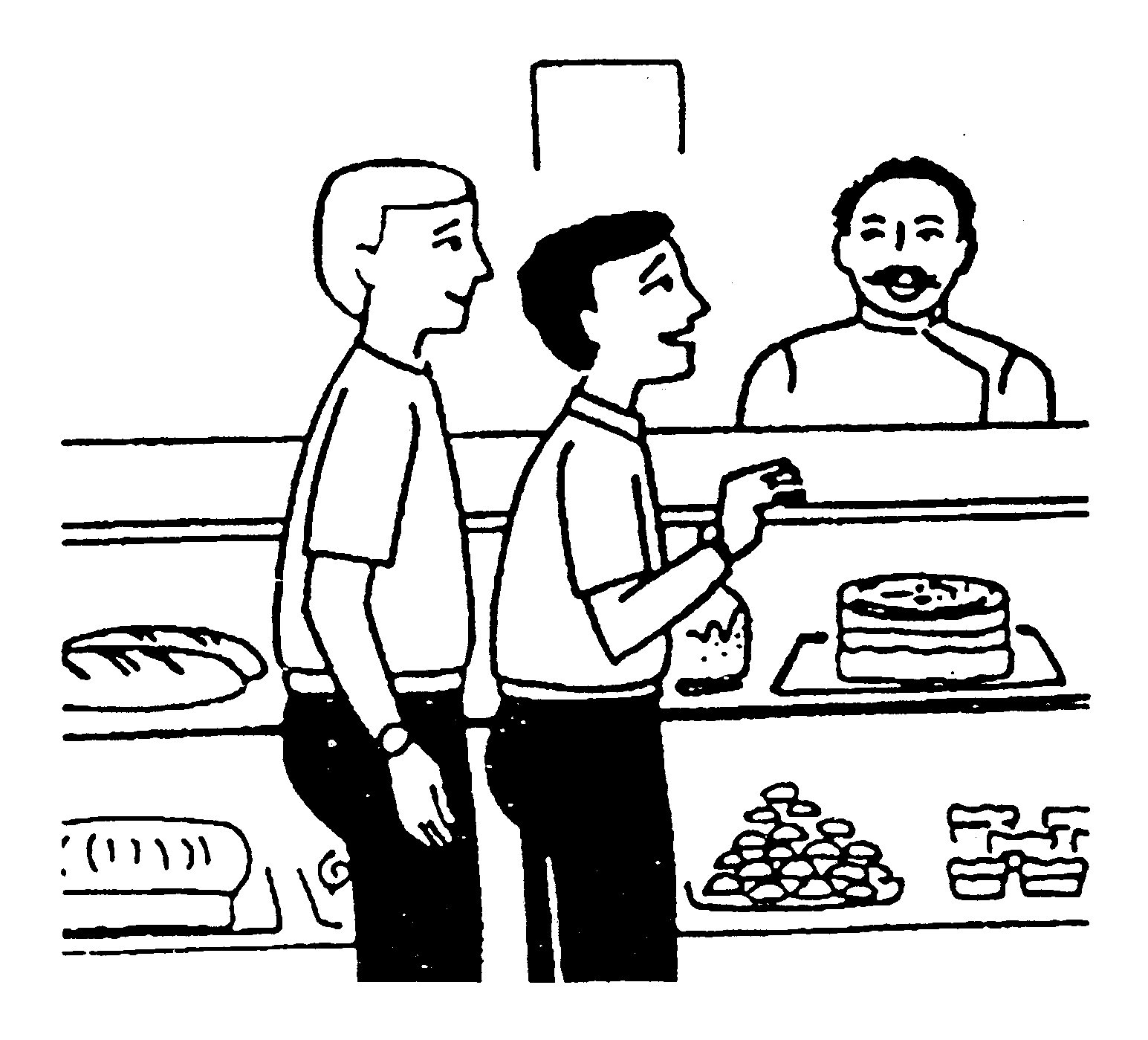
Expression of 'To Have'
Here we have another slightly different way of expressing 'to have'.
Structurally it is identical to the pattern you learned in the last chapter using
the postposition -
Note that here also, before the postposition -
Take turns playing roles of the Maharashtrian friend and the bakery clerk. You can vary the conversation by asking for some of the other items listed for sale in the bakery.
| šrujhbəri biskiṭə: | shrewsbury biscuits | Rs. 80 / kg. | |
| vain biskiṭə: | wine biscuits | Rs. 40 / kg. | |
| čij biskiṭə: | cheese biscuits | Rs. 60 / kg. | |
| bənj | buns | Rs. 1.00 ea. | |
| mava kek | mava cake | Rs. 4.00 ea. |
In a General Store
In Pune (and, in fact, throughout Maharashtra) the institution of the general store has developed in the last few years. While less elaborate than the American department store, the general store carries a variety of items, including packaged food (not fresh produce), toiletries, kitchenware, electronic goods, etc. The Super Shoppe in Deccan Gymkhana, and Atlantic Stores, Dorabjee's and Chandan in the Camp are the best known of these. Most of those shops have computerized checkout systems. Here are some items you may find yourself buying.
| pinəṭ bəṭər | peanut butter | |
| are čij | Arey cheese* | |
| kæḍbəri čɔkleṭ | Cadbury chocolate | |
| sinthɔl sabəṇ | Cinthol soap | |
| lakme šæmpu | Lakme shampoo |
The two friends go from the bakery to the nearby general store. The American talks to the store clerk.
| A: | tumčya kəḍe sabəṇ ahe ka? | Do you have any soap? | |
| SC: | ho. sinthɔl sabəṇ calel ka? | Yes, will Cinthol soap do? | |
| A: | hyači kimmət kay ahe? | What is it's price? | |
| SC: | vis rupəye. | Twenty rupees. | |
| A: | ṭhik ahe. ha gheto / ghete. | Fine. I'll take it. | |
| SC: | aṇkhi kay pahiǰe? | What more would you like? | |
| A: | aṇkhi kahi nəko. | I don't want anything more. |
Using the pattern of the conversation above, take turns 'shopping' at the general store for the listed items. Make sure to take your 'wallet' of Indian currency with you. As you gain familiarity, you might add items from earlier vocabulary lists. Eventually you might want to try the role of the store clerk.
Numbers
5 to 100 (by fives)
| pac | 5 | pəncavənnə | 55 | ||
| dəha | 10 | saṭh | 60 | ||
| pəndhra | 15 | pasəšṭ | 65 | ||
| vis | 20 | səttər | 70 | ||
| pənčvis | 25 | pənčahəttər | 75 | ||
| tis | 30 | əĩši | 80 | ||
| pəstis | 35 | pančyaəiši | 85 | ||
| čais | 40 | nəvvəd | 90 | ||
| pənčečais | 45 | pənčaṇṇəv | 95 | ||
| pənnas | 50 | šəmbhər | 100 |
While
| donše | 200 | |
| tinše | 300 | |
| čarše | 400 |
This pattern is regular up to 900. For 1000 the expression is
Other numerical expressions with 100 regularly use
| ekše ek | 101 | |
| ekše pac | 105 | |
| donše tis | 230 | |
| čarše pənčvis | 425 | |
| pacše pənnas | 550 |
a. Practice counting from 5 to 100 by fives.
b. Practice counting from 100 to 1000 by hundreds.
c. Give the Marathi names for each of the following numbers.
| 35 | 15 | 50 | 60 | 10 | 85 |
| 70 | 85 | 25 | 80 | 30 | 20 |
| 65 | 40 | 75 | 95 | 45 | 100 |
| 90 | 55 | 101 | 220 | 305 | 595 |
| 105 | 225 | 315 | 707 | 115 | 240 |
| 330 | 620 | 120 | 285 | 390 | 1,000 |
d. Repeat the general store conversation, selecting a number of items and calculating the price.
VOCABULARY
Nouns
Adjectives
Pronouns
Postpositions
-
Verbs
Interjections
Numbers
WORD STUDY
1. As you have already noticed, Marathi uses a great number of English words -
nouns in particular. These words have been assimilated into the language in
varying degrees. Some, like
2. For 'bread' the word
19. Grammar
A) CLASSIFICATION OF VERBS
In the first two units the major verb we dealt with was the auxiliary verb. In this unit we have taken up the set of main verbs.
Marathi verbs just as English verbs can be divided into two classes - transitive and intransitive - according to whether or not they take a direct object.
Transitive verbs are those that can take a direct object; intransitive verbs are those that cannot. In our vocabulary lists transitive verbs are labeled v.t.; intransitive verbs are labeled v.i. A simple devise for determining if a verb is transitive or intransitive is the question '(verb) what?' For example, 'Eat what?' makes sense while 'Sit what?' doesn't. The former is transitive, the latter intransitive.
B) THE IMPERATIVE
Throughout this unit we have used many imperative (command) forms.
| ye. | Come. | |
| bəs. | Sit down. | |
| čəha ghe. | Have ['take'] (some) tea. | |
| dar lav. | Close the door. | |
| maǰhyabərobər cəl. | Come along with me. | |
| ek miniṭ thamb. | Wait a minute. |
Note that in the Marathi sentences direct objects and adverbial phrases usually precede the verb, while in English they follow the verb.
The imperative is, of course, a second person form. It can be either in the singular or the plural - that is, addressed to one person or more than one. As we have already mentioned, the imperative singular is used only for the familiar, while the plural is used for both actual plurality and respect.
The example sentences above are all in the imperative singular (familiar). The corresponding sentences in the imperative plural (or respectful) would be as follow.
| ya. | |
| bəsa. | |
| čaha ghya. | |
| dar lava. | |
| maǰhyabarobar cəla. | |
| ek miniṭ thamba. |
Formation of the Imperative
imperative singular. The imperative singular is simply the verbal base, which in this text we indicate as V.
| V | Imper. sg. | ||
| ye- | ye | ||
| bəs- | bəs | ||
| ghe- | ghe | ||
| lav- | lav | ||
| cəl- | cəl | ||
| thamb- | thamb | ||
With very few exceptions, verbs are regular in the imperative singular. For the
imperative singular of
Imperative plural. The imperative plural is formed by adding a to the verbal base.
| V | Imper. pl. | ||
| bəs- | bəsa | ||
| lav- | lava | ||
| cəl- | cəla | ||
| thamb- | thamba | ||
In the case of verbal bases ending in a vowel, several morphophonemic rules apply to the formation of the imperative plural. The rules covering those verbs which have been introduced so far are given below.
1. i and e becomes y before the addition of a.*
| V | Imper. pl. | ||
| ghe- | ghya | ||
| de- | dya | ||
| ye- | ya** | ||
2. The combination of a+a remains a.
| V | Imper. pl. | ||
| ja- | ja | ||
| kha- | kha | ||
3. v is added to u before the addition of a or u.
| V | Imper. pl. | ||
| dhu- | dhuva | ||
4. In a word of two or more syllables ending in the sequence Vw CVwC, if the second vowel is ə or short i or u, it is deleted before a vowel.
So far the only verbs we have introduced which are covered by this rule are those in which the second vowel is ə.
| V | Imperative pl. | ||
| ughəḍ- | ughḍa | ||
| dakhəv- | dakhva | ||
Note that this rule refers to pronounciation, not to writing in the Devanagari script.
C) REQUEST FOR INSTRUCTION
The imperative is often used in response to a question.
| mi at yeu ka? | May I come in? | |
| ye ki! | Yes, come! | |
| mi aṇkhi sakhər ghalu ka? | Shall I put in some more sugar? |
The question is the first person counterpart of the imperative - a first person imperative, if you will.
Note that the first example above is translated in English with 'may,' while the second is translated with 'shall'. When a speaker asks 'may I ...,' s / he is asking for permission; when the speaker says 'shall I ...,' s / he is asking what to do. Marathi does not distinguish between these two meanings, but uses the same construction for both. We shall term this construction the request for instruction.
Affirmative and negative answers. Note that in giving an affirmative answer to a
request for instruction it is not necessary to use
| mi at yeu ka? | |
| ye. |
To add emphasis, a speaker may add an emphatic particle:
In giving a negative answer to a request for instruction, a speaker will generally
use the introductory negative
| mi kɔfi atta deu ka? | Shall I give you the coffee now? | |
| nəko, nəntər dya. | No, give it later. | |
| mi aṇkhi dudh ghalu ka? | Shall I put in some more milk? | |
| nəko, pure. | No, that's enough. |
Formation of request for instruction. The formula for the request for instruction is:
| mi V-u ka? | May / shall I V? |
All verbs are regular in this form. However, the morphophonemic rules for the deletion of ə applies, as does the rule for the insertion of v.*
| V | V-u | ||
| ughəd- | ughdu | ||
| dakhəv- | dakhvu | ||
| dhu- | dhuvu | ||
Interrogative word questions. The formula above is for the request for instruction in a yes-no question. When the request for instruction is used with an interrogative word the pattern is:
| mi K V-u? | K shall I V? |
(K stands for any interrogative word.)
| mi kay deu - čəha ki kɔfi? | What shall I give (you) tea or coffee? | |
| mi kay gheu? | What shall I take? |
D) REQUESTS WITH THE IMPERFECT A
As long as the imperative is used in response to a request for instruction, there is little danger of its being understood as a peremptory command. However, there are times when we want to ask someone to do something, and we want to make it clear that we are making a request, not a command. In this case we can use sentences like the following.
| tumhi pərət vičarta ka? | Would you ask again? | |
| jəra pəŋkha calu kərta ka? | Would you (please) turn on the fan? | |
| jəra ṭebəl pusta ka? | Would you (please) wipe the table? |
The answer to the above questions would be:
| (mi) vičarto / vičarte. | |
| (mi) calu kərto / kərte. | |
| (mi) pusto / puste. |
The sentences employ a verb form that in this book is called the Imperfect A. Note that in the first person (in this context) the sense is that the speaker is announcing something s / he is about to do immediately.
The use of this construction is not limited to responding to a question in the Imperfect A.
| maǰhyabərobər cəl. | Come with me. | |
| yeto / yete. | I'll be right there. |
Note that in the equivalent English sentence the future is used. Note too that in
the Marathi sentence the subject
Announcing an action that one is about to perform is only one use of the imperfect A. The more important use of the Imperfect A is for expressing habitual action.
| tumhi məraṭhi bolta ka? | Do you speak Marathi? | |
| ho, thoḍəsə: bolto / bolte. | Yes, I speak a little. | |
| tumhala məraṭhi yetə: ka? | Do you know Marathi? ['Does Marathi come to you?'] | |
| khiḍkitun kay distə:? | What do you see through the window? | |
| jhaḍ distə:, pəkši distat. | You see a tree and you see birds. | |
| kay mhəṇtos / mhəṇtes? | What do you say? | |
| ithe kɔfi čhan mite. | You get good coffee here. | |
| uttəppa caŋgla mito. | You get good uttappa. |
This use of the Imperfect A will be taken up in detail in Unit Five.
E) THE IMPERFECT B 'PRESENT CONTINUOUS'
You may have noticed a discrepancy between the Marathi srcipt and the phonetic rendering at the beginning of the conversation 'I'm going to the coffee house.'
| mi kɔfi hausla jato'e / jate'e. | I'm going to the Coffee House. |
The ending
F) THE PROSPECTIVE
Note the expression of intention in the verbs in these sentences.
| tu kay gheṇar - | What are you going to | |
| čəha ki kɔfi? | have - tea or coffee? | |
| tu kay gheṇar (ahes)? | What are you going to have? | |
| mi iḍli sambar gheṇar ahe. | I'm going have idli sambar. |
Any Marathi verb can be used in this same pattern - the verbal base with the
ending -
G) THE PERFECT
In this unit we have had several more examples of the use of the Perfect, a construction used to express completed action.
| mi čəha gheun alo / ale ahe. | I have had tea. ['I have taken tea and come.'] | |
| kiti pəise jhale? | How much did it come to? | |
| braun breḍ səmpla ahe. | The brown bread is finished. |
PATTERN PRACTICE
A. The following sentences are all in the familiar imperative. Change them to the respectful.
| bəs. | |
| cəl. | |
| maǰhyabərobər ye. | |
| čəha de. | |
| kɔfi ghe. | |
| thoḍəsə: dudh ghal. | |
| sadha ḍosa de. | |
| khiḍki ughəḍ. | |
| pustək dakhəv. | |
| pərət mhəṇ. |
B. Use the imperative form of the verb given with each of the direct objects suggested. Do the exercise twice, once with the familiar, and once with the respectful. To test yourself cover the Marathi names of things.
| bəgh- | ||
| nəkaša | map | |
| pustək | book | |
| vəhi | notebook | |
| pen | pen | |
| bæg | bag |
| de - | ||
| ek iḍli sambar | one idli sambar | |
| don kɔfi | two coffee | |
| thoḍi sakhər | a little sugar | |
| ek baṭli paṇi | one bottle of water | |
| tis rupəye | thirty rupees |
| lav- | |||
| dar | door | ||
| khiḍki | window | ||
| reḍio | radio | ||
| diva | lamp | ||
| kulup | lock |
| lih- / lihi- | ||
| nav | name | |
| šəbdə | word | |
| vakyə | sentence | |
| prəšnə | question | |
| uttər | answer |
| dakhəv- | ||
| nəkaša | map | |
| gav | town | |
| bajarpeṭh | businss district | |
| deu | temple | |
| dukan | shop |
| ghal- | ||
| dudh | milk | |
| paṇi | water | |
| sakhər | sugar | |
| čəha | tea | |
| kɔfi | coffee |
| kha- | ||
| iḍli | ||
| ḍosa | ||
| vəḍa | ||
| dəhi vəḍa | ||
| uttəppa |
| ghe- | ||
| kɔfi | coffee | |
| čəha | tea | |
| dudh | milk | |
| paṇi | water | |
| freš laim soḍa | fresh lime soda |
C. Using the verbs or verb phrases below, construct questions of the pattern mi V- u ka? Have another student answer, using the familiar imperative. Repeat the exercise, using the respectful imperative.
| 1. | ye- |
| 2. | de- |
| 3. | pustək bəgh- |
| 4. | bəḍišep khaun bəgh- |
| 5. | thamb- |
| 6. | dar lav- |
| 7. | pəŋkha bəndə kər- |
| 8. | məraṭhit bol- |
| 9. | hi vahi ghe- |
| 10. | prəšnə vičar- |
D. Using the verbs and verb phrases below, construct questions of the pattern mi kay V-u? Have another student answer each question, giving the answer suggested.
| 1. | de- phəktə paṇi |
| 2. | de- kɔfi |
| 3. | ghal- thoḍi sakhər |
| 4. | ghe- vəḍa sambar |
| 5. | kiti pəise de- dəha rupəye |
| 6. | dakhəv- puṇyaca nəkaša |
| 7. | vac- he pustək |
| 8. | lih- / lihi- hi vakyə: |
| 9. | de- pen |
| 10. | paṭh kər he šəbdə |
E. Use each verb or verb pharse below in the first person singular of the Imperfect A, indicating that you are about to perform the action in question.
| 1. | ye- |
| 2. | thamb- |
| 3. | čəha de- |
| 4. | paṇi de- |
| 5. | kholi dakhəv- |
| 6. | saŋg- |
| 7. | prəšnə vičar- |
| 8. | uttər de- |
| 9. | vakyə vacun dakhəv- |
| 10. | šəbdə lihun dakhəv- |
F. The following sentences are all in the respectful imperative. Recast each
sentence as a polite request in the Imperfect A, prefacing it with
| 1. | prəšnə pərət vicara. |
| 2. | savkaš bola. |
| 3. | pərət mhəṇa. |
| 4. | he vakyə vacun dakhva. |
| 5. | to šəbdə lihun dakhva. |
| 6. | ṭebəl pusa. |
| 7. | pənkha bəndə kəra. |
| 8. | don minṭə: thamba. |
G. The following sentences are in the familiar imperative. Recast them in the
Imperative A, using either the masculine or feminine, as is appropriate for
your partner; e.g.,
| 1. | thamb. |
| 2. | bəs. |
| 3. | prəšnə vičar. |
| 4. | uttər de. |
| 5. | ha šəbdə mhəṇ. |
Unit Five
Getting Better Acquainted
20. Where Do You Live?
An American student meets a Maharashtrian woman from Pune on a train. In the course of the conversation the American asks the Maharashtrian where she lives.
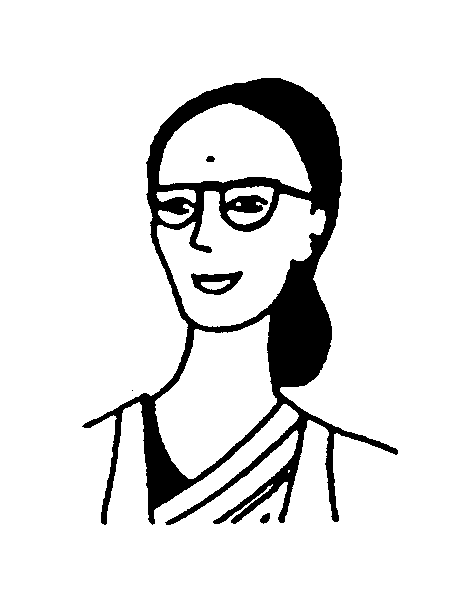
| A: | tumhi kuṭhe rahta? | Where do you live? | |
| M: | šənivar peṭhet - polis cəukijəvə. | In Shaniwar Peth - near the police station. |
| A: | tumhi kuṭhe rahta? | Where do you live? | |
| M: | erəṇḍəvṇyala - inkəm ṭæks ɔfissəmor. | In Erandawana - across from the Income Tax Office. | |
| A: | tumca pətta kay? | What is your address? | |
| M: | tinše apɔn pac senapəti bapəṭ marg. | 300 / 5 Senapati Bapat Marg. |
A. Practice the conversation as originally given, and with the variations.
B. Draw an identity card. Go around your class or group each in turn asking your neighbor where they live.
C. Go to each member of the class and find out where they live as indicated by their identity cards. Be sure to also tell where you live when asked in return.
A Maharshtrian asks an American where s / he is staying in Pune.
| M: | tumhi hɔṭelmədhe rahta ka? | Do you stay in a hotel? | |
| A: | nahi, me el. en. jošinkəḍe rahto / rahte. | No, I stay at L.N. Joshi's. | |
| M: | mhəṇǰe kuṭhe? | Where is that? ['That means where?'] | |
| A: | ṭiək roḍvər. | On Tilak Road. |
| M: | tumhi hɔsṭelmədhe rahta ka? | Do you stay in a hostel? | |
| A: | nahi, mi eka fæmilikəḍe rahto / rahte - profesər prədip bhoslyankəḍe. | No, I stay with a family - at Prof. Pradip Bhosale's. |
| M: | te kuṭhe rahtat? | Where do they live? | |
| A: | kothruḍla. | In Kothrud. |
A. Practice the conversation and variation given above.
B. Select an identity card. Consider this your host family, and in answer to the
question
VOCABULARY
Verbs
Postposition
-
-
-
Names
WORD STUDY
The postposition; -
21. What Do You Do?
An American student asks a Maharashtrian what s / he does.
| A : | tumhi kay kərta? | What do you do? | |
| M : | mi kɔmpyuṭər inǰiniər ahe. | I am a computer engineer. | |
| A : | tumhi nokəri kərta ka? | Are you employed somewhere? ['Do you do service?'] | |
| M : | nahi, majha svətəhəca vyəvəsay ahe. | No, I have my own business. | |
| A : | tumcə: ɔfis kuṭhe ahe? | Where is your office? | |
| M : | sədašiv peṭhet. | In Sadshiv Peth. |
An American student meets a Maharashtrian student.
| A : | tumhi kay kərta? | What do you do? | |
| M : | mi vidyarthi / vidyarthini ahe. | I am a student. | |
| A : | tumhi kuṭhe šiktay? | Where are you studying? | |
| M : | es. pi. kɔleǰmədhe. | In S.P. College. |
An American student meets a Maharashtrian farmer.
| A : | tumhi kay kərta? | What do you do? | |
| M : | mi šeti kərto. | I farm. | |
| A : | tumči jəmin ahe ka? | Do you own land? | |
| M : | ahe nə. | I do indeed. | |
| A : | kuṭhe? | Where? | |
| M : | aəndijəvə. | Near Alandi. |
People of Various Occupations
The people below are all responding to the question
tumhi kay kərta?
mi profesər ahe. mi rəsayənšastrə šikəvte. I am a professor. I teach chemistry. |  |
mi profesər ahe. mi itihas šikəvto. I am a professor. I teach history. | 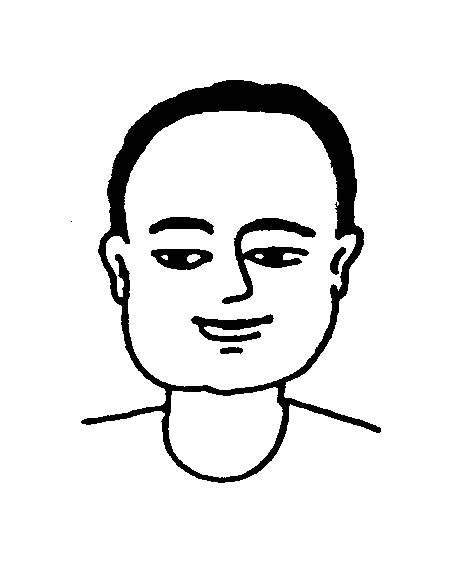 |
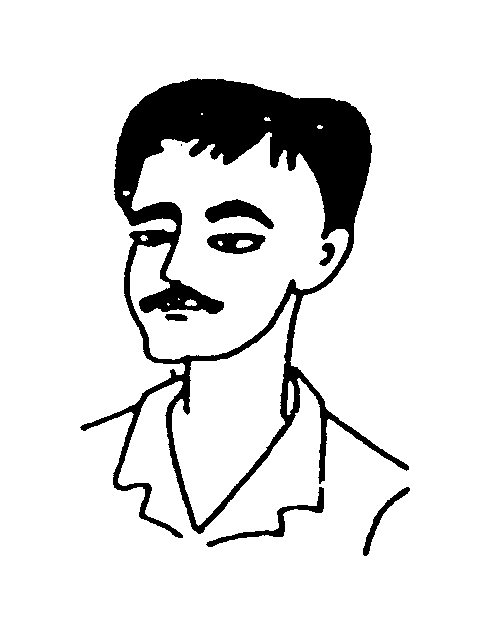 | majhə:ḍi. ti. pi. yuniṭ ahe. I have a Data Processing Unit. |
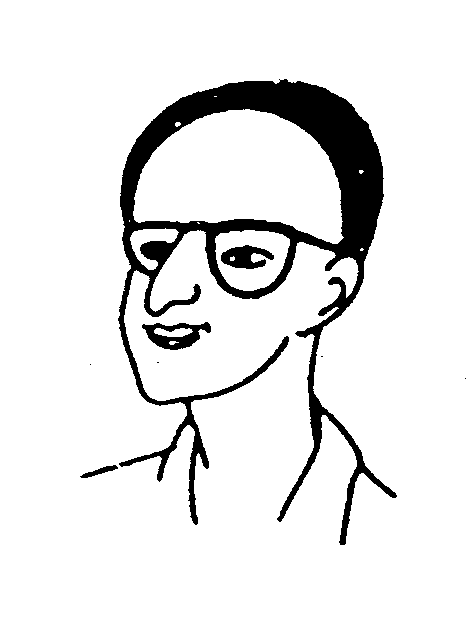 | mi əkəuṇtəṇṭ ahe. I am an accountant. |
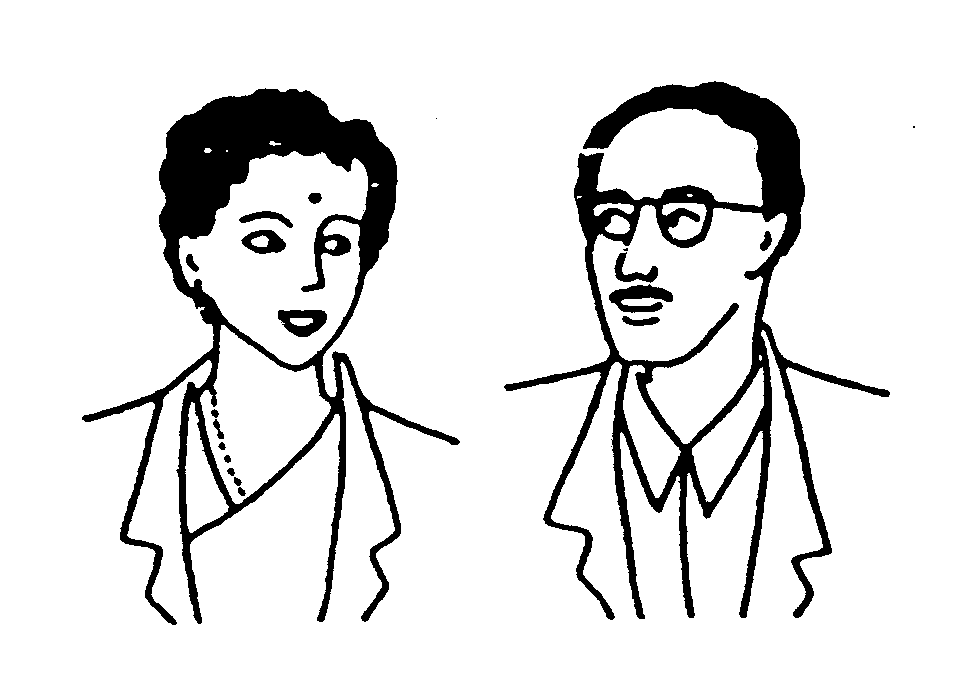 | amhi doghe ḍɔkṭər ahot. We are both doctors. |
Other Professions
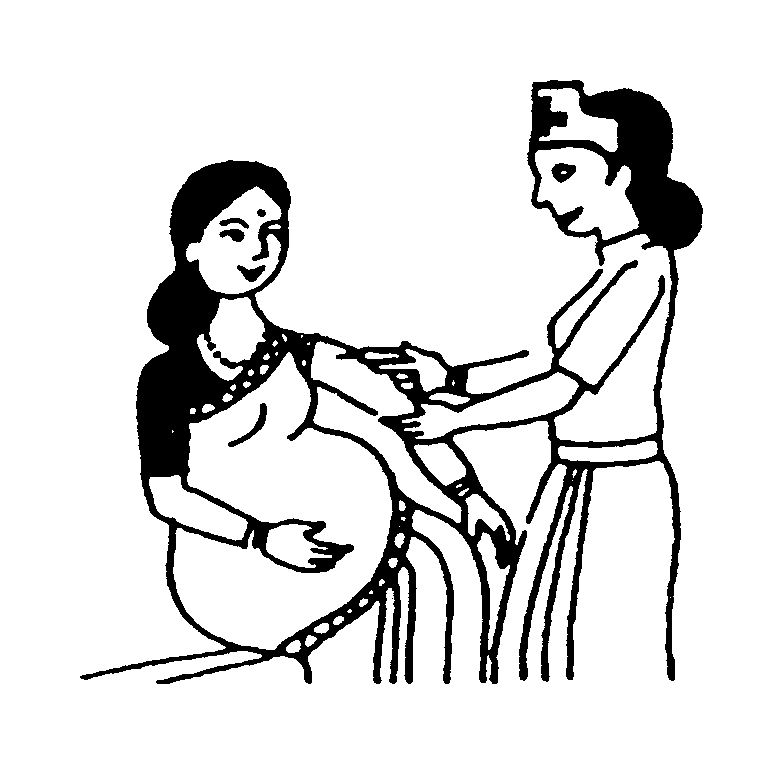
| ||
a. Practice the conversations above as given.
b. Drill the new vocabulary on professions by asking each other about the pictures
on the facing pages, e.g.,
c. Ask each other what you do, giving a variety of answers.
d. Draw an identity card and repeat exercise c, answering according to the data on your card.
e. Bring photographs or draw sketches of the members of your own family, and tell what each does.
f. Answer the following questions.
VOCABULARY
Nouns
vidyarthini f. student
pradhyapək m., f. professor
2. member of a caste cluster whose traditional occupation is tailoring.
Verbs
Adjectives and adverbs
Names
WORD STUDY
1. The word
2. Since traditionally each caste had a particular occupation, many caste names
are also names of professions. One such example is
3. In some modern areas of activity, such as higher education, English words are used in informal speech, and their Marathi equivalents in more formal contexts. Here are some examples.
| Informal | Formal | ||
| profesər | pradhyapək | ||
| kemisṭri | rəsayənšastrə | ||
| hisṭəri | itihas | ||
4. Traditionally feminine forms were used for a number of occupations, e.g.,
22. What Are You Doing Here?
A Maharashtrian asks an American student how long s / he has been in India.
| M : | tumhala ithe yeun kiti divəs jhale? | How long have you been here? ['Since you came here how many days have passed?'] | |
| A : | ek məhina jhala ahe. | It's been one month. ['One month has passed.'] | |
| M : | kiti divəs rahṇar? | How long are you going to stay? | |
| A : | səha məhine. | Six months. |
Variation
| M : | bharətat yeun tumhala kiti divəs jhale? | How long have you been in India? | |
| A : | tin məhine jhale. | It's been three months. | |
| M : | aṇkhi kiti divəs rahṇar? | How much longer are you going to stay? | |
| A : | tin məhine. | Three months. |
Practice the conversation above, along with the variation.
The Maharashtrian asks the American the purpose of his / her coming.
| M : | tunhi ithe ekṭe / ekṭya alat ka? | Did you come here alone? | |
| A : | nahi, amca vis jəṇanca grup ahe. | No, we're a group of twenty. | |
| M : | tumhi kay šikta'e? | What are you studying? | |
| A : | məraṭhi lokanca itihas aṇi sə̃skṛti hyabəddəl šikto'e. | We are studying about the history and culture of the Marathi people. |
Variation
| M : | tumhi ithe ekṭec / ekṭyac alat ka? | Did you come here all by yourself? | |
| A : | nahi, amca pəndhra jəṇanca grup ahe. | No, we're a group of fifteen. | |
| M : | kəšasaṭhi ala'et? | What have you come for? | |
| A : | bharətiyə ǰivənači pəhaṇi kərayla alo'e. | We've come to observe Indian life. | |
| M : | tumhi ithe kɔleǰmədhe šikta'e ka? | Are you studying in a college here? | |
| A : | ho, amhi ṭiək məharašṭrə vidyapiṭhamədhe šikto'e. tyašivay prətyekaca vəiyəktik proǰekṭ ahe. | Yes, we are studying at the Tilak Maharashtra Vidyapeeth. Besides each one has an individual project. |
A. Practice the conversation above, along with the variation.
B. Imagining you have been in Pune for a month, answer the following questions.
| tumhala ithe yeun kiti divəs jhale? | |
| aṇkhi kiti divəs rahṇar? | |
| tumhi məraṭhi kuṭhe šiklat? | |
| məraṭhi šivay tumhala koṇtya bharətiyə bhaša yetat? | |
| tumhi kəšasaṭhi ala'et? | |
| tumhi puṇyat kuṭhe rahta? | |
| tumhi puṇyat kuṭhe šikta'e? |
VOCABULARY
Nouns
Adjectives and Adverbs
Postpositions
Miscellany
Phrases
ṭiək məharašṭrə vidyapiṭhamədhe in Tilak Maharashtra Vidyapith
GRAMMAR NOTES
1. We have encountered several examples so far of the Perfect, a verbal construction that indicates completion of an action and that corresponds more or less to the English past tense.
| tumhi məraṭhi kuṭhe šiklat? | |
| tumhala səməjlə: ka? | |
| mi čəha gheun alo / ale ahe. | |
| kiti pəise jhale? | |
| braun breḍ səmpla ahe. |
This chapter also contains the perfect forms of
| tumhala ithe yeun kiti divəs jhale? | |
| ek məhina jhala ahe. | |
| tumhi ithe ekṭe / ekṭya alat ka? | |
| (tumhi) kəšasaṭhi ala'et? | |
| bharətiy ǰivənači pəhaṇi kərayla alo'e. |
The forms
2. The verb form
3. This chapter also contains four more examples of the Imperfect B, i.e., the
Imperfect used with the present auxiliary in the form of a contraction
indicated by -
| tumhi kay šikta'e? | |
| (amhi) məraṭhi lokanca itihas aṇi sə̃skṛti hyabəddəl šikto'e. | |
| tumhi ithe kɔleǰmədhe šikta'e ka? | |
| amhi ṭiak məharašṭrə vidyapiṭhamədhe šikto'e. |
The Imperfect B aspect is used to indicate action viewed as in progress. Used with the present auxiliary, it is equivalent to what in English is called the 'present progressive' or 'present continuous.'
The Imperfect B has two forms - a formal, written form and the informal
spoken form used here. The informal form is quite irregular, as you may
have noticed:
4. There is also one more example of the Prospective, which is used to express the subject's intention to do something.
| How long are you going to stay? |
23. Three Profiles
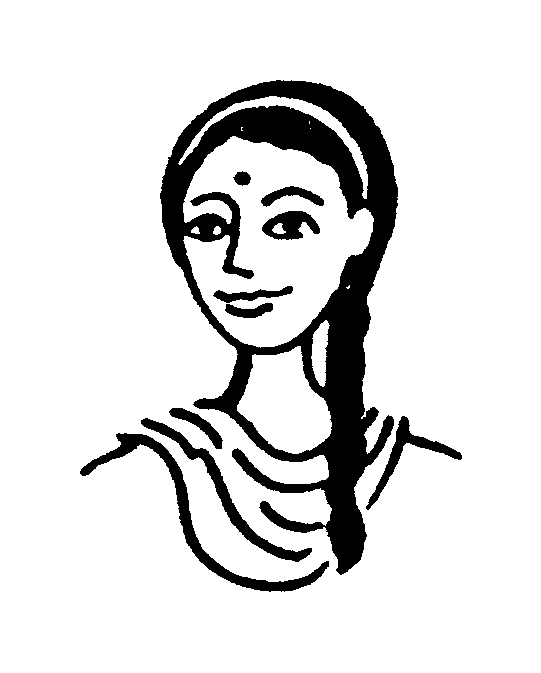
| This is Bharati Kamble. She is eighteen years old. She comes from Ahmednagar. | |
| She is a student. | |
| She studies in Pune - in Fergusson College. At present she is in T.Y.B.A. [third year of B.A. course]. Her major subject is sociology. | |
| Bharati lives in the college hostel and eats in the college cafeteria. | |
| She wears a salwar-kameej every day. Once in a while she wears a sari. | |
| Bharati likes to see plays and to read ['to do reading']. |
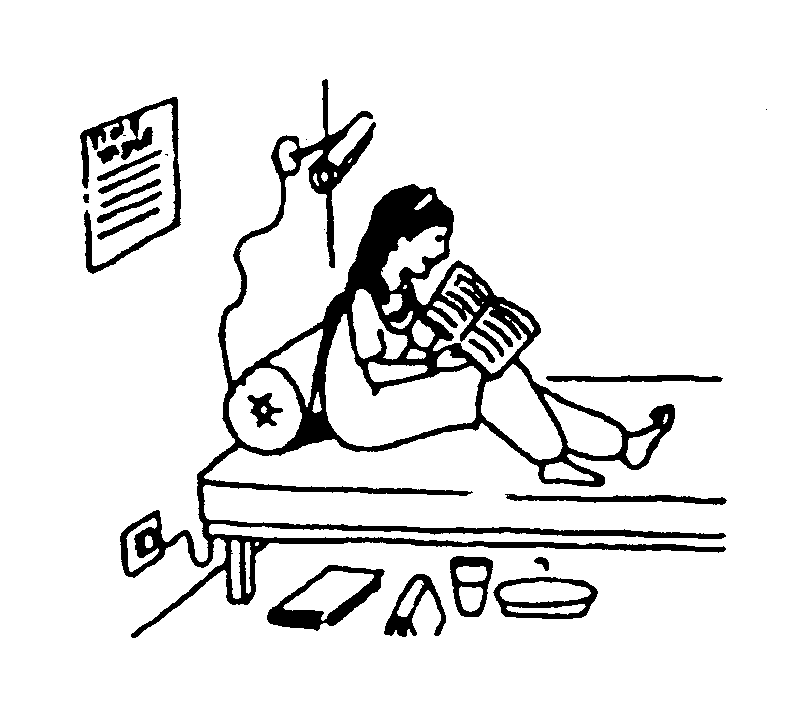
 | Now and then she gets out and about town ['goes to get around town'] on a bicycle. |
| Bharati is not married. ['Bharati's marriage hasn't happened.'] She does not want to marry without finishing her M.A. But her parents say that she should get married after finishing her B.A. ['But her parents say, After finishing your B.A. get married.'] |
Answer the following questions.
| bharəti kiti vəršanči ahe? | |
| ticə: gav koṇtə:? | |
| ti koṇtya kɔleǰmədhe šikte? | |
| tica mukhyə višəy kay ahe? | |
| ti roj saḍi neste ka? | |
| tila kay kərayla avəḍtə:? | |
| ti skuṭərvər gavat phirayla jate ka? | |
| bharəticə: ləgnə jhalə: ahe ka? |
 | ||
| Sadanand is thirty-two years of age. He had all his education right in Pune. | ||
| He is married. His wife Aarati is from Nagpur. They have one daughter. | 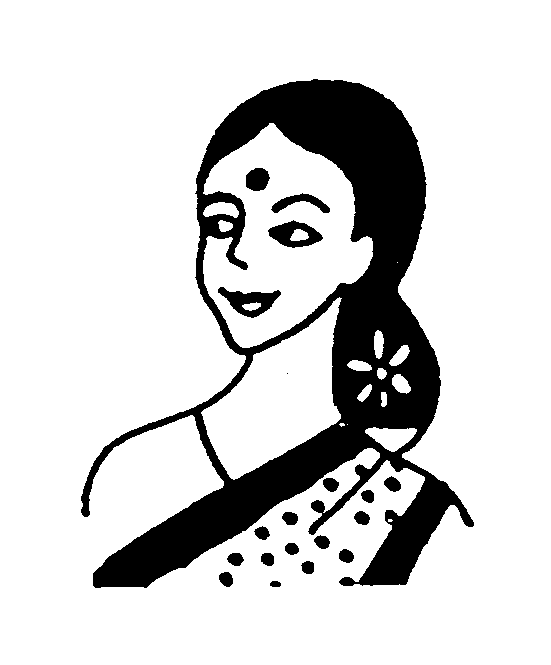 | |
| Aarati is also a bio-chemist, and she works in the same institute. Every morning she does cooking. At ten-thirty they both go to work on their scooter. | 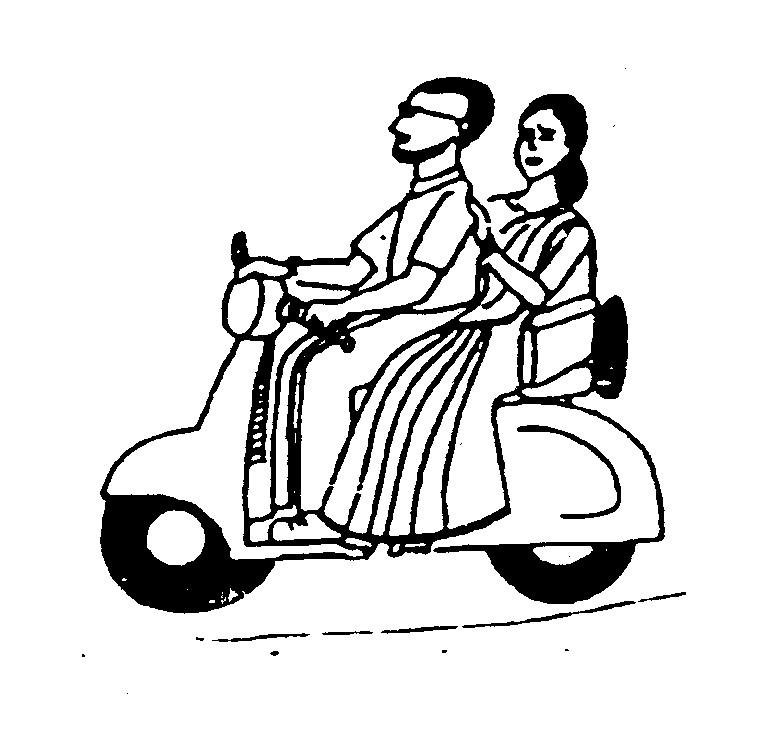 | |
| At home a woman takes care of their daughter. In the evening after coming home Aarati again does the cooking. Sometimes Sadanand helps her. | 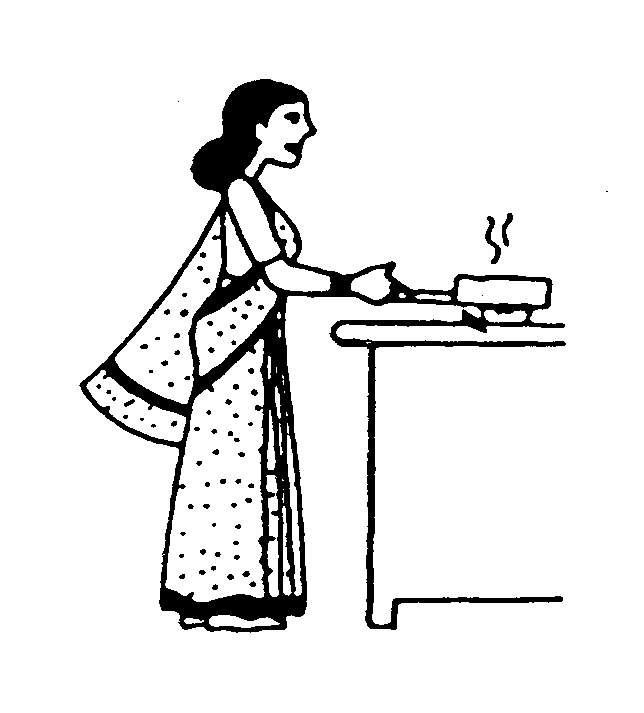 |
| Sadanand and Aarati like to do trekking. Last year they went to Sikkim to do trekking. At home they like to read and to listen to classical music. |
A. Answer the following questions.
B. Ask each other your own questions about Sadanand and Aarati.
| This is Alka Mane. Alka works as a maid. She works in two or three houses. She does the cleaning, washes clothes, makes chapatis and does the dishes. | 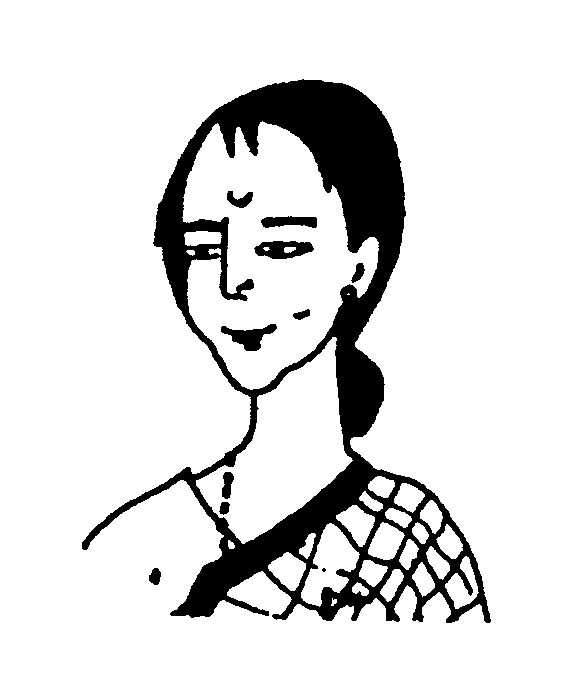 | |
| Alka is thirty years old. She is married and has two children. Her husband works as a mason. | 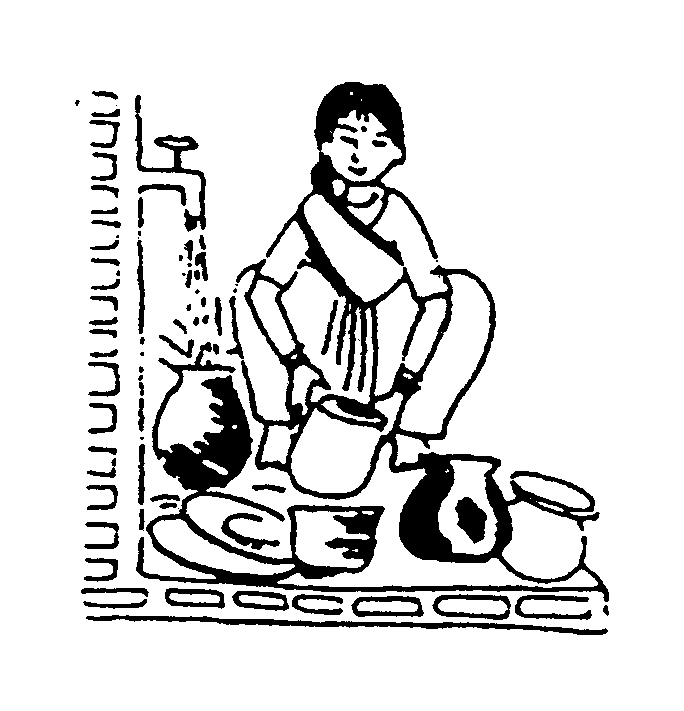 | |
| Alka has studied only up to the fifth grade. ['Alka's education has happened only up to the fifth grade'] but she is very bright. She reads the paper every day and listens to the radio. Every evening she helps the children with their studies ['She takes the children's studies']. | 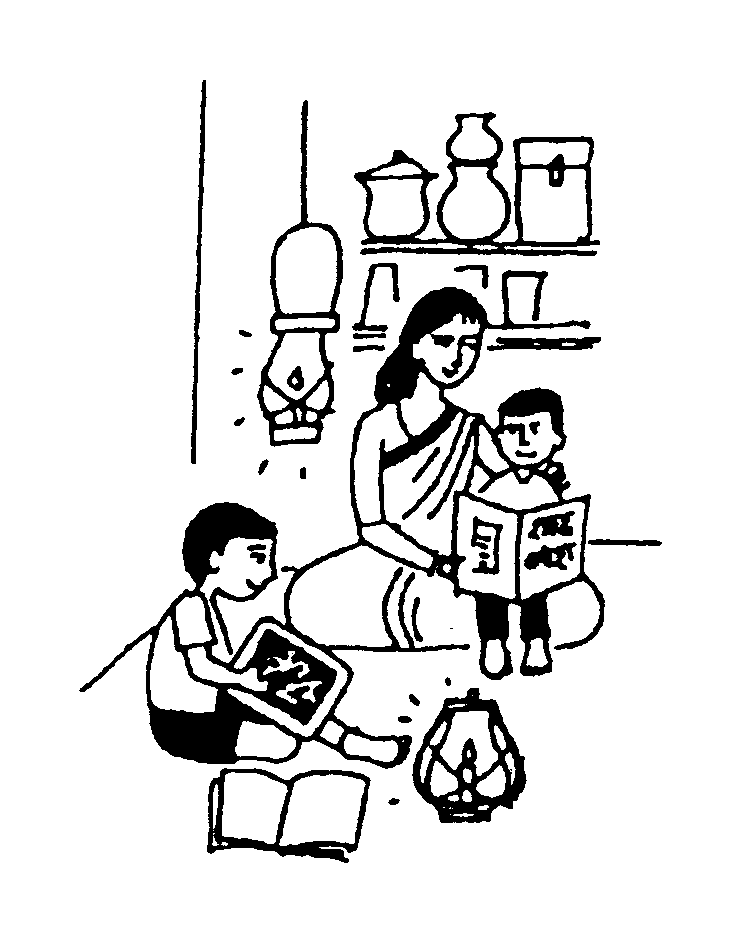 | |
| Alka, her husband and children live in a hut in Mangalwar Peth. She goes to see her mother every day. She always walks to work. Her husband, though, uses a bicycle. |
A. Answer the following questions.
B. Ask each other your own questions about Alka.
C. Ask about each other's bio-data, interests, etc.
D. If possible, procure photographs and information about individuals in India and talk about them.
E. Give a detailed description of some member of your family or a friend.
VOCABULARY
Nouns and pronouns
Adjectives
Adverbs and postpositions
-
-
-
Verbs
Proper names
Place names
GRAMMER NOTES
| 1. | She does not want to marry without finishing her M.A. but her parents say after finishing your B.A. get married. |
The forms
| In the evening after coming home Aarti again does the cooking. |
2. Note that for reported speech Marathi, unlike English, does not require any changes in the structure of the original statement.
| Her parents say that she should get married after finishing her B.A. |
3. Note that in talking about relations (children, siblings, etc.) 'to have' is expressed
by N-
| They have one daughter. ['To them one daughter is.'] | |
| She has two children. |
4. When a personal noun or pronoun (i.e. a human being) is the direct object of a
verb it is made indirect by the addition of
| In the house a woman takes care of their daughter. | |
| Sadanand sometimes helps her. | |
| She goes to see her mother every day. |
5. The form
| Now and then she goes on a bicycle to get around town. | |
| Last year they went to Sikkim to do trekking. |
In other cases V-
| We are learning to speak Marathi. |
The examples of this from the text all involve
| Bharati likes to see plays and to read. | |
| Sadanand and Aarati like to do trekking. | |
| At home they like to read and to listen to classical music. |
6. Note that the verb
| .... | .... | ..... |
7. Another important N-la Impersonal construction is found in the sentence.
| She does not want to get married without finishing her M.A. |
The N-la V-
24. Grammar
A) EXPRESSION OF HABITUAL ACTION WITH THE IMPERFECT A
You are already familiar with the Imperfect A. In Unit Four we used it to make polite requests, and earlier, in Unit Two, to express habitual action with a couple of verbs. In this unit, however, we have concentrated on the use of the Imperfect A for habitual action.
Formation of the Imperfect A. If you need to refresh your memory about the
formation of the Imperfect A, you can refer to Ch. 10 where the complete paradigm of
the verb
Sentences with intransitive verbs. This unit contains many sentences like the following.
These are personal constructions, having the form N Adv. V. The verb is
intransitive, and is preceded by an adverb or adverbial phrase of place or time.
(The word
Note that as we would expect, the question-word question is formed simple by inserting the question word in the position of the adverb.
As always, the yes-no question is formed by adding
Sentences with transitive verbs. Here are some examples of sentences from this unit containing transitive verbs in the Imperfect A.
These sentences have the form N N V, where the verb is transitive, and the first
noun is the subject and the second the object - direct or indirect. Keep in mind
that generally a personal noun or pronoun (i.e., a human being) is not treated as a
direct object, but is made indirect by the addition of the postposition-
Adverbs of place and / or time may also be inserted in the N N V construction. Normally these adverbs will precede the second noun, though sometimes they come at the beginning of the sentence. (Note that in English also there is considerable freedom in the placement of the adverb.)
B) ADVERBS OF FREQUENCY
There are a number of adverbs of frequency used with the Imperfect A. Here are the ones used in this unit. You will encounter others later.
| every day | |
| every morning | |
| every evening |
| always | |
| sometimes, once in a while | |
| once in a while, now and then | |
| at present |
PATTERN PRACTICE
A. Conjugate the following verb phrases in the Imperfect A.
B. Repeat exercise B in the negative Imperfect, e.g.,
C. Answer the question as suggested.
D. Translate the following sentences into Marathi.
1. I live on Tilak Road.
2. I stay at Dr. Pradip Bhosle's.
3. Does Dr. Bhosle teach history?
4. No, he teaches sociology.
5. Does Mrs. Bhosle have a job [do service]?
6. Do they have any children?
7. Yes, they have two.
8. He sometimes helps his wife do the cooking.
9. Do you wear a salwar-kameez every day?
10. Sometimes I wear a sari.
11. Are you learning to read Marathi?
12. No, we're learning to speak it.
13. We have come to observe Maharashtrian life.
14. We go to the university every day.
15. Each one has an individual project.
E. March the words with the pictures.
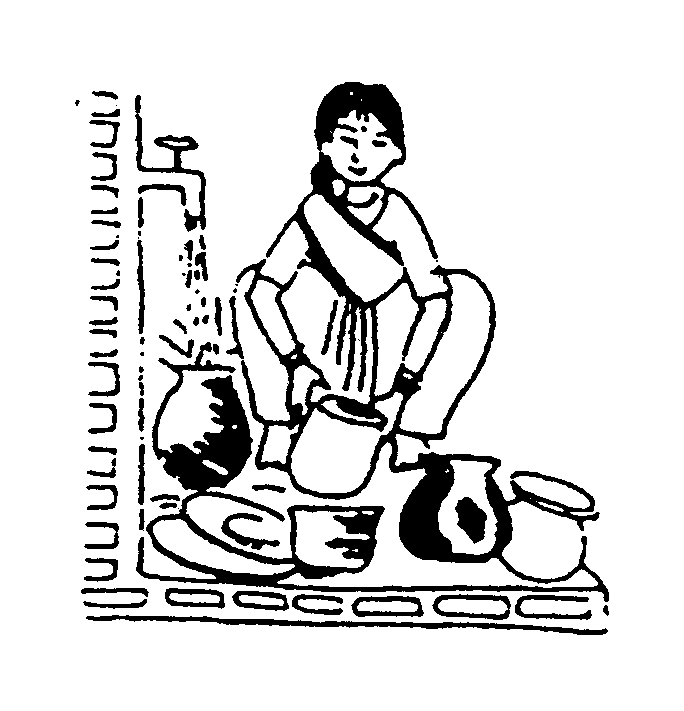
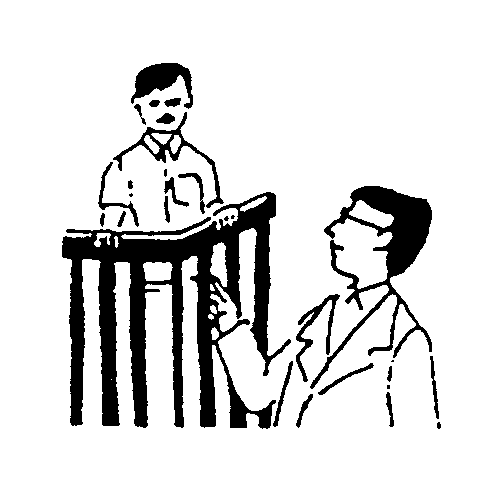
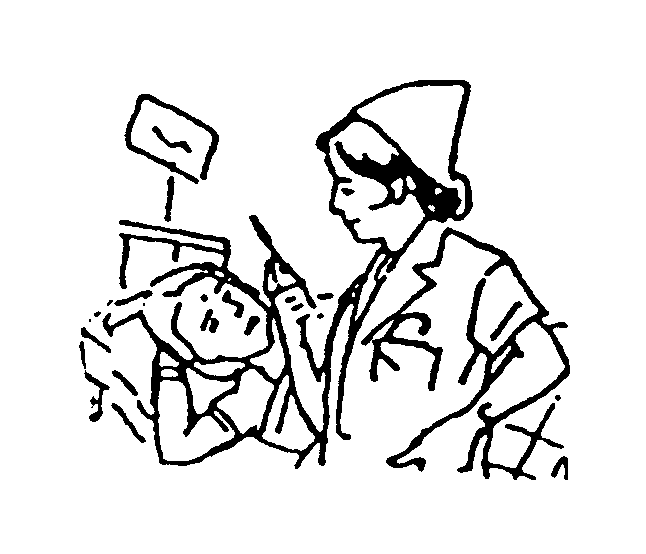

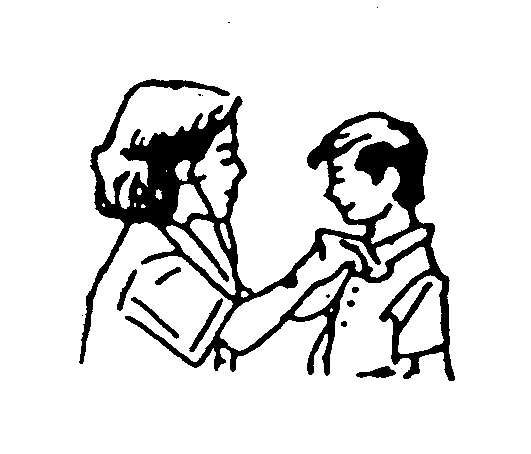
F. Expressing a liking for something. (Complete the sentences on the pattern of the examples.)
Unit Six
Calendar, Time,
Invitations
25. What Day Is It Today?
Tom is trying to plan his week. He asks his friend Sanjay what day it is, much to Sanjay's amusement.
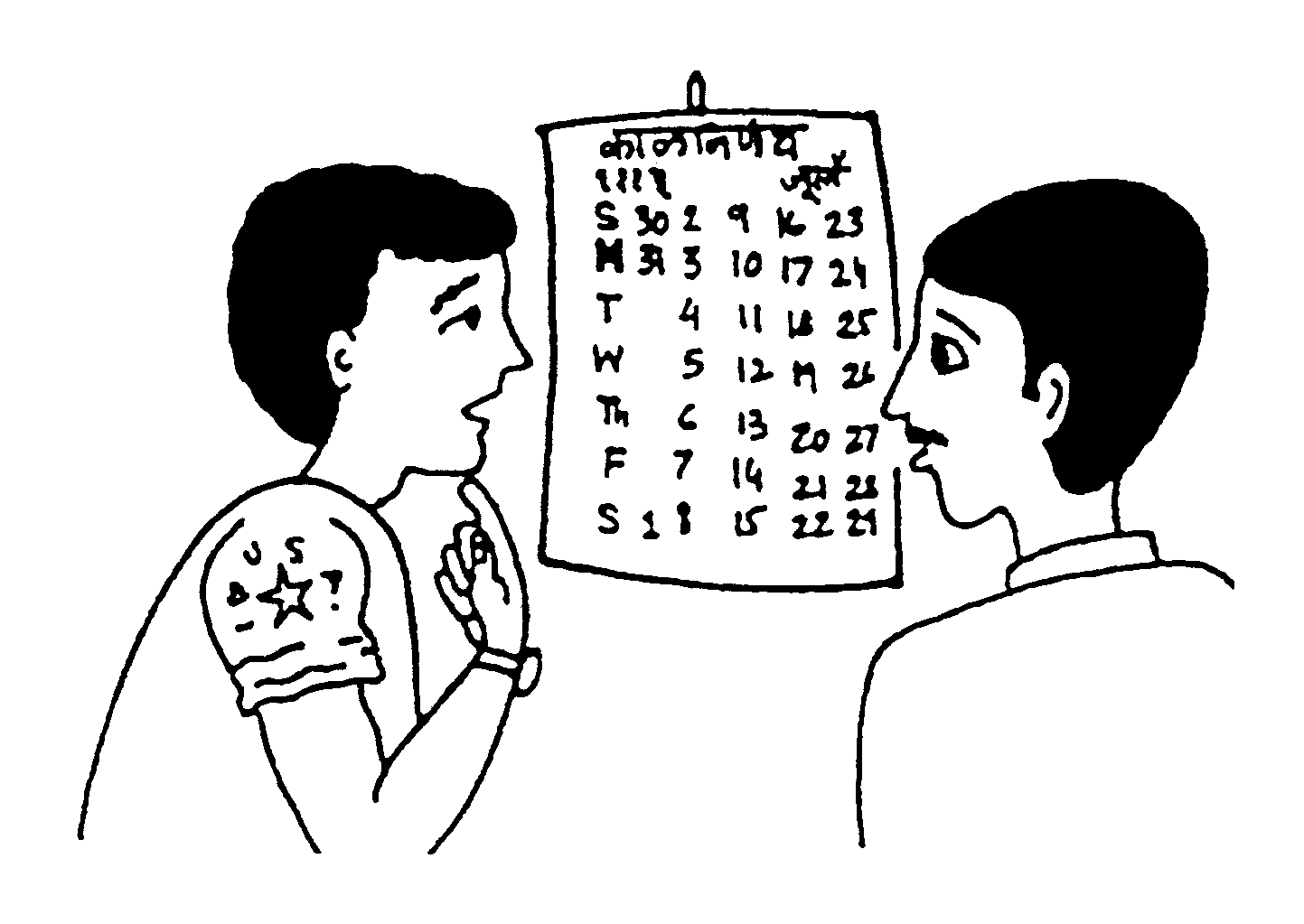
| Monday | |
| Tuesday | |
| Wednesday | |
| Thursday | |
| Friday | |
| Saturday | |
| Sunday |
Tom might just as well have asked any of the following questions.
| What day is it today? | |
| What day is it tomorrow? | |
| What day is it the day after tomorrow? | |
| What day was it yesterday? | |
| What day was it the day before yesterday? |
A. Practice asking the question
B. Ask and answer questions with
Tom asks Sanjay the date.
| T: | What is the date today? | |
| S: | Today is the fifteenth. |
Tom might also have asked any of the following questions.
| T: | What is the date today? | |
| S: | It's the fifteenth of May. | |
| T: | What date was yesterday? | |
| S: | Yesterday was the fourteenth. | |
| T: | What date was it the day before yesterday? | |
| S: | The day before yesterday was the thirteenth. |
| T: | What date is it tomorrow? | |
| S: | It's the sixteenth. | |
| T: | What date is it the day after tomorrow? | |
| S: | It's the seventeenth. | |
| T: | What day is it on the twentieth? | |
| S: | It's Saturday. | |
| T: | What day is it on the seventh? | |
| S: | It's Sunday. | |
| T: | Where were you on the seventh? | |
| S: | I was at Mumbai. | |
| T: | When did you come back to Pune? | |
| S: | I came on the eighth. |
Months (Roman Calendar)
In Maharashtra (and throughout India) although several calendars are used for religious purposes, the Roman calendar is used for everyday secular transactions.
| January | |
| February | |
| March | |
| April | |
| May | |
| June | |
| July | |
| August | |
| September | |
| October | |
| November | |
| December |
A. Practice the exchanges given above.
B. Using a calendar, repeatedly ask the question '
C. Ask questions of the form
D. Practice reciting the numbers from 1 to 31.
Numbers
20 to 31
| 20 | |
| 21 | |
| 22 | |
| 23 | |
| 24 | |
| 25 | |
| 26 | |
| 27 | |
| 28 | |
| 29 | |
| 30 | |
| 31 |
Some Questions and Answers
| What month is it now? | |
| It's the month of May. | |
| What month was last month? | |
| It was April. | |
| What month is next month? | |
| It's June. | |
| How many months are there in a year? | |
| There are twelve. | |
| How many weeks are there in a month? | |
| There are four weeks. | |
| How many days are there in a month? | |
| Except for February there are thirty or thirty-one days. |
Ask each other the questions given above. Give answers appropriate to the time of year.
Meena asks Helen when her birthday is.
| M: | When is your birthday? | |
| H: | April 27. | |
| M: | Where were you on April 27 this year? | |
| H: | I was at my home in America. |
Ask each other the dates of your birthdays and where you were on that date.
VOCABULARY
Nouns and pronouns
Day of the week
Months (Roman calendar)
VOCABULARY
Numbers
20 to 31
| 20 | |
| 21 | |
| 22 | |
| 23 | |
| 24 | |
| 25 | |
| 26 | |
| 27 | |
| 28 | |
| 29 | |
| 30 | |
| 31 |
Names
Adverbs
Verbs
Miscellany
Phrases
WORD STUDY
1. Note that in Marathi the list of the days of the week starts with Monday rather than Sunday.
The remarkable thing about this list is that in both English and Marathi each day of the week is named after the same heavenly body. This identity is not apparent in the names because the English names of the days are derived from Germanic mythology while the Marathi names are derived from Sanskrit. (The English names of the heavenly bodies are derived from Latin.)
| Monday | Moon | |
| Tuesday | Mars | |
| Wednesday | Mercury | |
| Thursday | Jupiter | |
| Friday | Venus | |
| Saturday | Saturn | |
| Sunday | Sun |
2. Note that
3. Note that
GRAMMAR NOTES
1. The verbs
2. You will have realized that
3. You are by now thoroughly familiar with the present tense of the auxiliary verb
4.
5. The phrase
WORD STUDY
The word
26. Come On Over For Dinner
Sanjay invites Tom over for dinner.
| S : | Come on over for dinner the day after tomorrow. | |
| T : | What day is it the day after tomorrow? | |
| S : | Saturday. | |
| T : | I'm sorry. We're having guests on Saturday evening. | |
| S : | Then come on Sunday. | |
| T : | By all means. |
A. Practice the conversation as given.
B. Repeat the conversation, varying the day of the invitation and the alternative day decided on.
C. Vary the reasons for not being able to come on the day suggested. For example:
| I have work. | |
| I am going out of town. | |
| My parents are coming. | |
| I'm going to go see a Marathi movie. |
Parts of the Day (Locative Forms)
| in the morning | |
| in the afternoon | |
| in the evening | |
| at night |
Reference to a particular day
| this morning | |
| tomorrow afternoon | |
| Sunday evening |
Examples
| Come to my house this morning. | |
| Go to their / his / her place tomorrow afternoon. |
A. Practice making phrases using the matrix below.
B. Invite a friend over, using various phrases from the matrix above in the
pattern . . .
Meena invites Helen over to watch a Marathi movie.
| M: | Would you come over Sunday evening to watch a Marathi movie? | |
| H: | I'm sorry. I'm going to go to Mumbai on Sunday. I'll get back late at night. | |
| M: | Then come on Monday. | |
| H: | By all means. |
Expand the conversation, talking about occasion for the invitation, the time, reasons for not being able to come. Here are some suggestions.
| We're having a party. ['There is a party at our place']. | |
| There's a good movie on T.V. | |
| My brother is coming from America. | |
| My sister is getting married ['my sister's wedding is']. |
VOCABULARY
Nouns and pronouns
Other locative forms
Miscellany
-
Phrases
WORD STUDY
1. The verb
2.
GRAMMAR NOTES
1. A number of words in reference to time employ the old locative case ending
| on Monday | |
| on Tuesday | |
| on Wednesday | |
| on Thursday | |
| on Friday | |
| on Saturday | |
| on Sunday | |
| on the day after tomorrow, etc. | |
| in the evening. |
This is considered a case form rather than a noun with an added postposition
because the noun is not in the oblique form.
2. Note the different constructions used to express 'to have', depending on the context.
| I have work. | |
| We're having a party. |
27. What Time Is It?
Susan has overslept. She asks her Maharashtrian 'sister' Vineeta what time it is.

Telling Time (Complete Hours)
The expression
| What time is it? | |
| It's one o'clock. | |
| It's two o'clock. | |
| It's three o'clock. |
Bob has been visiting his friend Ravi.
| B : | Say, What time is it? | |
| R : | It's one o'clock. | |
| B : | Well then, I'll be going. I have to meet Prof. Joshi at two o'clock. |
A. Practice the conversations given above.
B. Make a clock out of tagboard or paper, and ask each other the time.
C. Repeat the original conversations, varying the time referred to, and the reason for having to hurry. Here some possibilities.
| I have to go to Prof. Joshi's. | |
| I have to meet Sunita. | |
| I have to phone Jim. |
Telling Time (Half Hours)
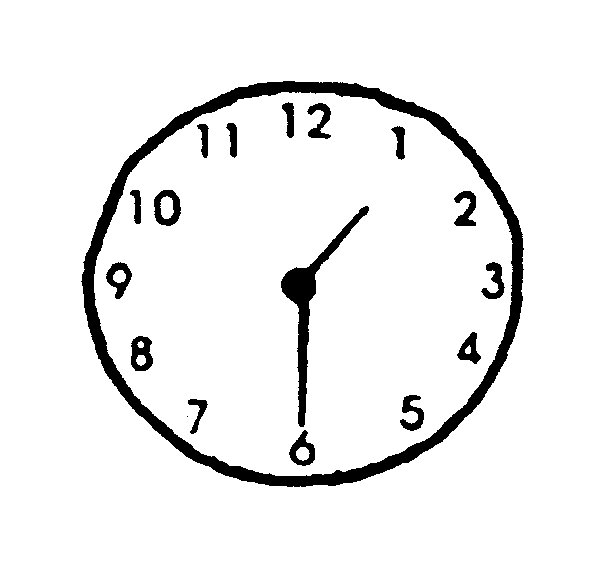
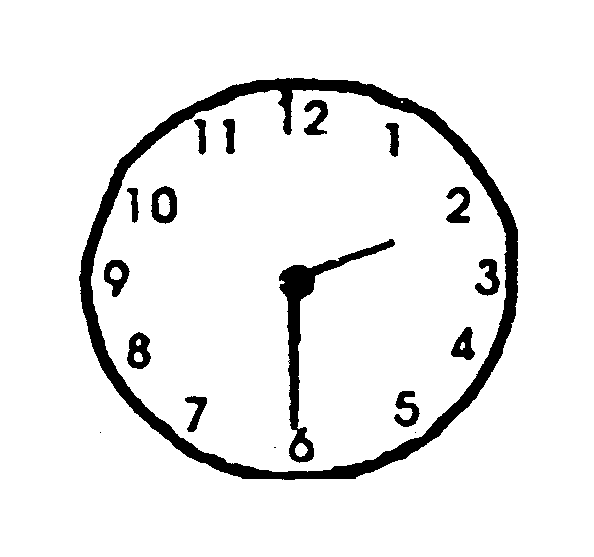

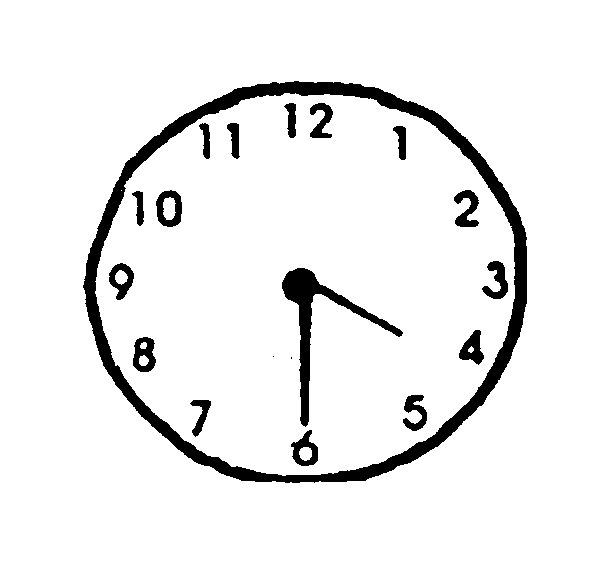
Only the expressions for 1:30 and 2:30 are irregular. From 3:30 on the form is regular.
Telling Time (Quarter Hours)
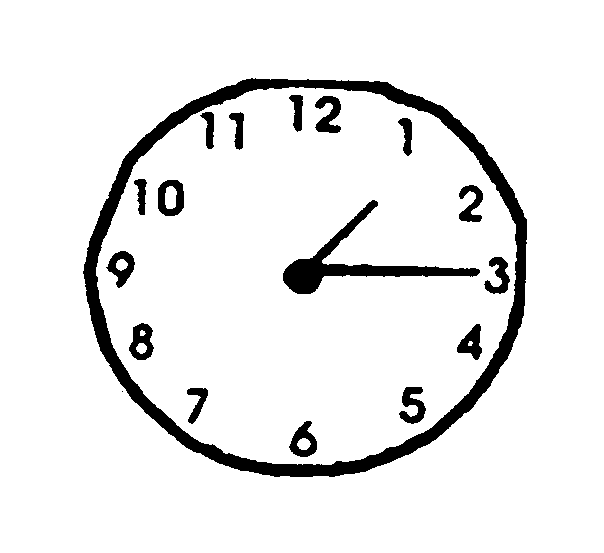

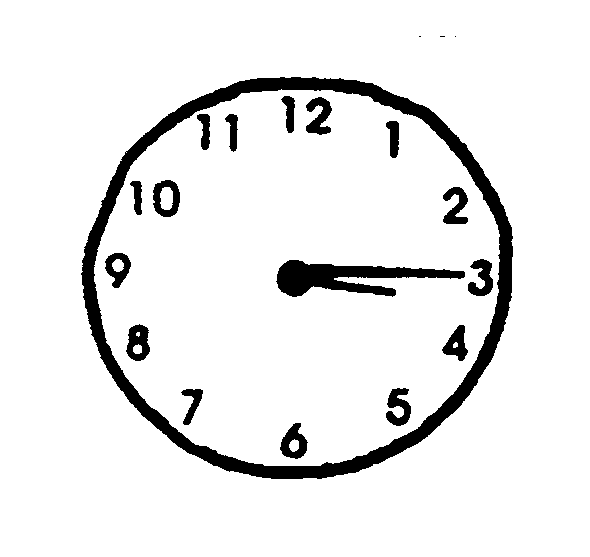
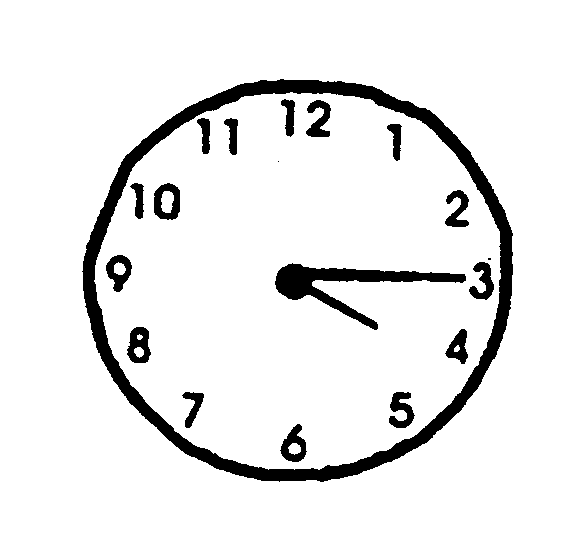

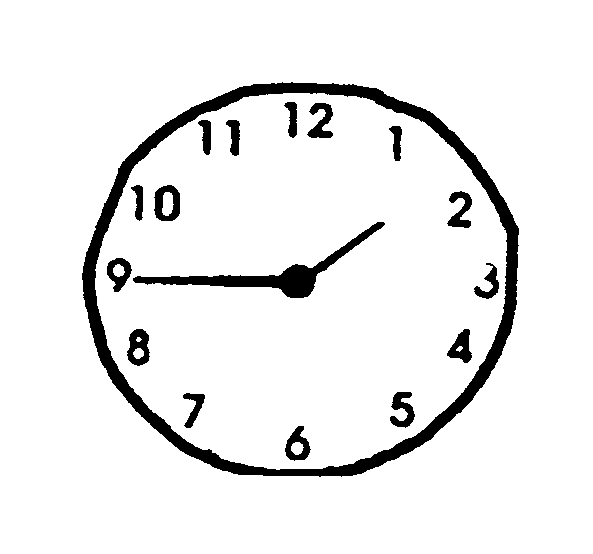
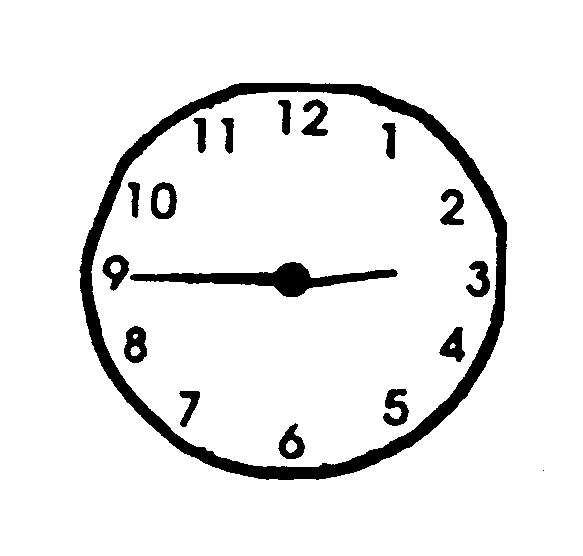
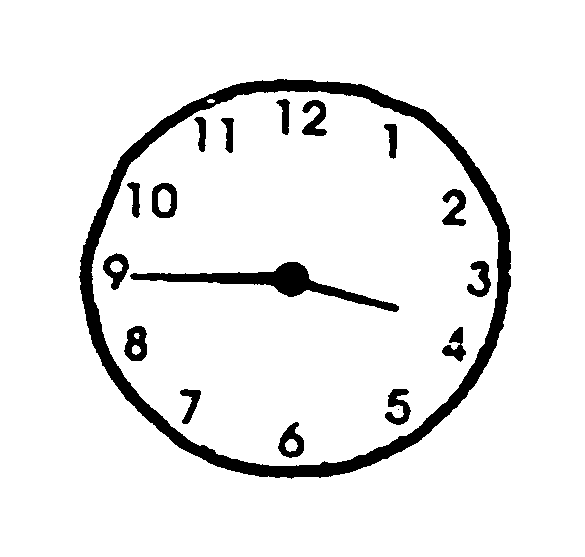
Using the model clock, ask each other times on the quarter hour and the half hour.
Telling Time: Recap
Here are the times by the quarter hour from 12:00 to 4:00
Vineeta wants to make sure Susan isn't late.
| V: | Say, what time do you have to go to the university? | |
| S: | I have to leave at eight o'clock What time is it now? | |
| V: | It's a quarter to eight. |
At X o'clock
The expression
It can be answered by replacing
| I have to leave at eight o'clock. | |
| The train leaves at 4:30. |
The informal way of expressing 'at x o'clock' is by simply adding the postposition
-
| I have a class at eight. | |
| at seven-thirty. | |
| at X o'clock. |
Using the form of the conversation above, substitute various places you have to go and time you have to be there, and then ask what time it is. Here are some possibilities.
| to the college | |
| to the office | |
| to ['my'] Marathi class | |
| out of town | |
| do dine at a friend's house. |
VOCABULARY
Nouns
Names
Number Fractions
2. (in expressions of time) quarter after
one.
2. (in expressions of time) one-thirty
2. (in expressions of time) quarter to
one.
2. (in expressions of time) two-thirty.
Verbs
Postpositions and interjections
-
Phrases
WORD STUDY
1. The addition of
2.
3. Although
GRAMMAR NOTE
28. Let's Go To Sinhgad
A Maharashtrian suggests a trip to Sinhgad to his / her American friend.
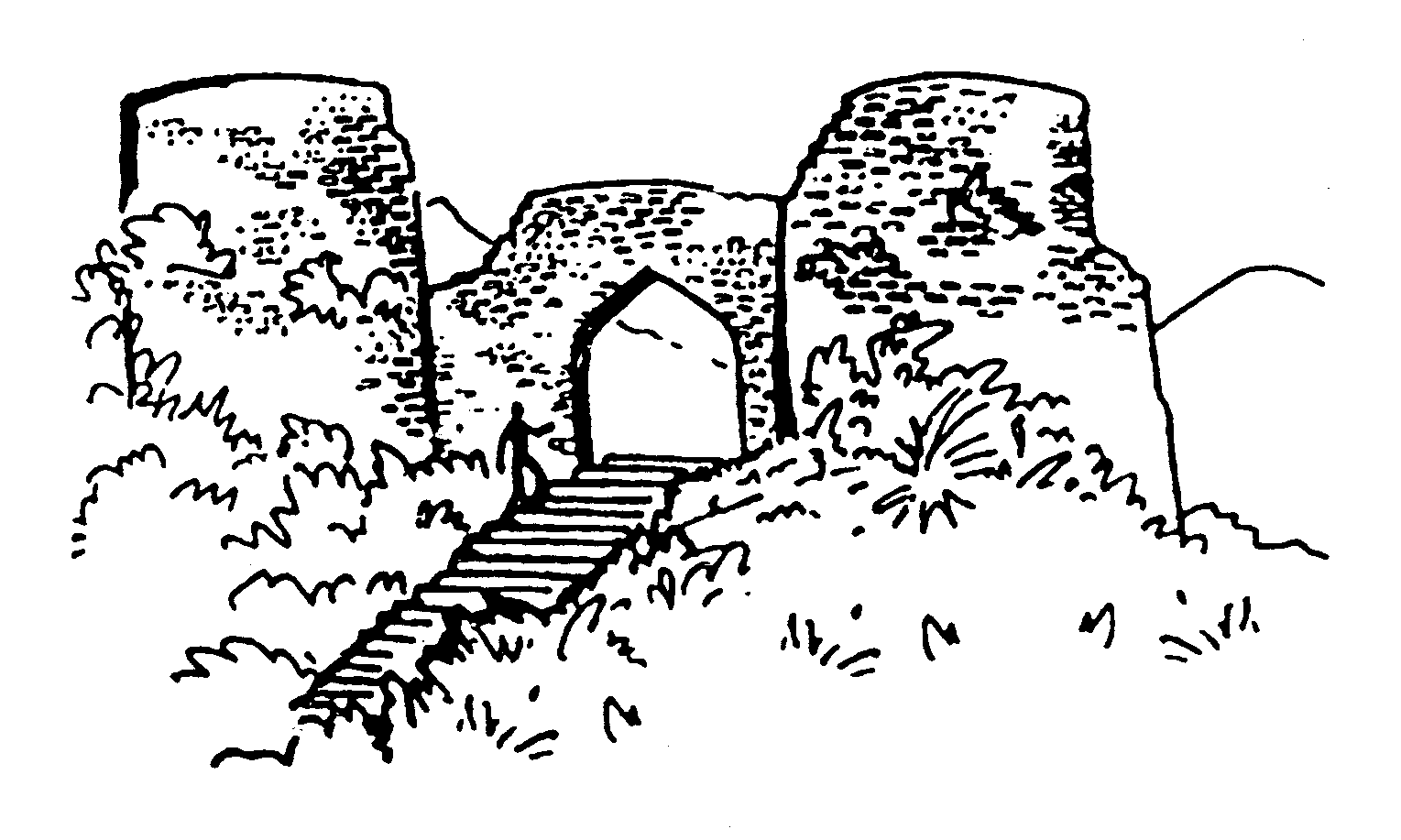
A. Practice the conversation as given above.
B. Repeat the conversation, varying the place to go, the day and time, the mode of transport, etc.
Other Places To Go
| Pandharpur | |
| Karla Caves | |
| Bhaja Caves | |
| Paithan | |
| Ajanta and Ellora | |
| Mahabaleshwar |
Modes of Transport
The instrumental postposition
| by bus | |
| by rickshaw | |
| by car | |
| by rail | |
| by plane |
I many people's speech
A Maharashtrian invites an American student to accompany him / her on a photo-taking expedition to Mahabaleshwar.
| M: | Have you ever gone to Mahabaleshwar? | |
| A: | No, I haven't. | |
| M: | I want to go there on Saturday and take some pictures. Do you want to come along? | |
| A: | Sure, ['Yes, I certainly want to come.'] Shall I invite Jim too? | |
| M: | Certainly. |
A. Ask your partner if s / he has gone to the following places. (Note that places
names are given here with -
B. Assume you have decided to go to Mahabaleshwar. Tell your partner when and why you are going, and ask him or her to come along. Below are some of the things you might want to do there.
| I want to go there and do some bird. watching ['watch birds']. | |
| I want to roam around everywhere. | |
| I want to go horse back riding ['sit on a horse']. | |
| I want to play golf. |
C. Develop the conversation above by accepting the invitation and asking if you can bring a friend.
D. Discuss the time you are going to leave.
E. Decline the invitation. Below are some of the reasons you might give. Add some of your own.
| I have work. | |
| We have guests. | |
| My brother is coming. |
VOCABULARY
Nouns and pronouns
Verbs
Adverbs
Place names
Postpositions
Phrases
GRAMMAR NOTES
1.
2. The form
| I want to go there on Saturday and take some pictures. |
This verbal form serves as a conjunction joining two or more verbs in a series of closely related actions. The aspect or tense is shown only by the last in the series of verbs.
29. Grammar
A) THE PROSPECTIVE
So far you have encountered several sentences of the following from.
| What are you going to have? | |
| How long are you going to stay? | |
| On Saturday evening some guests are coming over to our place. |
These sentences are in what we have termed the prospective aspect. The
formula for the prospective is N V -
| My sister is going to come tomorrow. | |
| My sister will come tomorrow. |
Though the participial form V -
| I'm staying! |
The formation of the prospective is completely regular and without any complications.
The negative of the prospective is formed by using the appropriate form (determined by the subject) of the negative Auxiliary.
| My sister isn't going to come tomorrow. | |
| I'm not going to stay. | |
| Aren't you going to take tea? |
B)
Up until now we have found several sentences having the structure
| Let's give two rupees. | |
| Let's go to Sinhgad. | |
| Let's look at some maps. | |
| Let's begin. |
This construction is restricted to the first person plural inclusive.
C) PAST TENSE OF THE AUXILIARY
The auxiliary, as you know, is an independent verb in its own right, and is also an important element in many verb constructions. Unlike other verbs the auxiliary has a full range of tenses: present, past and future. The examples below illustrate the use of past tense of the auxiliary, both as an independent verb and as an element in a verbal construction
| What day was it yesterday? | |
| What date was it day before yesterday? | |
| Where were you on the seventh? | |
| Were you in the office all day long? | |
| Had you gone out today? |
The stem for the past tense of the auxiliary
Table 10. Past endings of auxiliary
| Person | Singular | Plural | ||||
| M | F | N | ||||
| 1 | - | |||||
| 2 | - | |||||
| 3 | ||||||
| M | F | N | ||||
Note that in the third person the endings are the same as the variable adjective endings.
The full paradigm of the past tense of
| I (m.) was | |
| I (f.) was | |
| you (m.) were | |
| you (f.) were | |
| he, it was | |
| she, it was | |
| it was | |
| we were | |
| you were | |
| they (m.) were | |
| they (f.) were | |
| they (n.) were |
D) N
This unit has contained many sentences having the strcture N-
| I want to go to Mahabaleshwar. | |
| Do you want to come along? | |
| I want to play golf. | |
| I want to meet Suneeta. |
We have translated each sentence with 'want to V', although in some cases (especially the first and last examples) the sense may be 'have to V'.
In these examples we can see that the Marathi sentences are distinctly different
from their English counterparts. In each English sentence a person - or a pronoun
standing for a person - is the agent of the action and the subject of the sentence:
'I want to V', 'Do you want to V?', etc. In the corresponding Marathi sentences the
person is the receiver of the action and is grammatically the indirect object. It is
almost impossible to give a literal translation of these sentences, but an
approximation of the first one would be something like 'To me going to
Mahabaleshwar is wanted.' Like
Formation. V-
The same morphophonemic rules which operate in the formation of the imperative plural also operate here.
1.
2.
3. The combination of
4. In a word of two or more syllables ending in the sequence VwCVwC, if the
second vowel is
As the effect of this rule is not apparent in the Devanagari script we have also shown the pronunciation in Roman script in the examples below.
| ughəḍ | ughdaycə: | ||
| dakhəv | dakhvaycə: |
Agreement. As V-
| I want to have ['take'] coffee. | |
| I want to have ['take'] tea. |
If the verb is intransitive it has no direct object to agree with; therefore the ending is neuter singular by default.
| I want to go to Mahabaleshwar. |
A person cannot normally be treated as a direct object, but must be made indirect.
Therefore in this case too the ending of V-
| I want to meet Suneeta. |
Since the verb in the N-
| I want to have coffee. | |
| Do you want to have coffee? | |
| She wants to have coffee. | |
| They want to have coffee. |
In addition to the ending of V-
| She wants to see the temple. | |
| She wants to see the temples. |
It should be noted that although in all our examples we have written the
auxiliary seperately from v-
The negative of the N-
| She does not want to get married without finishing her M.A. | |
| I don't want to get ['take'] coffee. | |
| I don't want to go to Mahabaleshwar. |
E) THE INSTRUMENTAL POSTPOSITION
In this unit instrumental postposition -
| by bus | |
| by plane |
The same postposition is also used to mean 'by' when speaking of tools, instruments, ways, means or routes (via).
| We eat with our hands ['hand']. | |
| We hear with our ears ['ear']. | |
| The bus goes via Nasik. |
Many speakers use
| Formal | Informal |
Although with a singular noun or pronoun there are these variants of the
instrumental postposition, with a plural the postposition is invariably
| We eat with forks and spoons. |
F) ADVERBIAL EXPRESSIONS OF TIME
Adverbs. There are a number of adverbs of time, many of which have been used in this unit.
| today | |
| tomorrow | |
| yesterday | |
| the day after tomorrow | |
| the day before yesterday | |
| now | |
| later | |
| soon, early, quickly |
The adverbs of frequency introduced in Unit Five may also be considered adverbs of time.
Locative forms. For many words connected with time the old locative ending
| in the morning | |
| in the afternoon | |
| in the evening | |
| at night | |
| on Monday | |
| on Tuesday | |
| on Wednesday | |
| on Thursday | |
| on Friday | |
| on Saturday | |
| on Sunday |
In addition to individual locatives, there are many phrases consisting of an adverb followed by a locative of time. In expressions referring to days of the week both words may be in the locative.
| this morning | |
| this evening | |
| last night | |
| tomorrow afternoon | |
| every morning | |
| Saturday morning |
In some phrases the first word is an adjective or demonstrative pronoun. Note that these must be in the oblique form.
| (on) last Monday | |
| (on) next Saturday | |
| (in) this year |
Other adverbial phrases of time. In addition to the phrases described above, there are many adverbial phrases of time consisting of a noun or a pronoun followed by a postposition. A few examples are given below.
| in this week | |
| during the last month | |
| in the next year | |
| in one day | |
| at eight | |
| on time |
PATTERN PRACTICE
A. Conjugate the following verb phrases in the prospective and negative prospective.
B. Use the following verb phrases in the
C. Add
D. Conjugate the following verb phrases using the N-
E. Repeat exercise D using the negative Auxiliary.
F. Give the past tense of the auxiliary that goes with each noun or pronoun.
G. Translate the following sentences into English.
H. Translate the following sentences into Marathi.
1. My brother is going to come from America next week. Come to meet him on Friday evening.
2. What time shall I come?
3. Come at eight.
4. Let's have some coffee.
5. Let's go to a play.
6. I have to study.
7. What time is it?
8. It's quarter to eight.
9. What's the date today?
10. It's the seventeenth of May.
11. Do you want to take this book?
12. I want to listen to some classical music.
13. What day was it on the twenty-seventh?
14. I was in Kolhapur day before yesterday.
Unit Seven
Asking Your Way Around
30. Where Is The Vegetable Market?
Vegetable Market and Environs


A. Use the pictures in the accompanying 'Small Town Scenes' to study the new vocabulary. Go round your class or group identifying each picture represents.
B. Ask each other the location of the various places on the map with reference to each other, using postpositional phrases as above.
Small Town Scenes
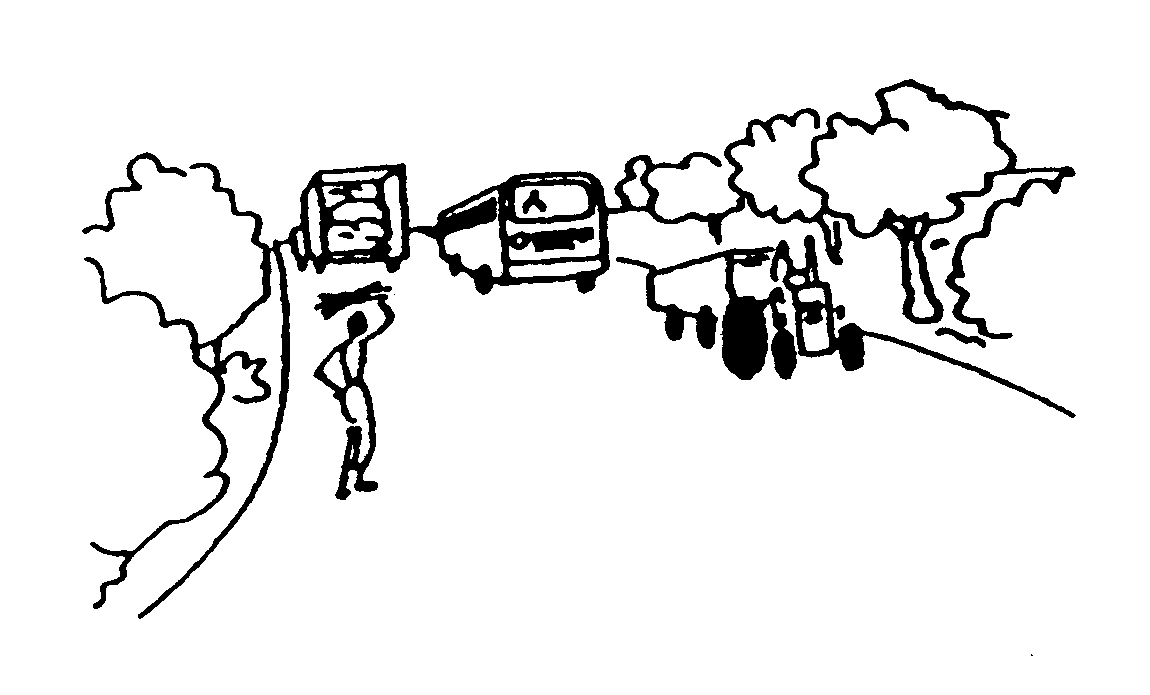
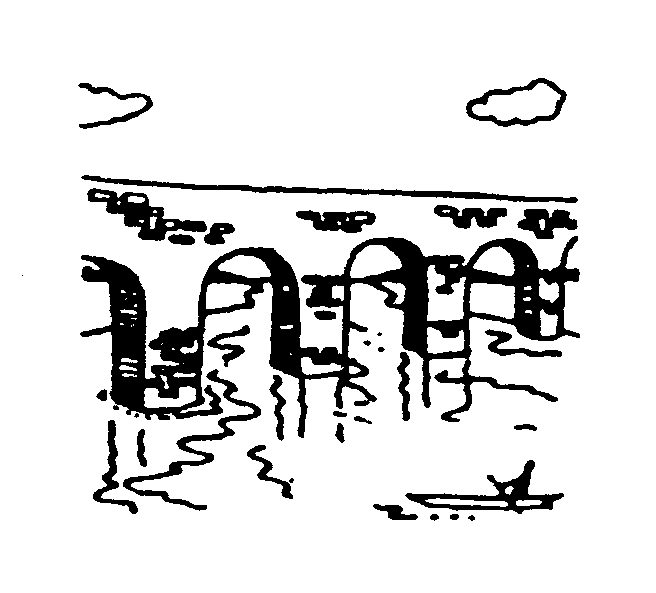
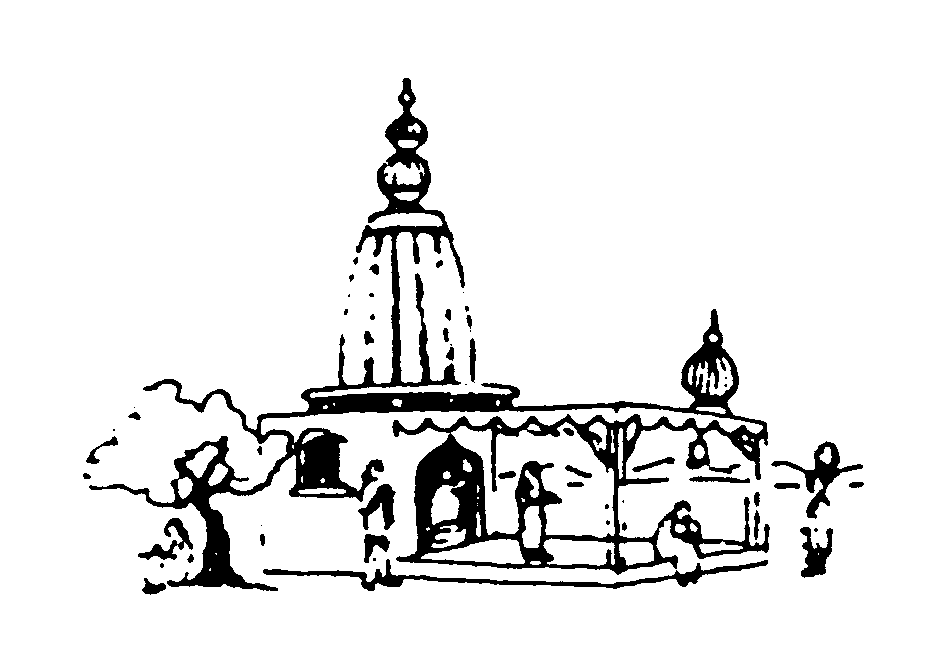
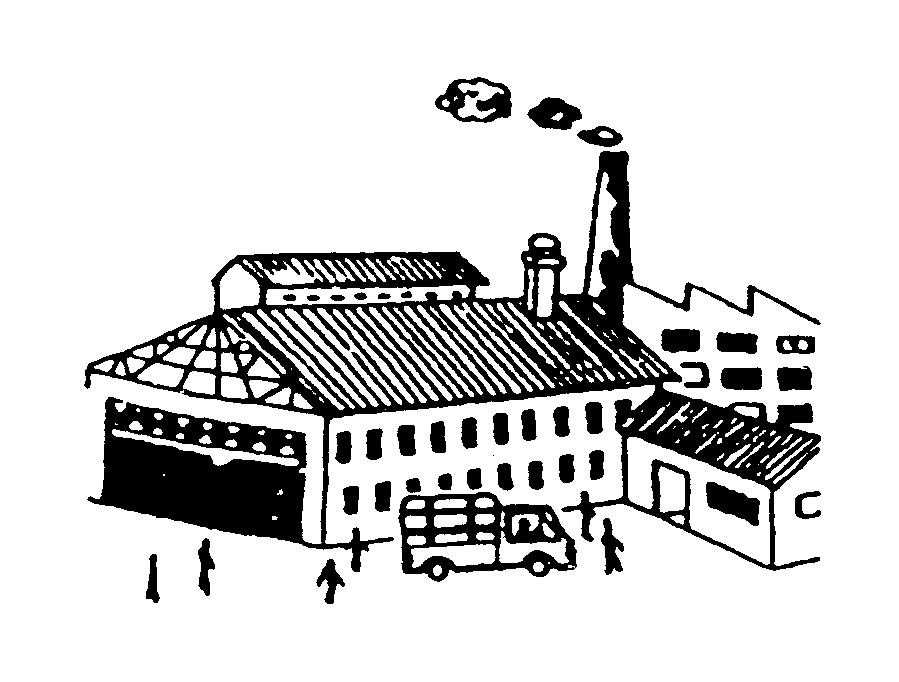
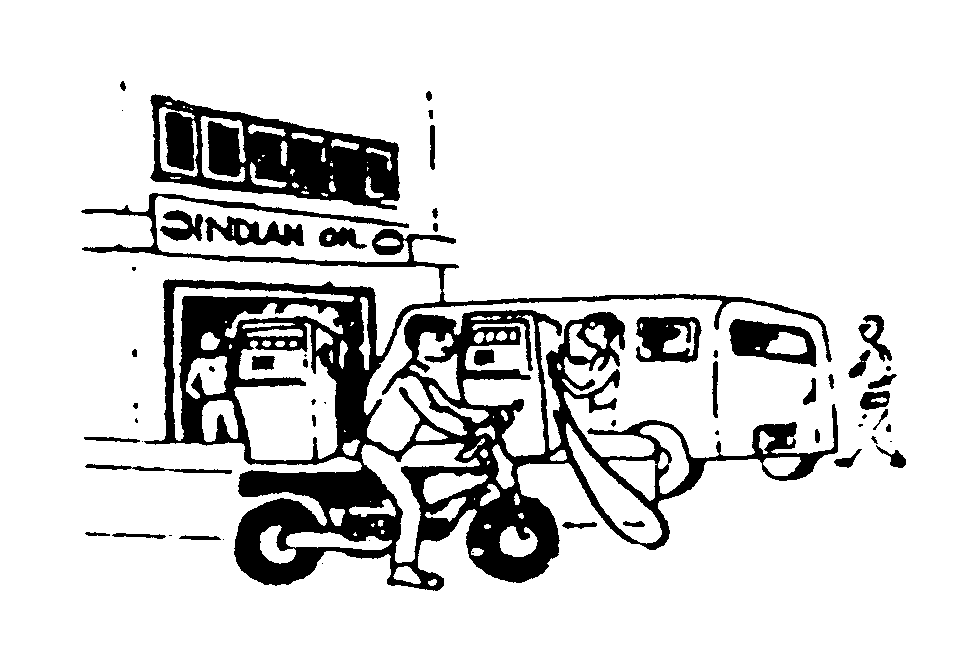
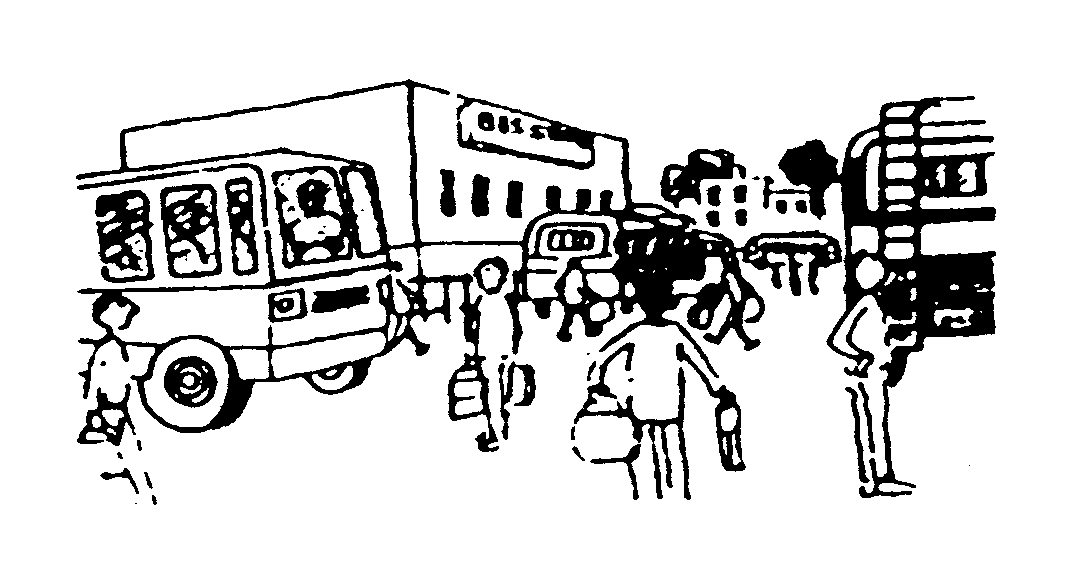
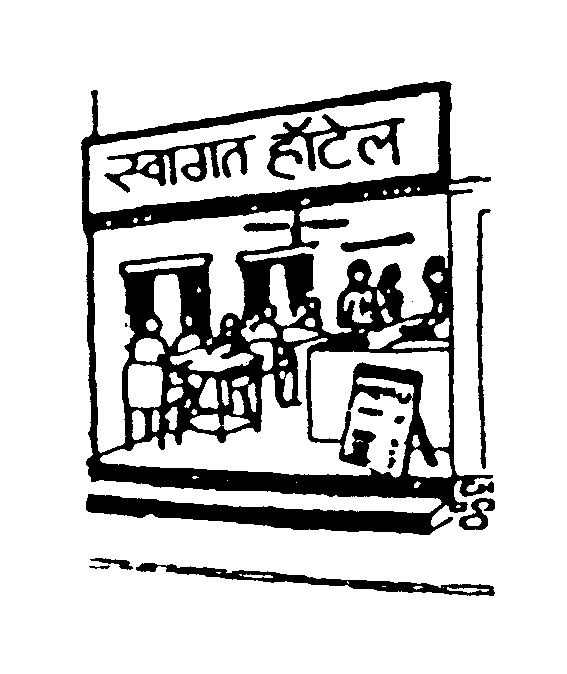

Small Town Scenes
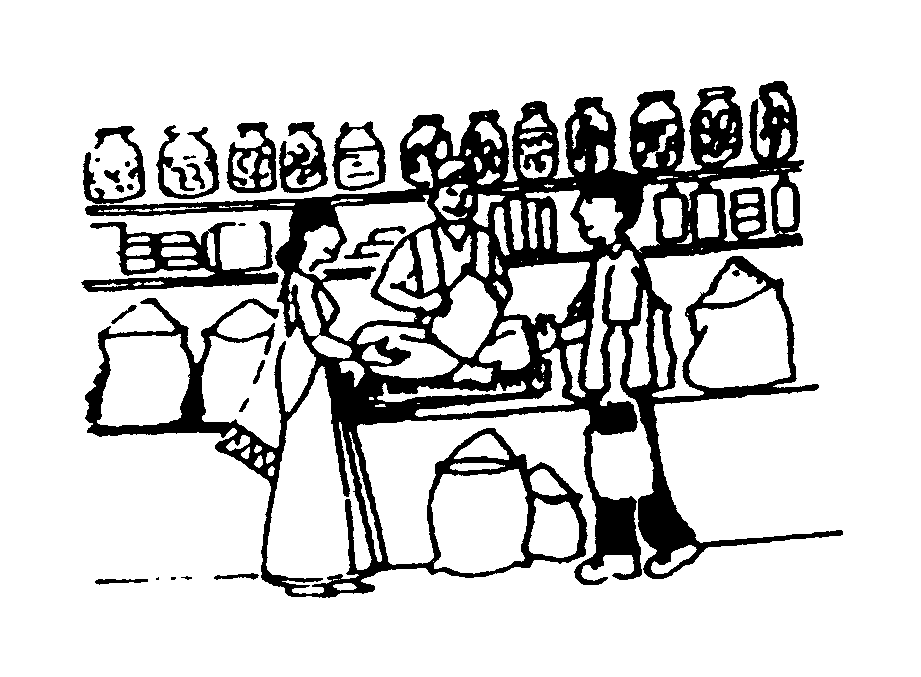
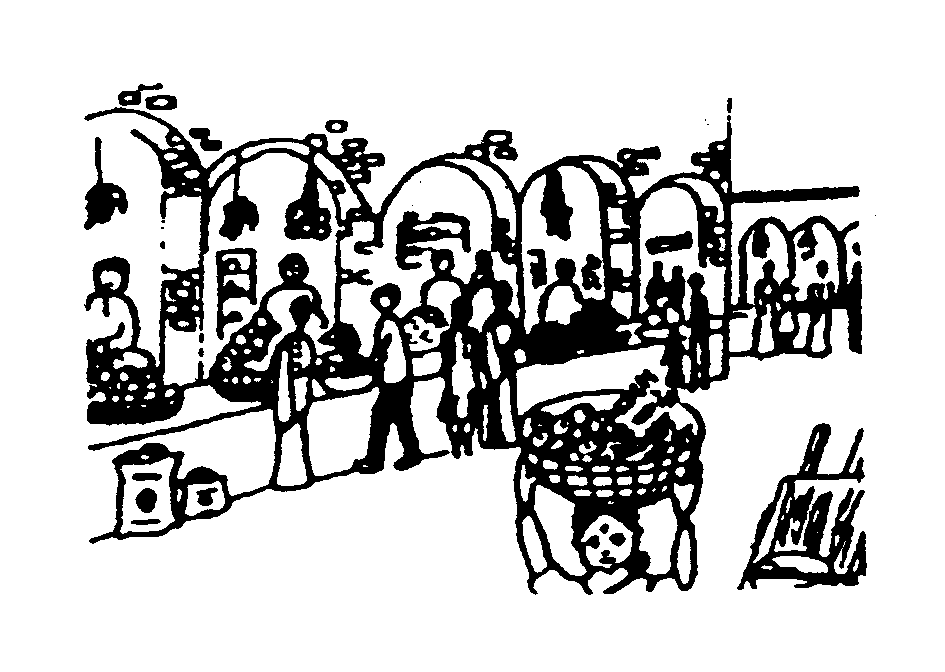

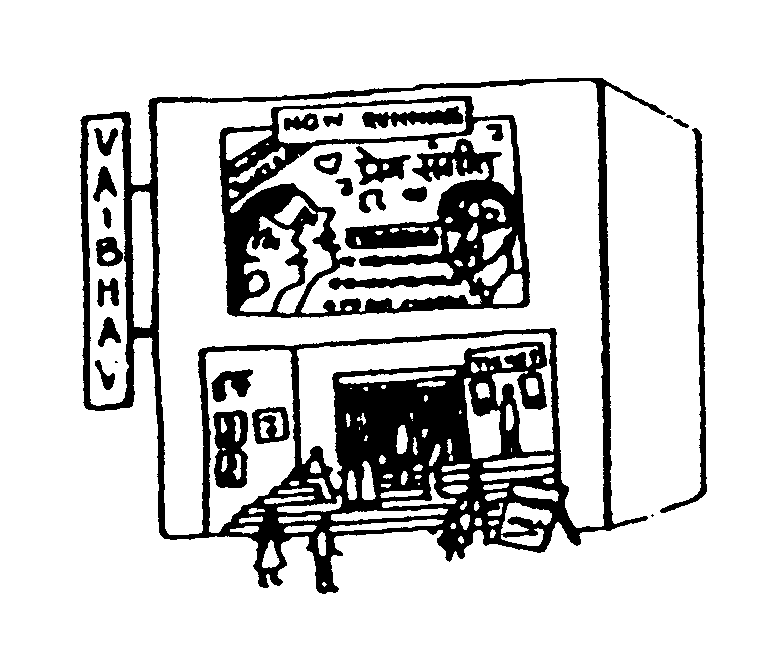
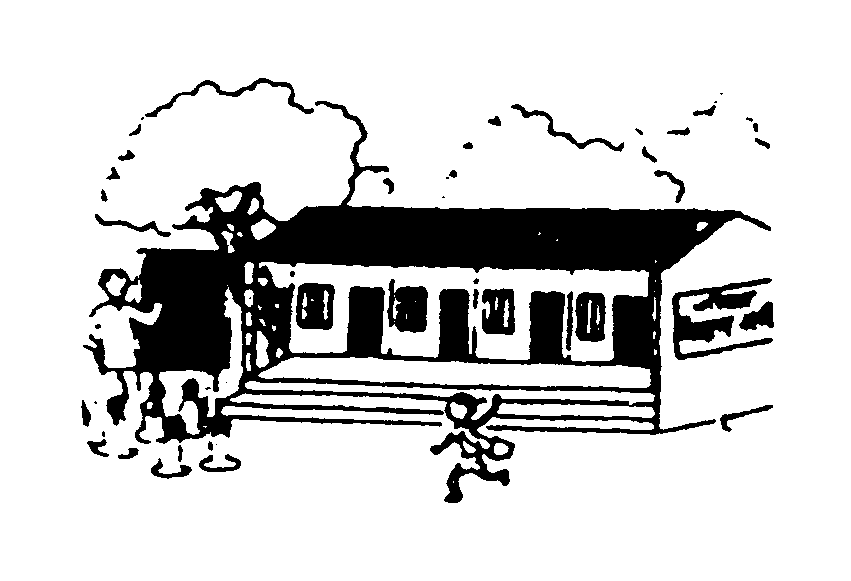
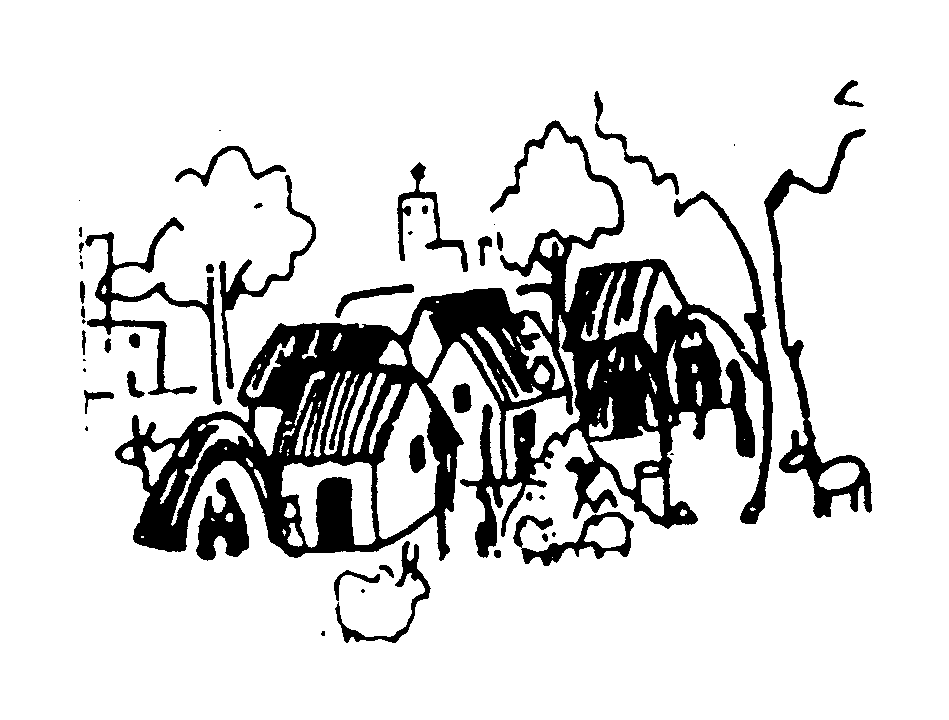
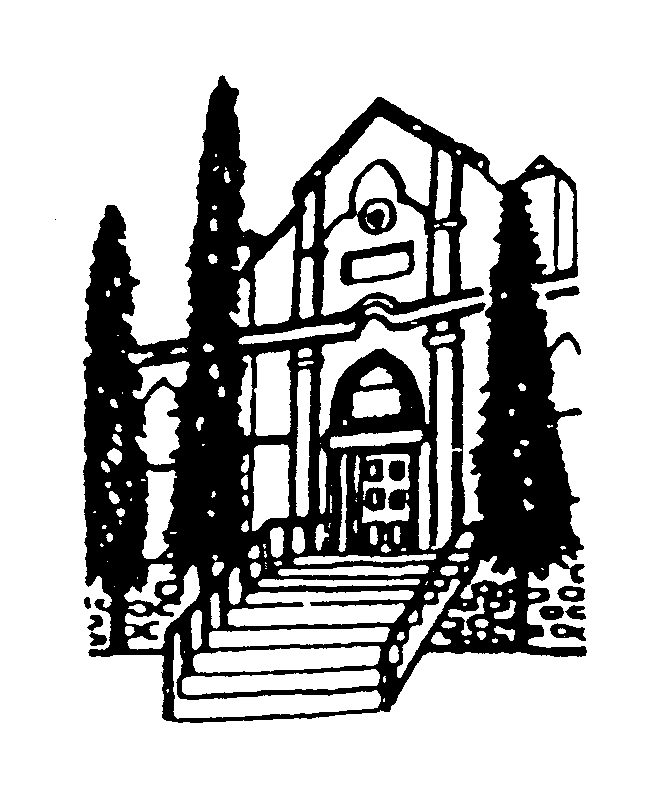
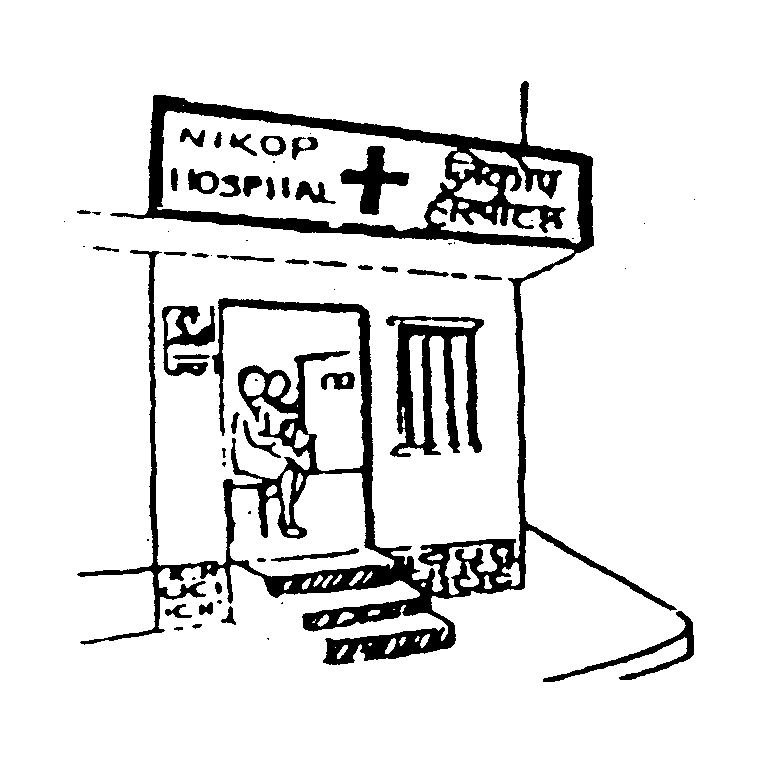

Government Dispensary and Envirouns
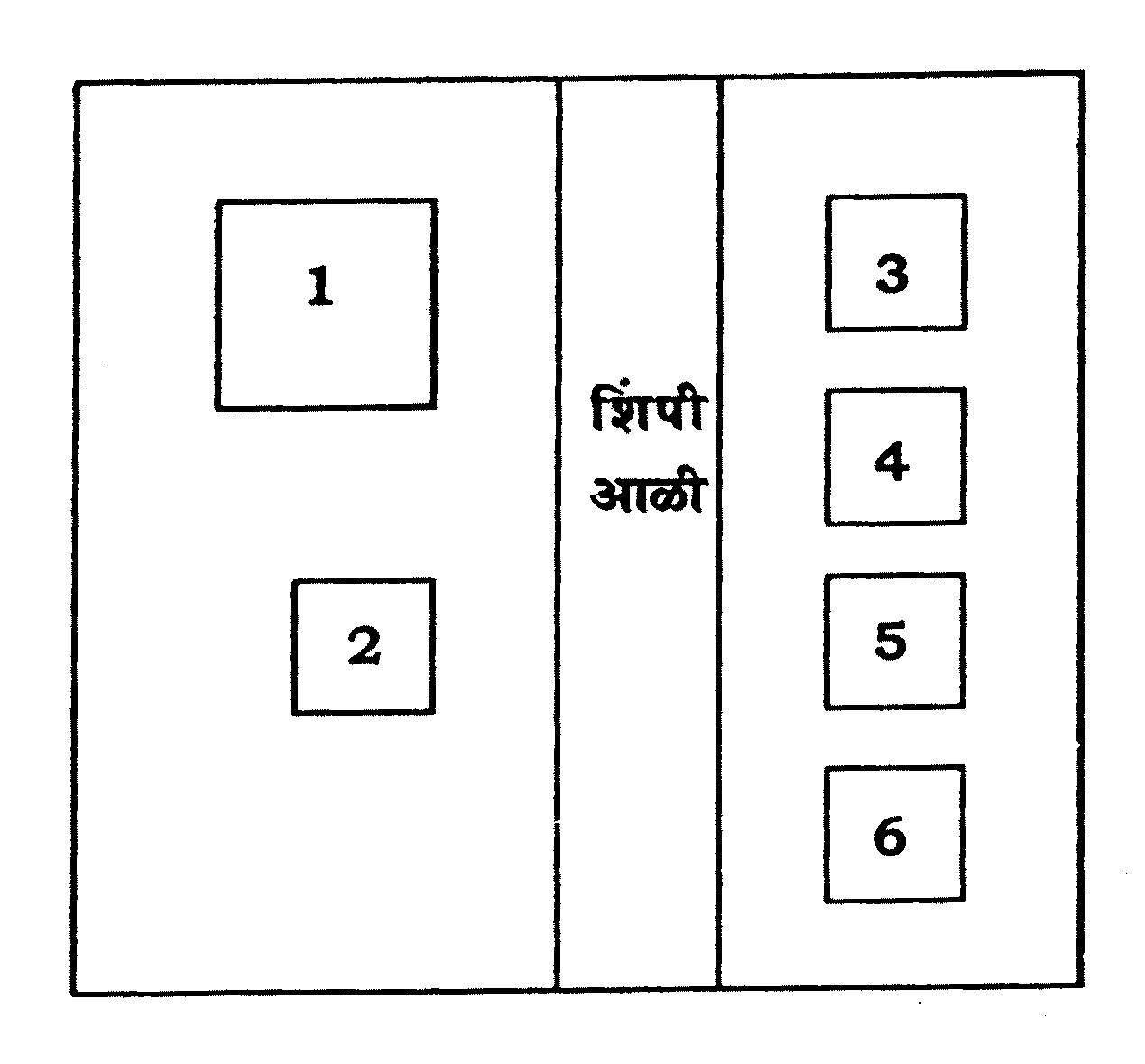
A. Study the map above and say whether each of the following statements is true
(
B. Ask each other the location of the various places on the map. Make sure first to establish your reference point.
VOCABULARY
Nouns
m. S. T. (State Transport) bus depot
Names
Adjectives
-
Adverbs and postpositions
-
-
-
-
-
-
Phrases
WORD STUDY
1.
2. Businesses, institutions and public spaces in Maharashtra (and throughout India) have various types of names. Many, of course, are named after great men or women (e.g., Shivaji, Ambedkar, Rani of Jhansi) or local figures. Other are named after gods, figures from mythology, or family members. Many names, like 'Super Market,' are pure English. Lanes often bear the name of the caste cluster whose members predominate in the neighborhood (e.g., Shimpi Ali, Brahman Ali).
CULTURAL NOTES
1. Shivaji was a seventeenth-century Maratha leader who organized resistance
against the Moghul rulers and established an independent Maratha Kingdom. He
was crowned king
2. Dr. Bhimrao Ramji ('Babasaheb') Ambedkar (1891-1956) was born a Mahar, a member of Maharashtra's major Scheduled Caste. An erudite man (Doctor of Laws from Columbia University and Barrister at Law from London) and a dynamic leader, Ambedkar led the fight against Untouchability. He was the founder of the Republican Party of India and the main architect of the Indian constitution. Before his death in 1956 Ambedkar rejected Hinduism and embraced Buddhism. Since then, millions of his followers have become Buddhists.
31. How Do You Get To The High School?
An American student asks for directions in Phaltan.
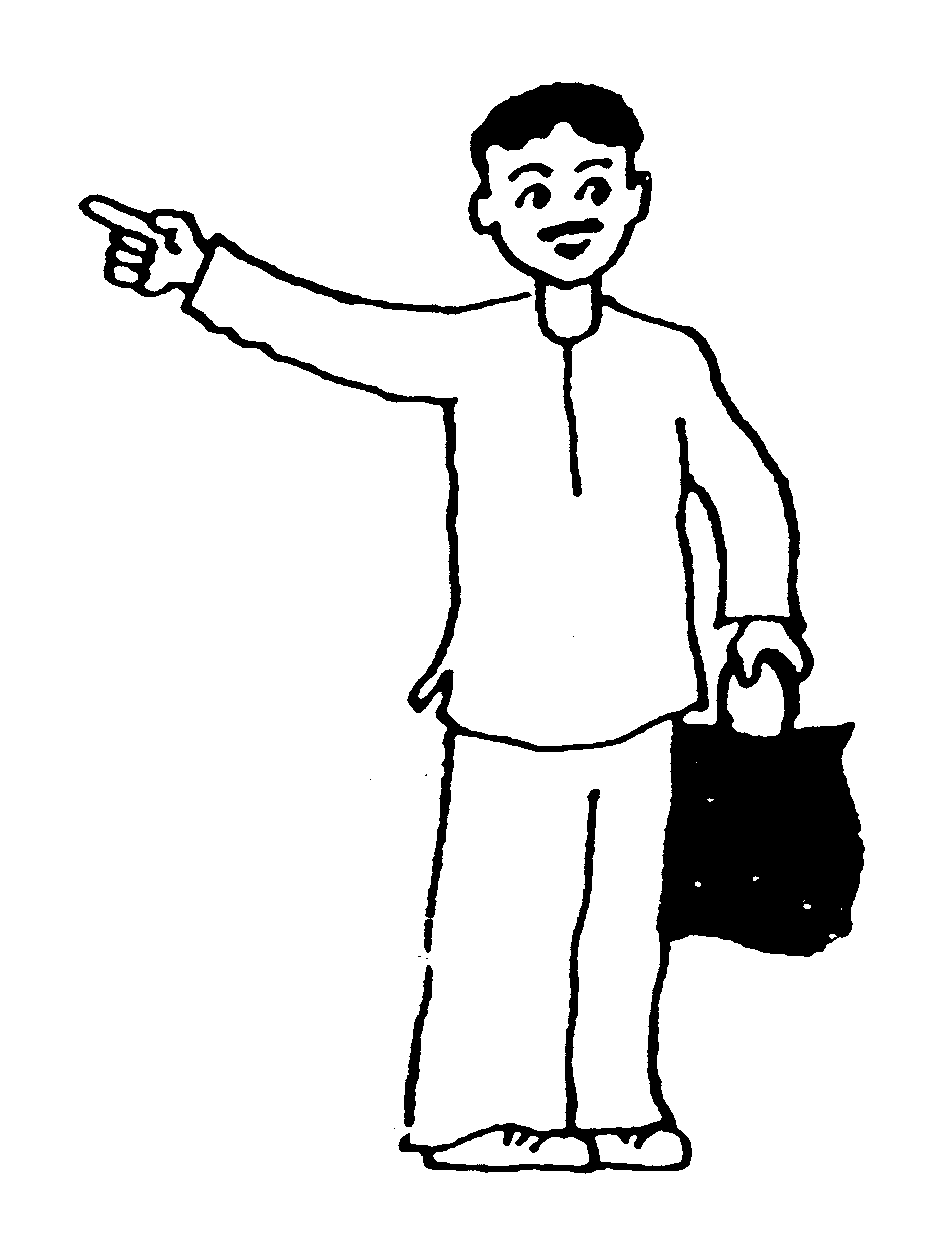
Variations
| Turn right and go to the next intersection. | |
| You will see the building on the left / right hand side. |
The student asks how to get to various places.
| A: | How do you get to the post office? | |
| M: | Go straight along this road up to the vegetables market. Turn left there and go straight ahead. You will see the post office on the left. | |
| A: | I want to go to the State bank. Where is it? | |
| M: | You see the Ambedkar statue, don't you? Go on straight ahead past that. You will see the State Bank of the left. | |
| A: | I want to see the Jnaneshwar temple. How do you get there? | |
| M: | It's behind the State Bank. Next to the bank there's a path. Go to the back from there. |
Landmarks
In finding way around an Indian town or city you will often discover that an address is not of much use, particularly in the older area of town. People generally describe locations in terms of landmarks such as temples, movie theaters, gas stations, or trees.
| opposite the temple of the goddess | |
| next to the Alka Talkies | |
| near the Gogate Gas Station | |
| up to the banyan / peepul tree |
A. Using the map in the previous chapter, ask each other how to get to various places. Make sure to establish a reference point first from which to start.
B. Using a map of your local campus or town (or, weather permitting, going outside!) ask each other to get to various places.
VOCABULARY
Nouns
Verbs
Adjective
Names
Adverbs and postpositions
-
-
-
Phrases
GRAMMAR NOTES
1. In the majority of sentences we have encountered so far, we find that aside from word order and morphology, the Marathi and English sentences are closely parallel. If the Marathi sentence has an intransitive verb, the English sentence usually does too. If the Marathi sentence has subject, object, verb, the English sentence has subject, verb, object. There is, however, a large class of Marathi constructions which pattern very differently from their nearest English equivalents. These are constructions where the native speaker of English expects a person to be the agent of the action, but the person is instead the receiver of the action.
| You will see a stone building. |
A literal translation of the sentence above would be 'a stone building will appear.'
(The form
Another impersonal construction is found in the following sentences.
| I want to go to the State Bank. | |
| I want to see the Jnaneshwar temple. |
It is difficult to give a literal translation of these sentences. The first might be awkwardly rendered as 'to me going to the State Bank is wanted.' Note that the person 'I' is the indirect object of the action rather than the agent.
The impersonal construction in its purest form can be seen in the sentences below.
| How does one go to the post office? |
Note that the Marathi sentence makes no reference to a person at all, while in the English translation we feel compelled to use a personal agent 'one' or, more informally, 'you.' A speaker of Indian English might translate this sentence as 'How to go to the post office?
2. This chapter contains a number of sentences with the verb form
| Turn left and go to the next intersection. |
The form
| Go inside and look [and come back.] | |
| I'll go inside and look [and come back.] |
CULTURAL NOTE
Jnaneshwar was a thirteenth-century saint poet. His Jnaneshwari, a poetic translation and commentry on the Bhagavad Gita, is a major landmark of Marathi literature.
32. Do You Want To Go For Your Bath?
Jon's host 'mother' asks if he wants to go for his bath.
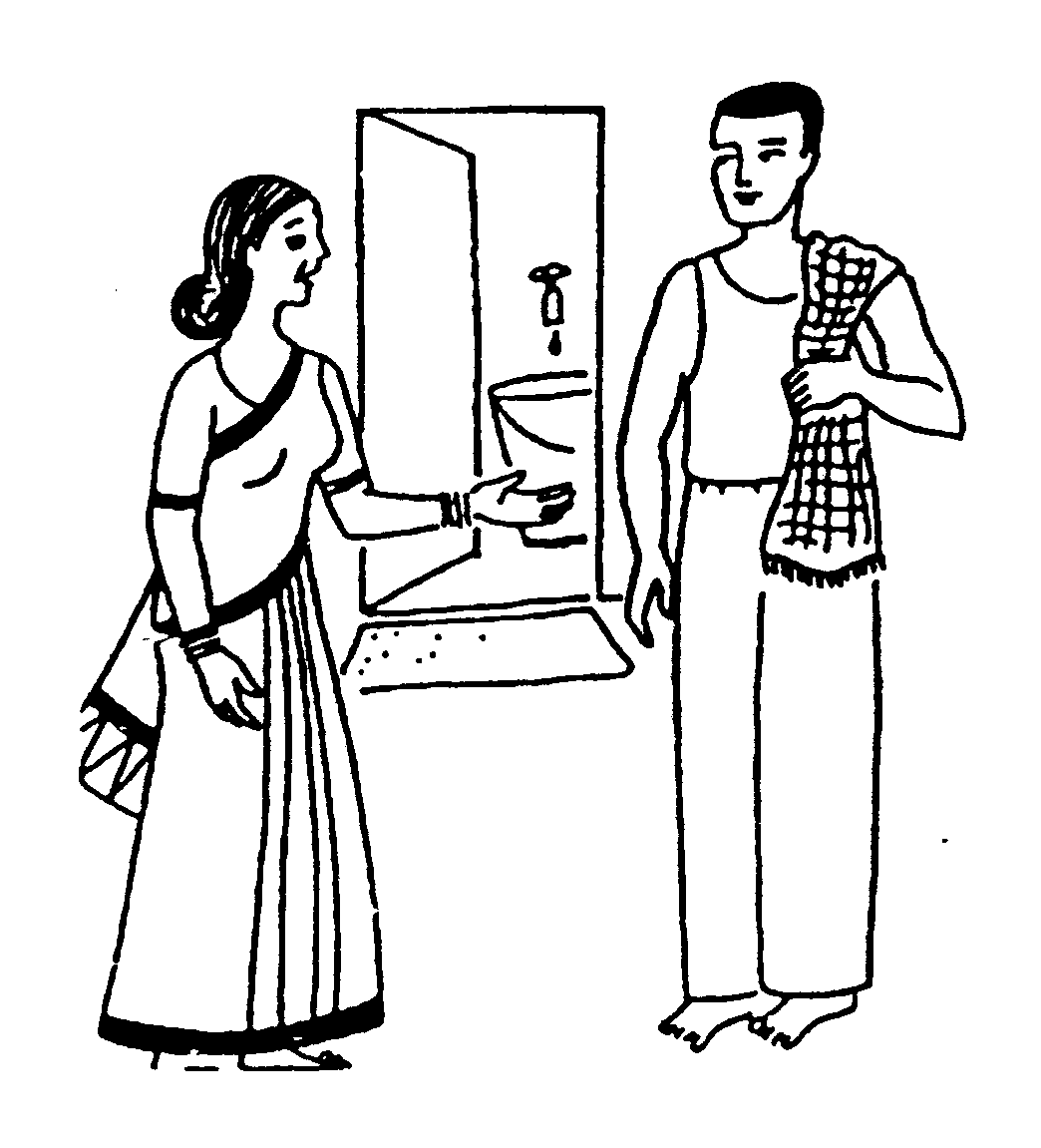
Variation
| The water is hot. Will you go for a bath now? | |
| I'm studying. Would it be OK if I went a little later? |
Sophie asks her host 'mother' if she can go for a bath.
| S: | Have you had your bath? | |
| M: | Yes, I have. | |
| S: | Is it OK if I go now? | |
| M: | Yes, go ahead. But do it fast ['finish up quickly']. Father also wants to go for his bath. |
Variations
| I want to go to college early today. May | |
| I go for a bath right away? | |
| Wait a little while. After father has had his bath you can go ['you go']. |
Bill asks his host 'mother' if the bath water is hot.
| Is the water hot? | |
| No, it will still take another five or ten minutes. |
Role-play these situations, improvising your own conversation.
A guest arrives in the evening after a long journey. The hostess offers to direct him / her to the bathroom.
| H: | You probably want to go to the bathroom. | |
| G: | Yes, I do. Where is it? | |
| H: | Go inside. The first door on the right is the bathroom. | |
| G: | Thank you. |
Variations
| 1. | H : | Do you want to go to the bathroom? | |
| G : | No, thank you. | ||
| 2. | G : | Where is the bathroom? | |
| H : | The first door on the right. |
The hostess explains that the toilet is an Indian-style one.
| H : | Our toilet is an Indian-style one. Will that be OK with you? | |
| G: | Yes, of course! I'm used to it ['I have the habit']. |
The hostess asks the guest if s / he would like to have a bath.
| H : | Do you want to take a bath? | |
| G : | No, I'll just wash up ['was my hands and feet']. |
1. Role-play the situation of a host or hostess receiving a guest, directing her / him to the bathroom and asking if s / he wants to take a bath.
2. Assuming that you are a guest who has arrived in the evening, respond to the following.
a :
b :
c :
d :
Using the Bathroom and Toilet
In regard to bathroom and toilet there are considerable differences between rural and urban and between the poor and the better-off. The facilities described here are typical of middle and upper middle-class urban houses.
There is general agreement about one thing: the necessity of having a bath every morning. Note that the bath must be in the morning. If for some reason (such as having come back from a journey) you want to take a bath in the evening, that is usually acceptable. But it will still be expected that the person will bathe again the next morning. In short, the significance of a bath goes beyond its purely utilitarian function.
Sanitary facilities. Typically, the toilet and bathrooms are in separate adjoining rooms, with a wash basin outside. This enables three people to use the facilities at the same time - an arrangement which makes good sense since the household normally has only one set of facilities for the family and guests. As many households have a fairly large number of people all wanting to use the toilet and bathroom at approximately the same time, there is usually an unstated protocol as to who goes when. A guest should be sensitive to this, and should ask when s / he can bathe without inconveniencing anyone.
Toilet: The Indian-style toilet
Note that the common idiom used (especially by women) to express 'going to the
bathroom' (i.e., using the toilet) is based on the phrase
Bathroom: The actual bathroom in a Maharashtrian house however is just that - a room for taking a bath. In most urban houses it also doubles as a laundry. The bathroom typically is a plain room, with flooring of stone flags or ceremic tiles, a floor drain, a water tap (sometimes with a shower arrangement). Today most homes have an electric water heater.
When going for a bath take your own towel, soap and shampoo to the bathroom. In many houses people also take fresh clothes so that they can dress in the bathroom as there is limited privacy for dressing elsewhere.
To take a bath in the traditional way you fill a bucket with warm water and sit in
front of it on a
In most households clothes to be washed are left in a bucket in the bathroom. You should ask about the arrangements in your host family and should leave clothes for washing only with the permission of your host mother. In any case, you should wash your own handkerchiefs and underclothes.
VOCABULARY
Nouns
Verbs
Adjective and Adverbs
Phrases
33. Grammar
A) N ADV AUX CONSTRUCTION
This unit introduces adverbs and adverbial phrases of place. The majority of the examples used are of the form N Adv Aux, 'N (be) Adv.'
| The vegetable market is here. | |
| The post office is near the vegetable market. |
The interrogative adverb of place (most commonly,
| Where is the vegetable market? |
As in most constructions, in the answer to a question the subject may be omitted when it is understood.
B) PSOTPOSITIONAL PHRASES
In the N Adv Aux construction, the position of the adverb is frequently filled by a phrase consisting of a noun or a pronoun with an attached postposition. (A postposition is a relational word like an English preposition; as the terms imply, a preposition precedes the noun it relates to, while a postposition follow it.) Before the addition of a postposition, pronouns and most nouns have to be changed into what is called the oblique form.
The rules for the formation of the oblique, like those for the plural, are complicated by the fact the Marathi has three genders, each of which has several typical noun endings. In this book we will not present these rules in detail, but will confine ourselves to a few rules which will be particularly useful. Students interested in getting a comprehensive explanation of the rules of the oblique may consult the Marathi Reference Grammar. For most students it is probably advisable to get a feel of phrase structure by learning each phrase as a unit. Keep in mind that if you make mistakes in the oblique form not that much harm is done. The important thing to remember is that the postposition comes after the noun or pronoun it relates to.
C) FORMATION OF THE OBLIQUE
The rules below apply only to the formation of the oblique of singular nouns.
Marked masculine and feminine nouns. The rules for formation of the oblique of marked nouns are as follow:*
| Masculine | → | ||
| Feminine | → | no change | |
| Neuter | → |
Examples
| on the road | |||
| in the lane | |||
| in the pan |
Masculine and neuter nouns ending in a consonant. The oblique singular of
masculine and neuter nouns ending in a consonant is formed by adding
| on the bridge | |||
| up to the tree |
Feminine nouns ending in
| in school |
Augmented oblique form. In some cases - especially if the postpostion has several
syllables - the oblique form of the possessive pronoun
| next to the bank | |
| on this side of the bridge | |
| beyond the bridge |
Oblique form of adjectives. A variable adjective (including a possessive adjective or a
demonstrative pronoun) modifying a noun in the oblique must also be in the
oblique. The oblique form of an adjective or demonstrative pronoun is formed by
changing the final vowel to
| near my house | ||
| up to the banyan tree | ||
| in that intersection | ||
| in this hotel |
D) ADV N AUX CONSTRUCTION
If instead of following the noun, the adverb is put at the beginning of the construction (Adv N Aux) there is a slight, but significant change of meaning. The latter construction means 'There (be) N Aux.'
| Is there a high school on the map? | |
| Is there a river in the town? |
Sometimes the adverbial phrase is not expressed, but is understood from the context.
| Is there a mosque? |
In the context the phrase
PATTERN PRACTICE
A. Using the words below, ask questions of the pattern ...
B. Repeat the exercise, having a second student give any appropriate answer:
C. Using the words below, ask questions of the pattern
D. Repeat the exercise above, having a second student answer,
E. Respond to the following questions using the answer suggested.
Example
near the produce market
behind the produce market
next to the post office
facing the government dispensary
near the government dispensary
at the Ambedkar intersection
F. For each item a noun is given, along with its oblique form, followed by a list of postpositions. Add each postposition to the oblique form of the noun.
-
-
-
-
-
-
-
-
-
-
-
-
-
-
-
-
-
-
-
-
-
-
-
-
-
-
-
-
-
-
-
-
-
-
-
-
-
-
-
-
-
-
-
-
-
-
-
-
-
-
-
-
G. The oblique form is not normally used for place names containing English
words; however, a postposition following such a place name is often augmented
by a preceding
-
-
-
-
-
-
-
-
-
-
-
-
-
-
-
-
-
-
-
-
-
-
H. Translate the following sentences in idiomatic English.
I. Translate the following sentences into Marathi.
1. Where is the college?
2. Where is the high school?
3. Is there a hospital here?
4. Is there an S. T. Depot here?
5. Their house is near the vegetable market.
6. The bank is next to the post office.
7. The shop is on this side of the bridge.
8. The factory is on the other side of the bridge.
9. How do you get to the bus depot?
10. Go to the corner and turn left.
11. Has the water gotten hot yet?
12. I need to go to the bathroom.
BOOK TWO
Preparing new materials to teach Marathi to the ACM students has been a challenging job. In this set of 'Marathi In Context' consisting of three volumes, we have tried to restructure and redesign teaching methodology so as to suit the needs of an ACM student in an initial orientation course as well as during his / her stay in a family in Pune. The new material aims not only at the grammar and structure of Marathi language, but also at the cultural context in which Marathi is used. As a result, the new materials will be very helpful to learn functional Marathi.
I appreciate the version of the ACM authorities who realised the necessity of these books and made a longfelt need come true. I thank them sincerely for making me an active participant of this project in the creation of this, the second book in the series.
My thanks to all the members of the Editorial Committee, who patiently extended their support from time to time. My special thanks are due to Ms. Elizabeth Hayford, Dr. Cathy Benton, Mr. S V. Patankar, Ms. Meena Chandavarkar, Dr. Maxine Berntsen, Dr. Philip Engblom and Dr. Neeti Badwe. I also thank Mr. Milton Eder and Ms. Sunita Nene for their co-operation.
Ninad Mate, Gauri Mate and Rajashree Sadhu of Akshachhaya have been professionally excellent and personally very kind. Without their efforts this book wouldn't have seen the light of the day. Mr. S.S. Bokil's illustrations have given an additional touch of perfection to the typeset.
I dedicate this book to all those earnest students of Marathi who have and will continue to inspire me to teach Marathi as a second language.
Sucheta Paranjpe
Unit One
Planning Free Time, Planning Work
1. Shall we go for an Outing?
Meera, Rekha, Nandini, and Leena are talking about the weekend.
| Rekha, what are you going to do this Sunday? | ||
| It's not certain, but probably I will go to a movie. Will you come? | ||
| No, not a movie. Shall we go for an outing? | ||
| Hey, that's a wonderful idea. Where shall we go? | ||
| Let's go to Sinhgad. | ||
| I will ask Mother. She won't say no. | ||
| How should we go? By bus? | ||
| Yes. But let's climb a bit. It will be fun. |
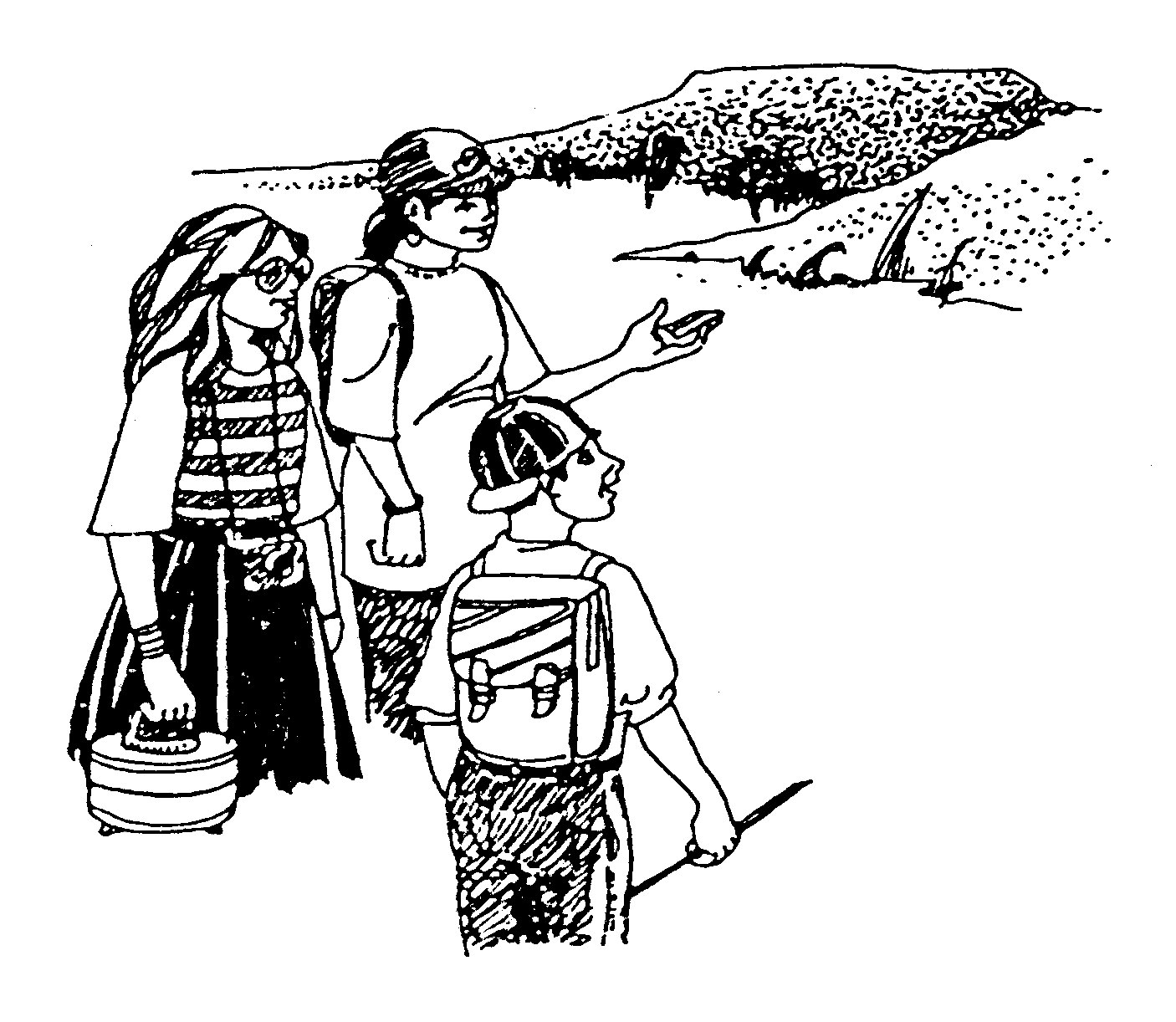
Variations
| 1. | Sampada, will you come to Sinhgad with us? | |
| No, I cannot make it. | ||
| 2. | Shall we go to Sinhgad? | |
| No, it's a long way up ['very high']. My feet will hurt. | ||
| 3. | What are you going to do on Sunday? | |
| Nothing. I am going to relax all day long. |
VOCABULARY
Nouns
Pronouns
Verbs
Adjectives
Adverbs
Proper Names
WORD STUDY
 CULTURAL NOTE
CULTURAL NOTE
There are many such forts built by Shivaji on the hills around Pune. Purandar, Raigad and Pratapgad are some of these.
2. Preparation for the Outing
Nandini, Meera, Rekha, and Leena talk over their plans.
| Meera, will you bring Ann along to Sinhagad? | ||
| Of course! She will definitely come. | ||
| And what about food? Shall we take it along? | ||
| Oh yes. I will bring methi-parathas and pickles. | ||
| Shall I bring yogurt-rice and potato-bhaji? | ||
| What shall I bring? | ||
| You bring cucumbers, chivda and candies. I will bring sarbat and ladoos. | ||
| What about water? Shall we take four or five bottles, one for each? | ||
| OK. So, we will meet at the bus-stand at six on Sunday morning. | ||
| What time will we come back? | ||
| We will start by the five o' clock bus in the evening. So that we will be home by seven. | ||
| Good bye, see you on Sunday. |
VOCABULARY
Nouns
Adverbs
Adjectives
Postposition
-
Verbs
Phrase
GRAMMAR NOTES
1.
| Each boy goes to school. | |
| Each girl goes to school. | |
| Each child goes to school. |
As an adjective
2. The verb
A. Have you ever been on an outing in India? Go around the class, each adding items to a list of things you would take along on an outing (in Marathi, of course).
B. Rice (
C. Plan a day trip (
D. Now make sure to take the trip you have planned.
3. Going to Pandharpur
Ann is telling her host mother about her upcoming visit to Pnadharpur.
| Mother, we are going to Pandharpur next week, for ashadhi ekadashi. | ||
| Ok. Who all are coming along? | ||
| All the American students and some of our teachers as well. | ||
| Are you going to see the temple? | ||
| Of course! And we are going to meet the Varkaris too. | ||
| When will you leave? And when will you be back? | ||
| We will leave on Monday morning and will be back Thursday afternoon | ||
| Take care. And give me the phone number at Pandharpur. | ||
| I will give you the number tomorrow. And don't worry. I will call you from there. |
VOCABULARY
Nouns
Vithal
Adjectives
Postposition
-
Verbs

Varkaris are pilgrims that belong to the Bhagwat sect. They are devotees of Lord
Vithoba - also known as Vithal - whose main temple is in Pandharpur, a town about
200 kms south-east of Pune. Every year, in the month of Ashadh according to the
Hindu calendar - which falls roughly in the latter half of June - the Varkaris walk from
Dehu or Alandi, both places near Pune, to Pandharpur. They bring the
This is a very important religious and cultural event in the social life of Maharashtra.
Dr. Gunther Sontheimer has made a very informative documentary film entitled 'Vari'.
A Marathi book on the Vari entitled
Answer the question
E.g.,
4. Making an Appointment
| Prof. Desai, will you be home this Sunday afternoon? | ||
| No, I won't be home in the afternoon. But I will be home until eleven o'clock. | ||
| I don't think I can make it in the morning. | ||
| Can you make it on Monday afternoon? | ||
| But your children will be home then. | ||
| No, the children won't be (home) then. They will be in school. | ||
| OK. Then I'll come by three o'clock. Is that OK? | ||
| Yes. The children will come back at five o'clock. That means we will be able to read for two hours. | ||
| Thank you, Madam. |
Variations
| 1. | I have a little work with you. May I come to meet you tomorrow? | |
| Tomorrow? I have a lot of things to do tomorrow. Will day after tomorrow work? | ||
| Yes. I'll come day after tomorrow then. | ||
| 2. | Are you free next week? The whole of next week I'm busy at a seminar. |
VOCABULARY
Nouns
Adjectives
Postposition
-
Proper names
WORD STUDY
The postposition -
| Grandma goes walking as far as the temple everyday. | |
| He'll be in Mumbai up till Friday. | |
| The Marathi class will go on up till next month. | |
| Mother went as far as the station by rickshaw. | |
| I'll come by three in the afternoon. | |
| I'll be home until eleven o'clock. |
Answer the following questions.
5. Ann's Research Project
 Ann likes sociology a lot. In India, she is going to do special research on the topic
`The working [`earning'] woman'. Dr. Desai will be her guide. She will visit many
institutions with Ann. Ann will prepare a questionnaire and give it to a hundred
working women. Those women will write the answers to the questions. On some
occasions, Ann will also interview the women. She will read books on that topic.
For that, she will go to different libraries. Later, she will put together all the data.
Ann will discuss it with Dr. Desai, get her opinion [thoughts] and will also put
forth her own opinion. Finally, when she has finished her study, she will write an
essay on her research project. Moreover, she will also be able to write a short
article (on it).
Ann likes sociology a lot. In India, she is going to do special research on the topic
`The working [`earning'] woman'. Dr. Desai will be her guide. She will visit many
institutions with Ann. Ann will prepare a questionnaire and give it to a hundred
working women. Those women will write the answers to the questions. On some
occasions, Ann will also interview the women. She will read books on that topic.
For that, she will go to different libraries. Later, she will put together all the data.
Ann will discuss it with Dr. Desai, get her opinion [thoughts] and will also put
forth her own opinion. Finally, when she has finished her study, she will write an
essay on her research project. Moreover, she will also be able to write a short
article (on it).
VOCABULARY
Nouns
Pronouns
Verbs
Adjectives
Adverbs
Postpositions
-
Conjunctions
Phrases
WORD STUDY
1.
| He himself went to the market. | |
| She is talking to herself. | |
| Is this your own house? | |
| Prof. Joshi does not talk much about himself. |
2. The verb
| We will be able to read for two hours. | |
| I can speak Marathi. | |
| Will you be able to come early tomorrow? | |
| Will you be able to do this work for me? | |
| He could not go to Mumbai. |
3. In reference to conversing with someone, the posposition -
| She will have a discussion about it with Dr. Desai. | |
| I'm going to talk to him. |
A. Translate the following into English.
B. Translate the following into Marathi.
1. Prof. Bhosale can teach Marathi and Hindi.
2. Arun himself went to the store.
3. Will you interview your history teacher tomorrow?
4. His friend is not able to cook.
5. She went to the library.
C. Make sentences using the following:
D. Using the vocabulary given in this chapter, write a short essay on the subject
"
6. Subjects, Classes and Teachers

VOCABULARY
Nouns
Verbs
Adjectives
Adverbs
Proper Names
WORD STUDY
1.
| The math class will be not meet tomorrow. | |
| May I sit in the history class? | |
| We like the Marathi class. |
2.
Thus we would say,
| Prof. Deshpande teaches very well. | |
| At what time is Prof. Kulkarni going to come? | |
| Tomorrow Prof. Shinde is going to have an extra geography class. |
A female teacher is referred to as either
Thus we would say,
| Prof. Paranjpe teaches us Sanskrit. | |
| What subject does. Prof. Joshi teach? | |
| At what time will Prof. Sabnis meet us? |
3.
| I am going to start my studying now. | |
| The rain began to fall. |
In both sentences
| Mahesh began his studying. |
When
| Mahesh began to study. |
A. Answer the following questions:
B. Translate the following into Marathi.
1. It started raining.
2. When will the baby start to walk?
3. When will you start studying?
4. Prof. Ms. Kale is going to start driving a car.
5. The American students started speaking good Marathi.
7. Grammar
A) REVIEWING THE PROSPECTIVE
You have already been introduced to the prospective in Book 1, Unit 6. The formula for
the prospective is N V -
Here is a full paradigm for verb
| Person | Singular | Plural |
| 1 | ||
| 2 | ||
| 3 |
Bear in mind that when used in speech the auxiliary is significantly shortened, in
that the
B) THE FUTURE TENSE
The prospective is used for talking about an action felt as imminent or definite. Future action can also be expressed by using the future tense. This form is more neutral, lacking the sense of immediacy and definiteness conveyed by the prospective.
| What will you do? |
Note that the English 'going to V' and 'will V' contrast in practically the same way. In the present unit you have encountered numerous examples of the future tense.
Formation of the future tense. You may wonder why we term the prospective an
'aspect' but the future a 'tense'. The reason is that an aspectual construction
consists of a verbal base, plus an aspectual marker (e.g.,
The formula for the future is N V-Efut where Efut stands for the set of future endings in Table 11.
Table 11. Future endings
| Person | Singular | Plural |
| 1 | ||
| 2 | ||
| 3 |
Note that there are no gender distinctions in the paradigm. The only variation is in
the first and third person singular where there is a choice of endings with
1) Bases using
Base ending in a vowel :
Base ending in
Transitive verb :
2) Bases using
Intransitive verb ending in consonant :
Special transitive verb
Negative. The future tense has no corresponding negative form (except for the auxiliary). To negate a sentence in the future one must use the negative form of the prospective.
Thus,
Here is a full paradigm of both prospective negative and future negative for the
verb
| Person | Singular | Plural |
| 1 | ||
| 2 | ||
| 3 |
C) FUTURE TENSE OF THE AUXILIARY
The auxiliary verbs
Use. Like the present and past tenses of the auxiliary the future tense can be used both as an independent verb and as a constituent in other verbal constructions. Here we shall confine ourselves to its use as an independent verb.
The future tense of the auxiliary has two different, though obviously related meanings. Most basically, it indicates futurity: 'I will be', 'you will be', etc.
| Will you be home tomorrow afternoon? | |
| When will you have time? |
In addition to this ordinary connotation, the future forms of the verb
| Where's mother? | |
| I don't know. May be she's in the kitchen. | |
| Is this book yours? | |
| No, it's probably Ram's. | |
| How old do you suppose he is? | |
| Who knows! I think he must be over seventy. |
In all these sentences, the verb form
PATTERN PRACTICE
A. Conjugate these verbs in the prospective.
B. Answer the question
C. Answer the question
D. Use the suggested subject and give the prospective with auxiliary
E. Answer the questions.
F. Translate into English.
G. Translate into Marathi.
1. Meera is going to come by plane.
2. Tomorrow I am going to wear that sari.
3. Now he is going to write an essay.
4. It is going to rain today.
5. Are you going to eat that chutney?
H. Give the future paradigm of the following verbs.
I. Use the suggested subjects and give the proper future forms of the verbs.
J. Translate the following into English.
K. Translate the following into Marathi.
1. Ann will write an essay.
2. Bhaskar will go to Mumbai today.
3. Next month, Deshpande will go to America.
4. Ram will bring the vegetables.
5. They will get a new car.
L. Make negative.
M. Change the following into negatives.
N. Translate the following into Marathi
1. The book will probably be on the table.
2. Probably there will be no money with Suhas.
3. I think the shop may be closed today.
4. Who is she?
I don't know. May be she is Ajay's mother.
5. Where is grandmother?
I don't know. May be she is in the garden.
End Game
See this magic square where, whether we read the words horizontally or vertically,
we get the same two words
 The trick is simple. Write a word horizontally to fill sq.1 and 2. Then write the
same word vertically to fill sq. 1 and 3. Now think of a letter which will make a
word along with the letter in sqs. 2 and 3 and write that in sq. 4.
The trick is simple. Write a word horizontally to fill sq.1 and 2. Then write the
same word vertically to fill sq. 1 and 3. Now think of a letter which will make a
word along with the letter in sqs. 2 and 3 and write that in sq. 4.
Here are a few examples. Try to think of a letter for the blank square.
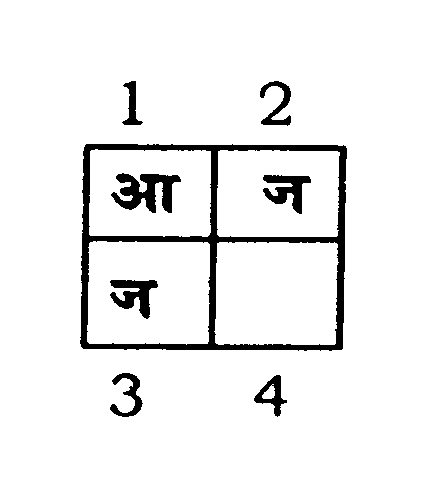 Here is a magic cube on the same principles.
Here is a magic cube on the same principles.
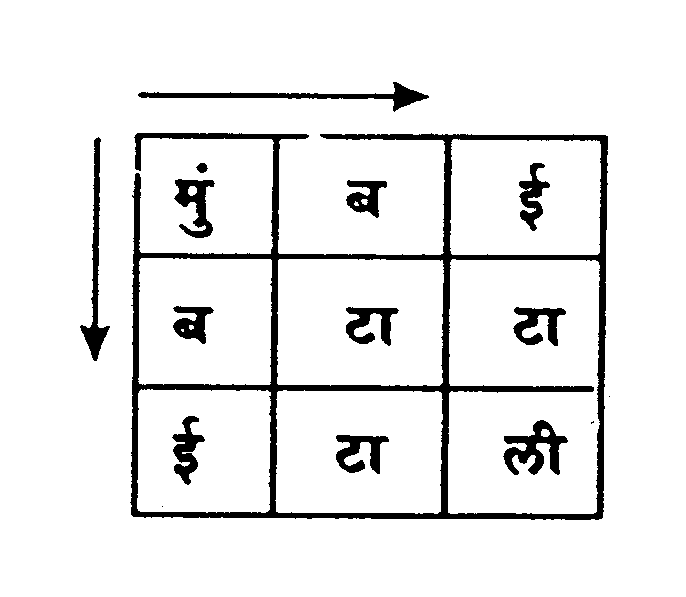 Can you form such a magic cube?
Can you form such a magic cube?
Unit Two
What Hurts, What Comforts
8. An Accident
Meera came home in the evening. She sat down on a chair after taking off her chappals. Ann and Mahesh arrived ten minutes later.
Meera, Meera, Oh! | |
Ann, what's the matter? ['What happened?'] Aren't you feeling well? | |
I am O.K. But, there in front of that store there was an accident ... My God! | |
There was a big crowd. A small boy came by on a bicycle. A woman was riding a scooter just ahead of him. |

Yes, and then? | |
That woman suddenly turned to the right. | |
My God! Did the boy crash then? | |
Oh yes. He and his bicycle fell down and the scooter fell too. | |
Did anyone get hurt? | |
I think that boy was hurt. His hand was bleeding. But even so he didn't cry! | |
Then people ran (to that place) and took him to a dispensary in a rickshaw. | |
That was good. And what about that woman? ['What of that woman's'] | |
She got up and went off. | |
Lots of accidents happen because of the heavy traffic. | |
Lack of discipline is another reason. Accidents happen because of that too. | |
Yea, that's true. |
VOCABULARY
Nouns
Pronouns
Verbs
Adverbs
Postpositions
-
-
-
-
-
Conjunction
Interjection
Proper Names
Phrases
WORD STUDY
1.
Oh my, what a big snake!
Oh my, this is very expensive.
Oh my, what a terrific saree!
My God, my head is aching something fierce!
2. The verb
In this context, the verb
Mahesh was badly hurt.
There was an accident, but no one at all got hurt.
His hand was hurt. It even bled.
3. In the sentence
A. Answer the following questions about 'An Accident'.
B. Most of the verb-forms in this chapter are in the perfect, with endings like